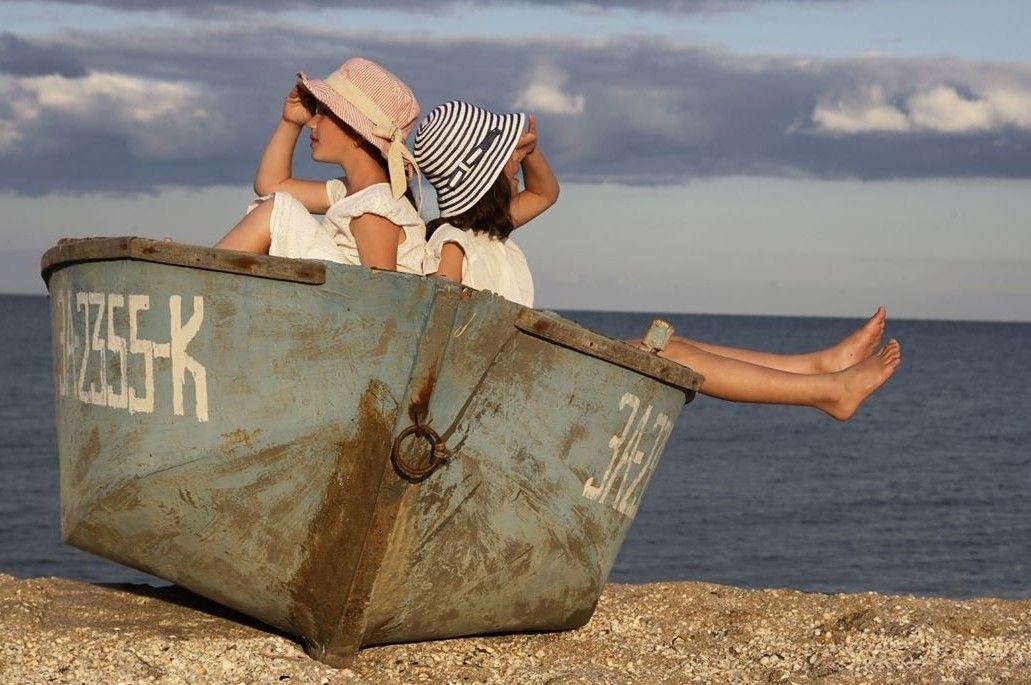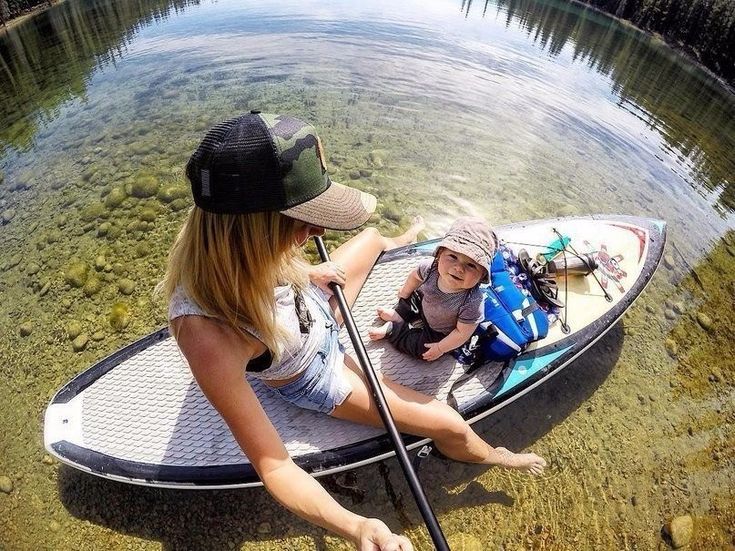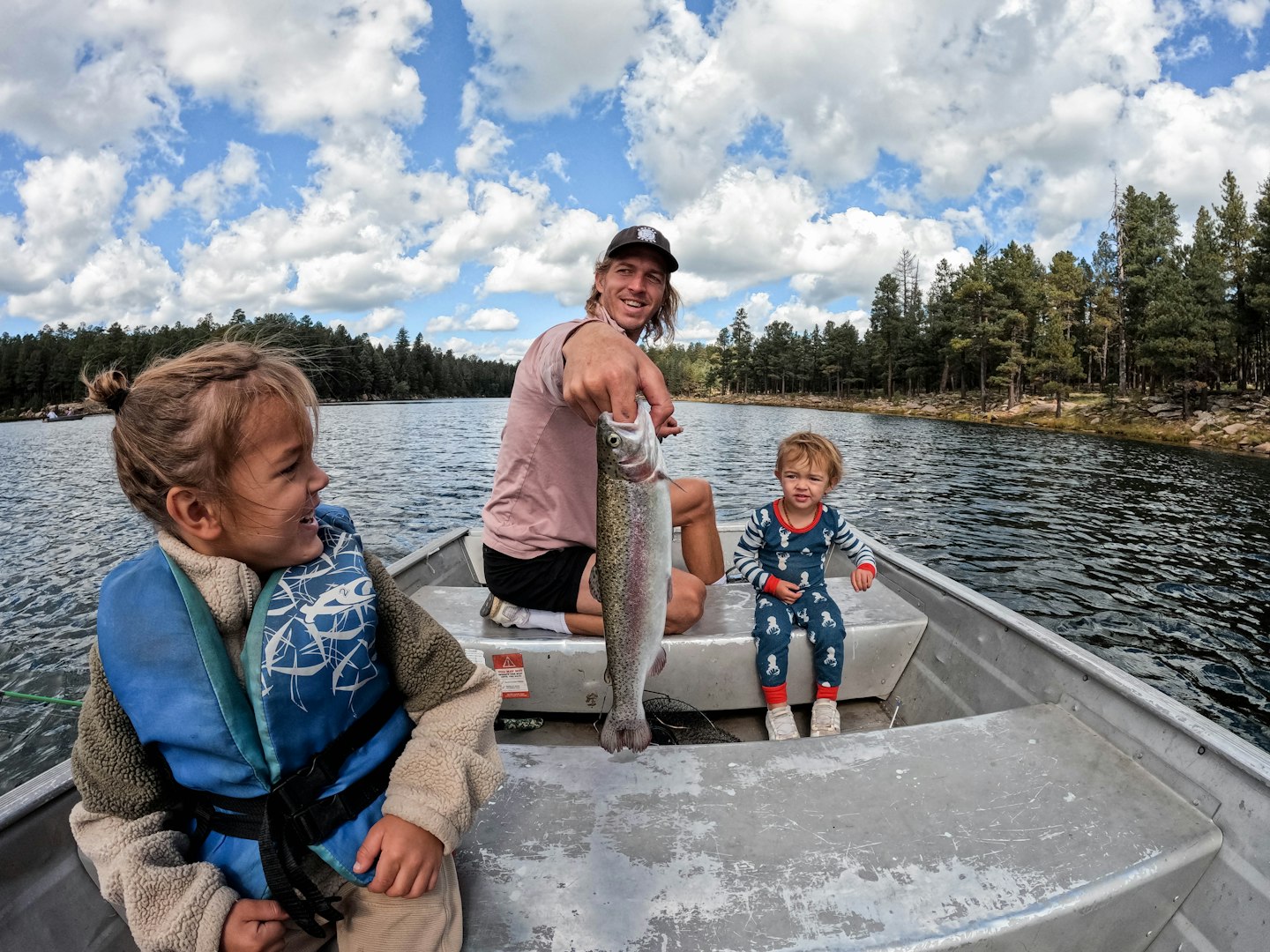Superscript
Discovering Fun At Lakes, Ponds, and other slow moving Water
Lakes as Sensory Discovery Zones
for Little Explorers
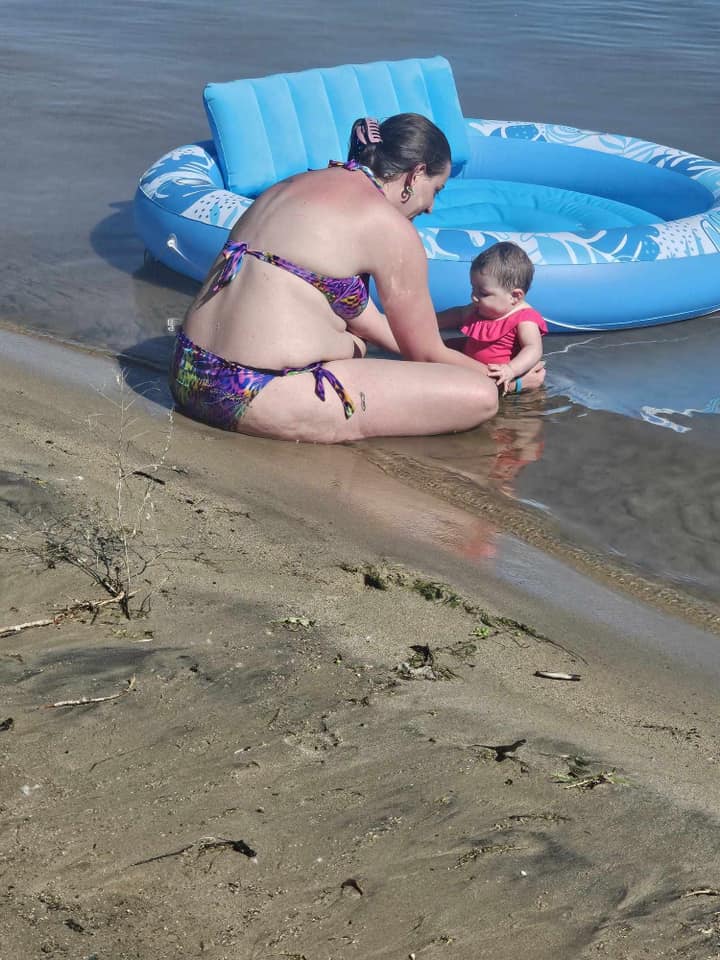
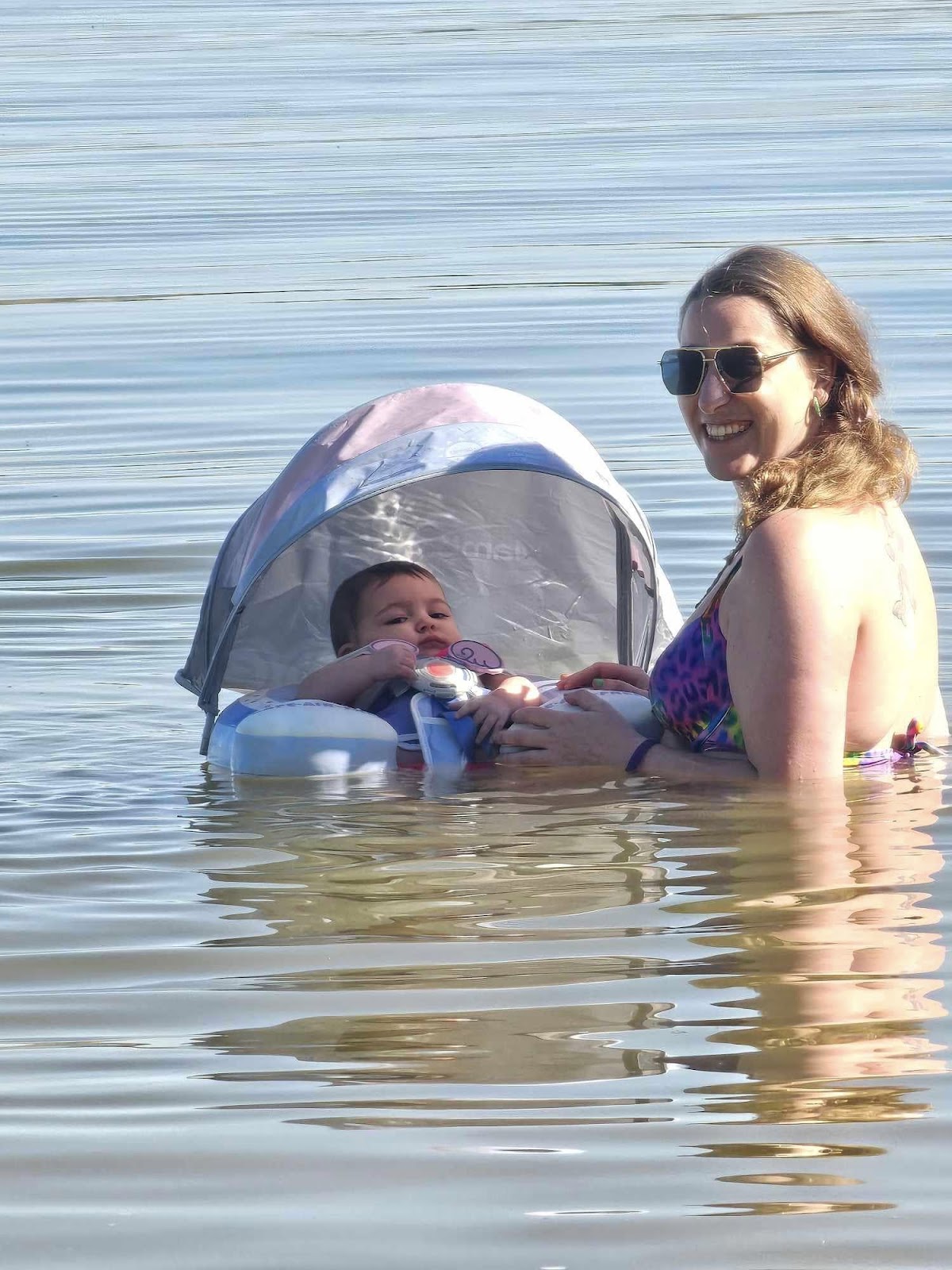
Dive into the enchanting world of Lakes, those unassuming puddles of magic just waiting to spark curiosity in young explorers! Weather it’s the gentle ripple of water or the adorable frogs performing their slimy ballet, Lakes offer a sensory feast that will leave your little ones giggling in delight. Forget flashy gadgets and swell tech toys; the great outdoors is a tactile treasure trove that ignites imagination and discovery—right in your backyard! Join us as we unveil the joy of lake exploration,where every splash is a new adventure and every squishy creature is an educator in disguise.
Get ready to wade in and make memories that are just as vibrant as the dragonflies darting overhead!
How To Have A Safe Lake Trip With Your Baby
Purchase an infant PFD (personal floatation device)
Safeguard against dehydration
Avoid Peak Sun Exposure
Find a location with shade
Protect their skin when in the sun
Protect their eyes
There are so many fun ways to help kids develop a love for exploring rivers and lakes. Kids who love the water may want a full sensory experience through learning activities. But there are also opportunities to be had while staying dry. Rivers are animportant part of the water cycleand act as drainage channels for the Earth's land surface. They also carry water and nutrients, providing food and drink for animals.
While for us, they additionally provide transportation routes for exploration and recreation. All this makes them prime learning resources for kids. Contrast these learning activities to those about the oceans of the worldto further the understanding!
How to purchase an infant PFD (personal floatation device)
A popular lake day activity is boating. While babies are able to board, they too must follow the state laws. Most states require that everyone on board have a PFD. The Stingray Infant PFD is a great choice because it is US coast guard approved and uses bright colors so your baby is easily visible. In addition to these necessary features, this life jacket is made from a durable and quick-drying Nylon fabric with quick-release buckles.
Even if you don’t have plans to boat, it’s best for a baby to wear a PFD anytime they are in the water.
Lifejackets- Babies under 35 pounds are not big enough for a baby lifejacket. They can die from suffocation when they slip inside the lifepreserver without you knowing. Your best protection is to wear your baby.
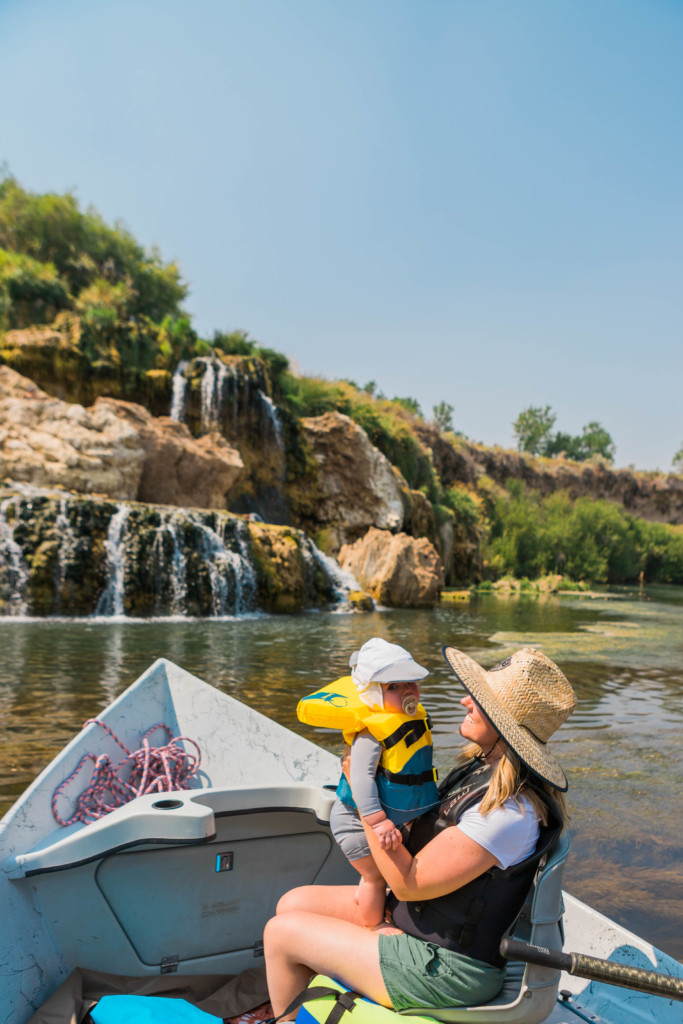
Safeguard against dehydration
During a hot day, it’s easy for adults to dehydrate quickly. This is even more true with infants. Come prepared with extra bottles or plan to nurse more frequently if currently breastfeeding. If your baby has reached the age where they can start eating solids, consider bringing a couple of servings of food that are travel-friendly. A great example of this is fruit/veggie pouches.
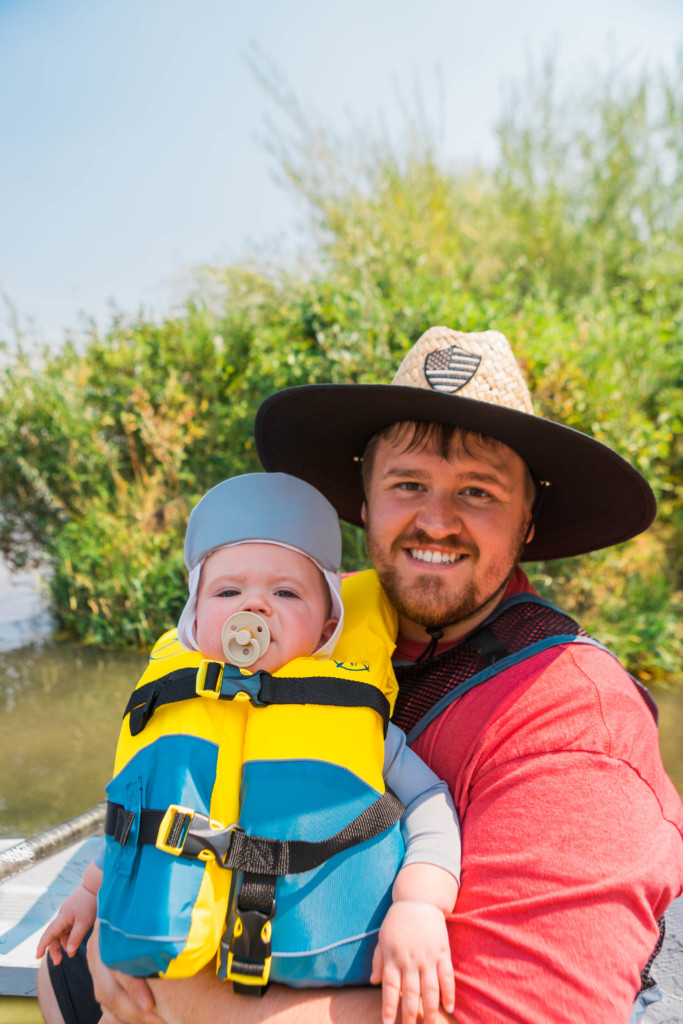

Read more- How To Successfully Vacation In Ft. Lauderdale, Florida With A Baby
Avoid Peak Sun Exposure
A lake day might look a little different with an infant because of the fact that you’ll want to avoid peak sun exposure. These hours generally fall between 11 a.m. and 4 p.m. Getting an early or late start to the day might also be a great way to beat the crowds! If you can’t avoid these harsh, daylight hours, read below for some additional tips.
Find a location with shade (or take shade tents)
One of the first things you’ll want to do when getting to the lake is finding a great spot with plenty of shade. No sunbathing for the baby! In addition to finding natural shade given by trees, feel free to bring a sun canopy or umbrella that has UPF protection. Trust us, keeping cool not only protects their delicate skin, but it will help with their mood!
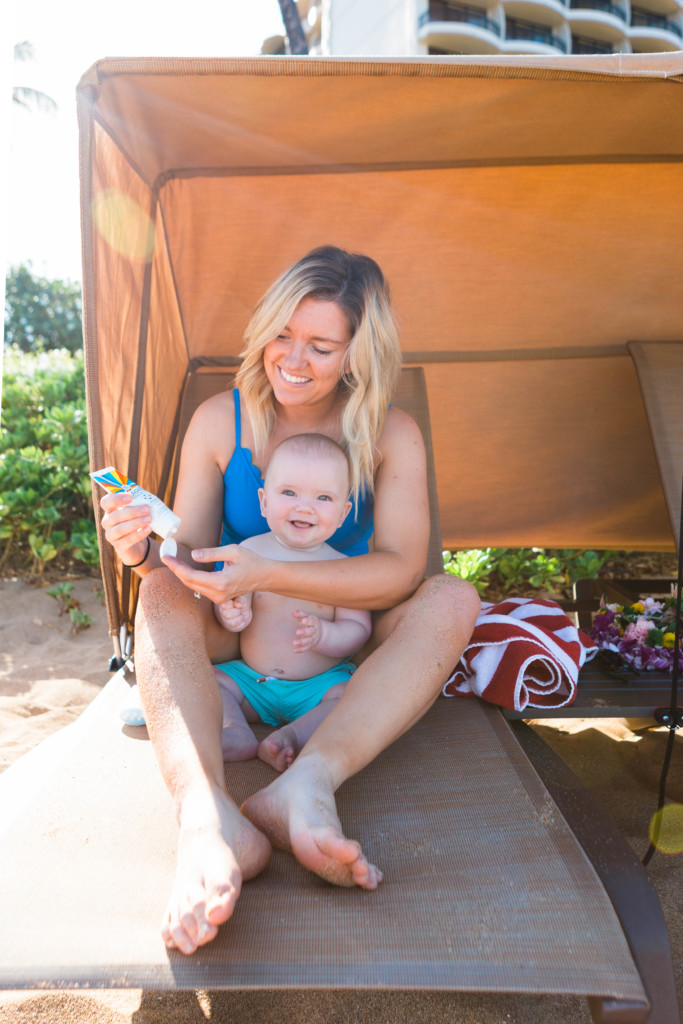
Protect their skin when in the sun
You probably don’t want to hide out in the shade all day at the lake. This is when you need to be especially careful about sun exposure. The US FDA recommends avoiding sunscreen for infants that are under the age of 6 months. Choose UPF clothing that covers them as much as possible. In addition, always keep a sun hat on your baby that protects not only the tops of their heads but the back of the neck and ears.
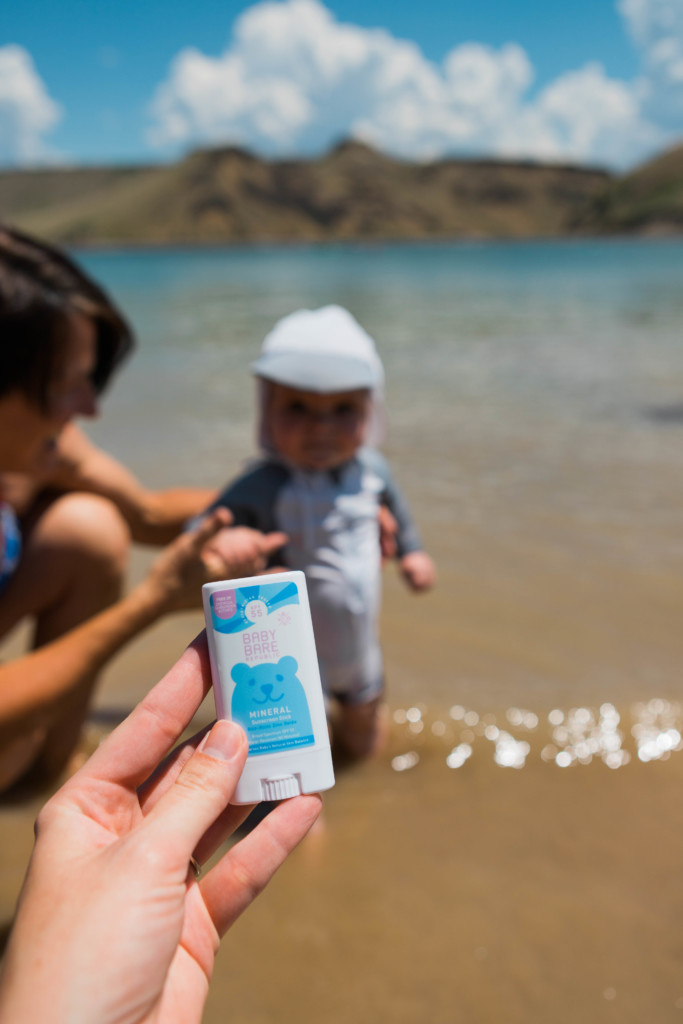
Read more- Baby Travel Essentials For 0-12 Month-Old Babies That Will Save Your Vacation
Protect their eyes
While baby sunglasses don’t seem to be the most practical item to bring to the lake, they can be very helpful! Recent reports have suggested that babies’ eyes lack the ability to block UV rays to the same degree that grown adults can. These may be foreign for a baby to wear so practice several days before getting your baby used to feeling them on.
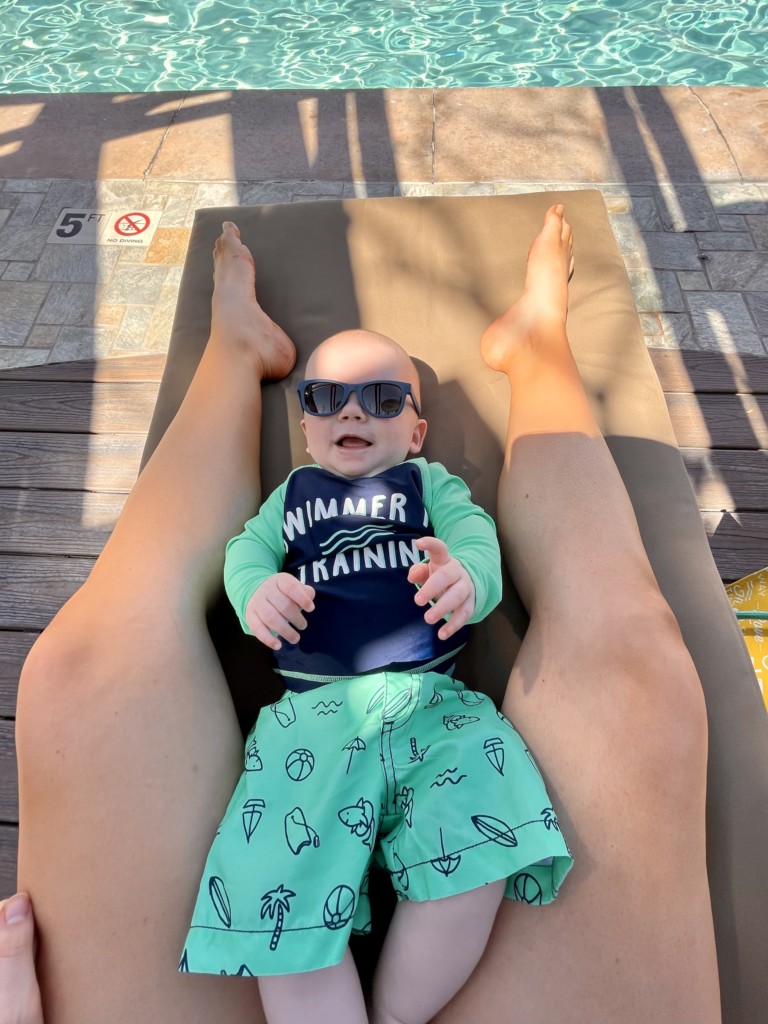
Wind Direction Watcher
Build this wind direction watcher and you'll be able to see the wind blow!
What You'll Need:
Piece of cardboard
Marker
Tape
Small mirror
Compass
Swoooosh! There goes the wind ... and now you can see it!
Step 1: Mark out north, south, east, and west on the outside edge of a piece of cardboard. Include other directions, like northeast, if you like.
Step 2: Tape a small mirror to the cardboard so that the compass directions form a circle around the mirror. Now you're ready to chase the wind!
Step 3: Place your cloud chaser on the ground so it faces north. You can do this by matching north on your cloud chaser with north on your compass.
Step 4: Lie next to your cloud chaser and watch the reflection of the clouds in the mirror. Once you see which way the clouds are moving, you'll know that's the same direction that the wind is blowing.The next activity is sure to give your imagination a workout
Wild Waters and Wetlands
Blue water, sun, and sand are but a few of the interesting elements this theme will make sharing with babies and toddlers possible. A beach is a magical place, especially to kids. The glorious sound of waves washing up and whooshing back, the feeling of sand squishing between toes, and sun-kissed skin after spending a day outside exploring are the simple yet beautiful things that can make for the sweetest childhood memories. That’s why I try to get my kids as young as babies to fall as madly in love with the beach as I am.
Before you even leave your house, it is wise to prepare for safety and fun. The more comfortable you and your child are, the more fun you’ll be able to have. If you have a sensory sensitive child, build a mini beach for them to get used to the elements. Then be sure to pack plenty of drinking water, snacks, and sunscreen as well as beach toys, towels, sunglasses, aloe, beach blankets, wide-brimmed hats, and tons of toys. Did we mention the toys? Buckets, shovels, sifters, and even blowing bubbles.
SENSORY PLAY
Babies absolutely love to touch everything – that’s how they experience the world. Be sure to point out all the amazing sensory opportunities for your little one – like digging in the sand, dipping toes in the water, collecting shells and cool rocks and smelling the salty air.
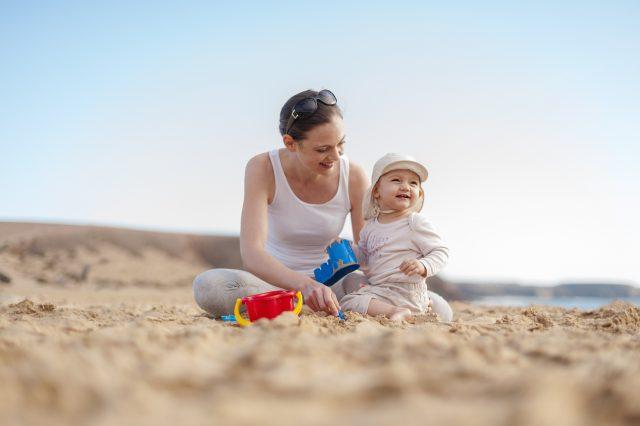
TEACH
The best part about all of that sensory play is the golden opportunity to take advantage your child’s natural curiosity and to teach them things like how the water moves, the nature of the tide and all about ocean life and the cool creatures you’ll find there. Without the distractions of screens and the daily grind to get in the way of your focus, you and your baby will enjoy this special bonding time.
MOVE AT YOUR KID’S PACE
Kids have a natural pace and to really allow them to fall in the love with the beach it is wise to let them lead you through the hours of the day as much as a parent is able to. If your little one just wants to grab the sticky beach sand and watch it fall on his lap then by all means, do that. Treat your child’s focus on nature as the most important thing about that day.
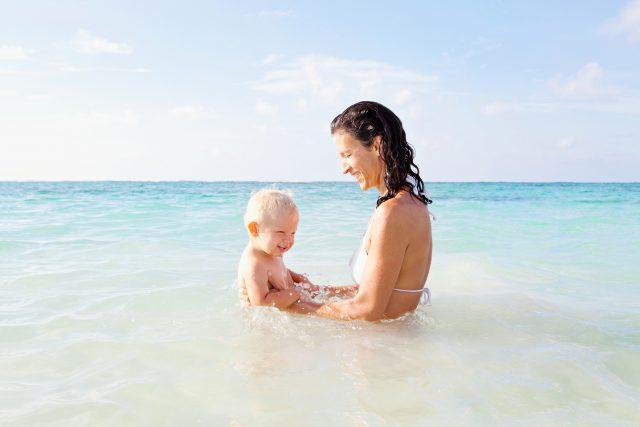
MOVE YOUR BODY
Find ways to move your body and stretch, walk, crawl, swim, float, do whatever you can to make your beach day a physical day too. There is wisdom in getting your blood pumping and your lungs working hard and teaching your child to enjoy the beach as a way to get some movement in is especially wonderful.
MAKE IT SPECIAL
Take pictures, laugh a lot, be slow and playful, do whatever it takes to make you and your baby super happy during beach time. It won’t take much for your little one to fall in love with the truly remarkable beauty of spending a day with family at the beach.
Follow your child’s interest in exploring the lay of the land, and by being open to their natural curiosity, you can definitely help your child to develop a healthy love of not just the beach but of the great outdoors. For more information on water and beach safety, check out these safety tips from The American Red Cross. Be sure to visit your state tourism board website to find the best family friendly beaches near you.
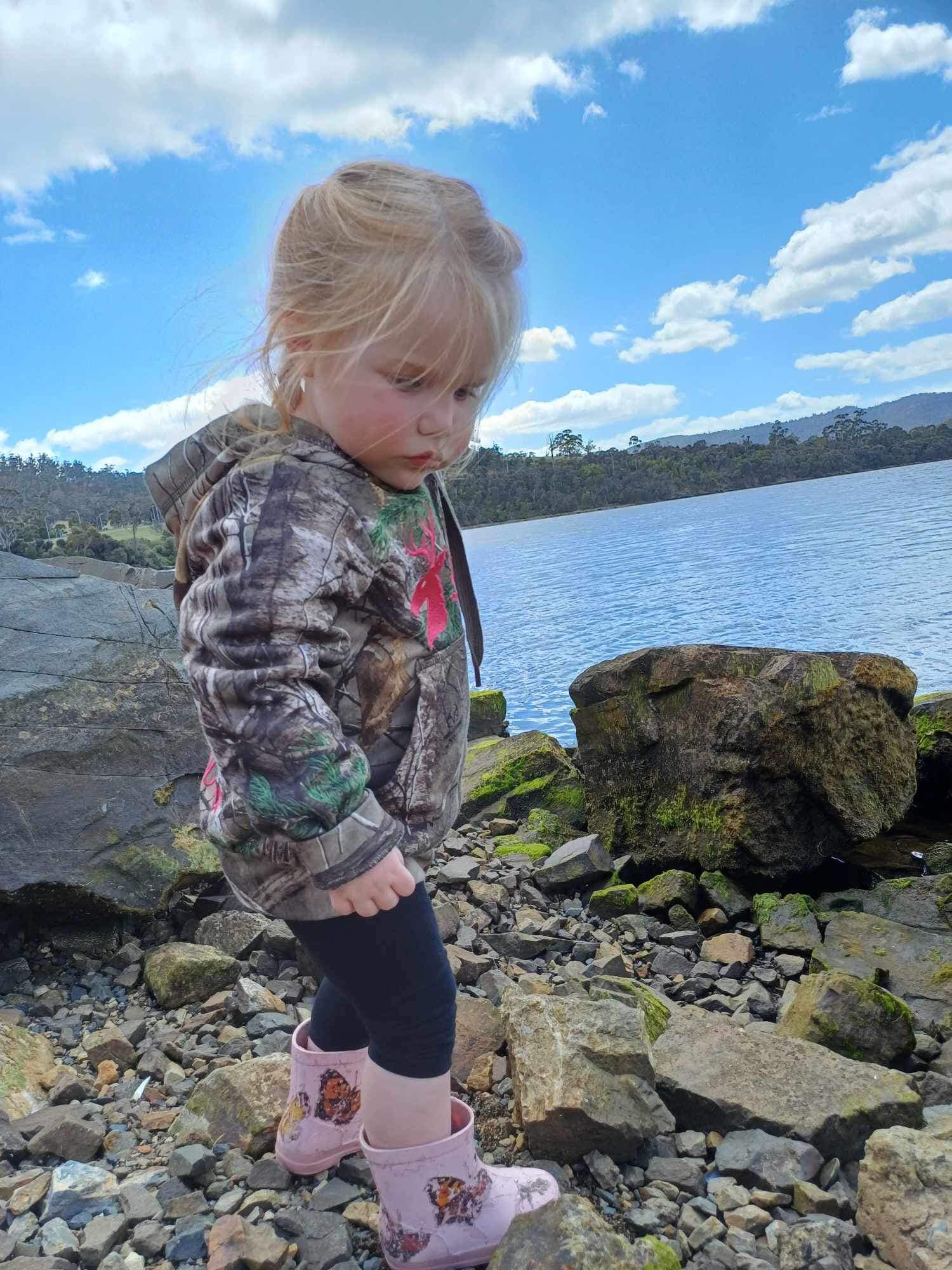
How To Have A Successful Lake Trip
…According To Toddlers
Its the beginning of Summer! All this sunshine has me thinking about our vacation at the lake last year. Every year we get to go down to our Family Cabin and I love every minute of our vacation. Last year was amazing and this summer we will get to be down there for even longer! Three cheers for summer and extended parental leave.
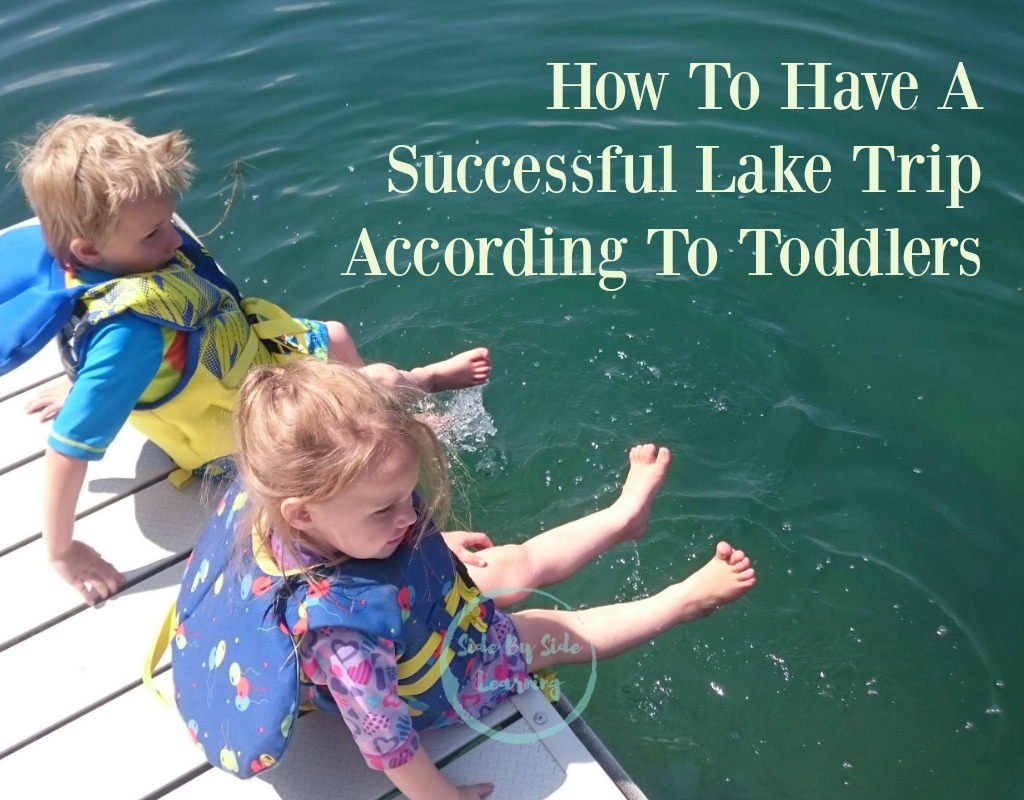
As my kids are getting older they are become quite the adventurers and they use their imagination constantly. While we were at the lake the kids had a blast and we let them enjoy it to the fullest. Here are their tips to insure your kids have the best time ever.
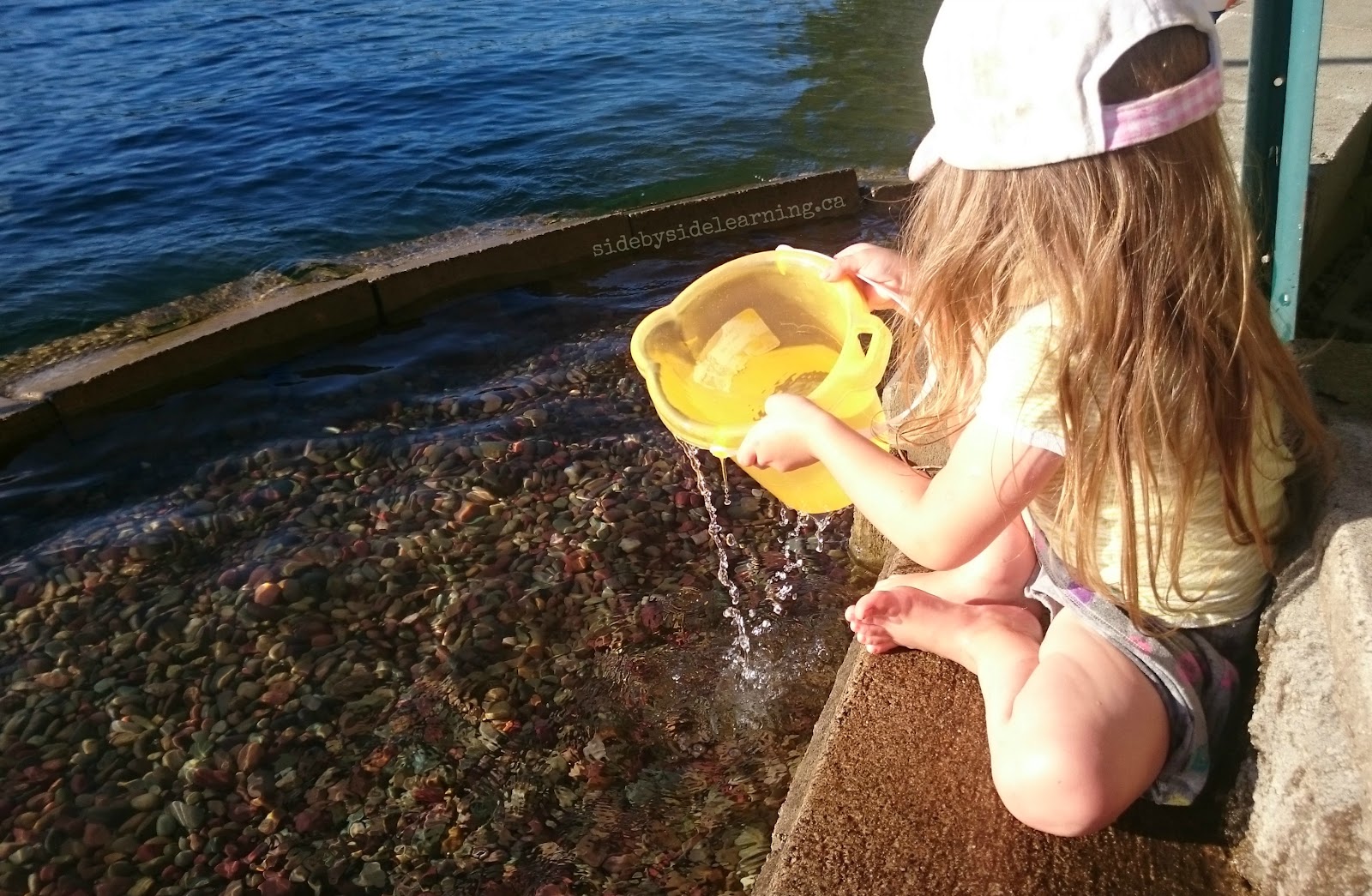
1. Play!!
There is so many new things to explore. If you leave kids to it they will find some excellent ways to entertain themselves.
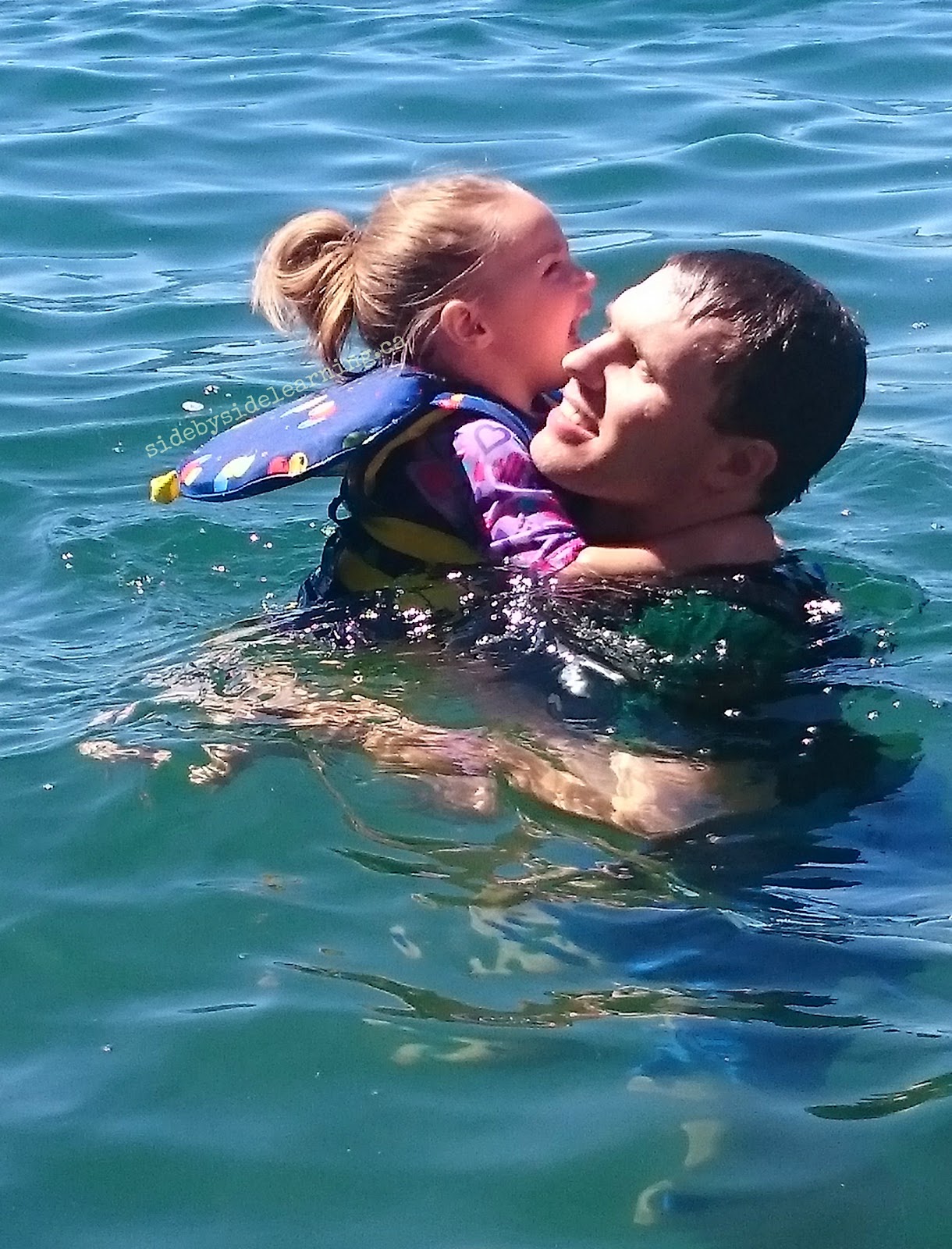
2. Jump In The Lake
Have a blast splashing, tubing, going on the knee board, swimming or collecting the best rocks ever. Whatever you do just get in there.
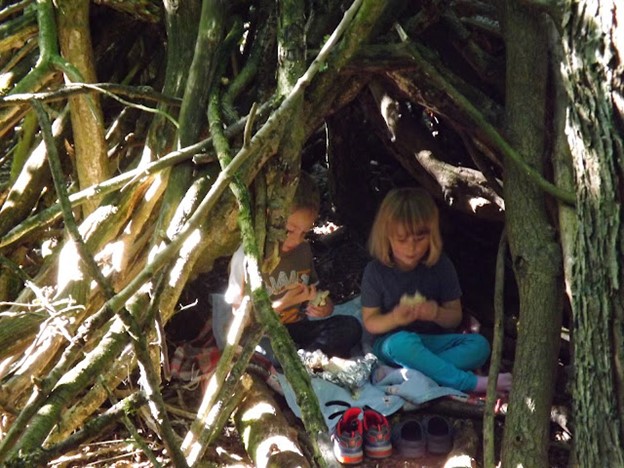
3. Make a clubhouse or fort
We have an old tent trailer that we didn’t set up this year. Instead the kids made it into their awesome club house, no adults allowed. They hauled tons of rocks into the fridge. Collected pine cones for the horses (imaginary) and swept the entrance constantly. I have no idea what else they did but they spent tons of time in the club house.
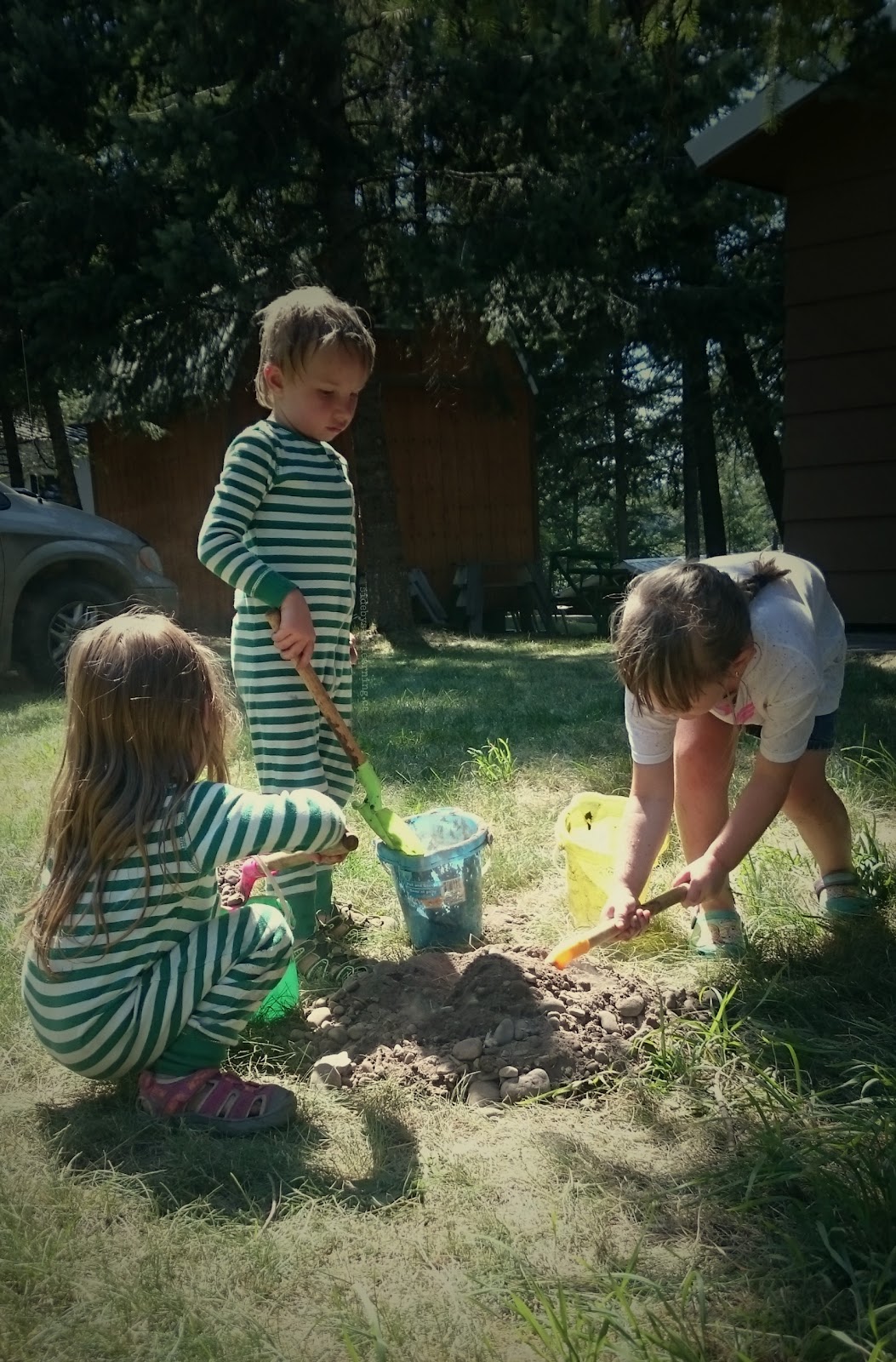
4. Dig in the dirt
Almost every kid that I have ever met loves to dig in the dirt. I don’t really get it but a shovel with a couple of buckets makes for enormous amounts of fun.
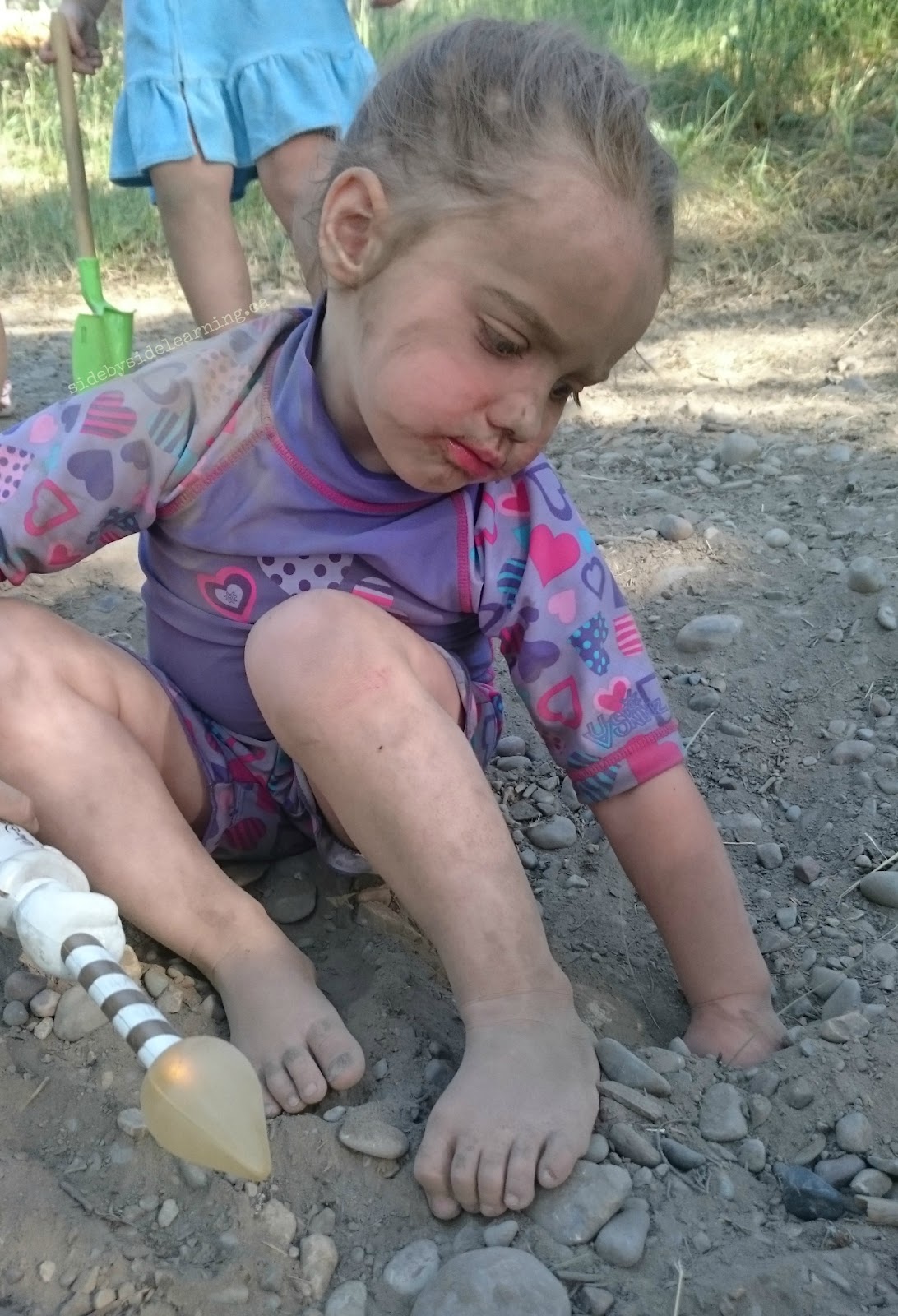
5. Bathe half as often as you should
Sometimes a quick jump in the lake before bed is good enough. Other occasions call for extra soap….
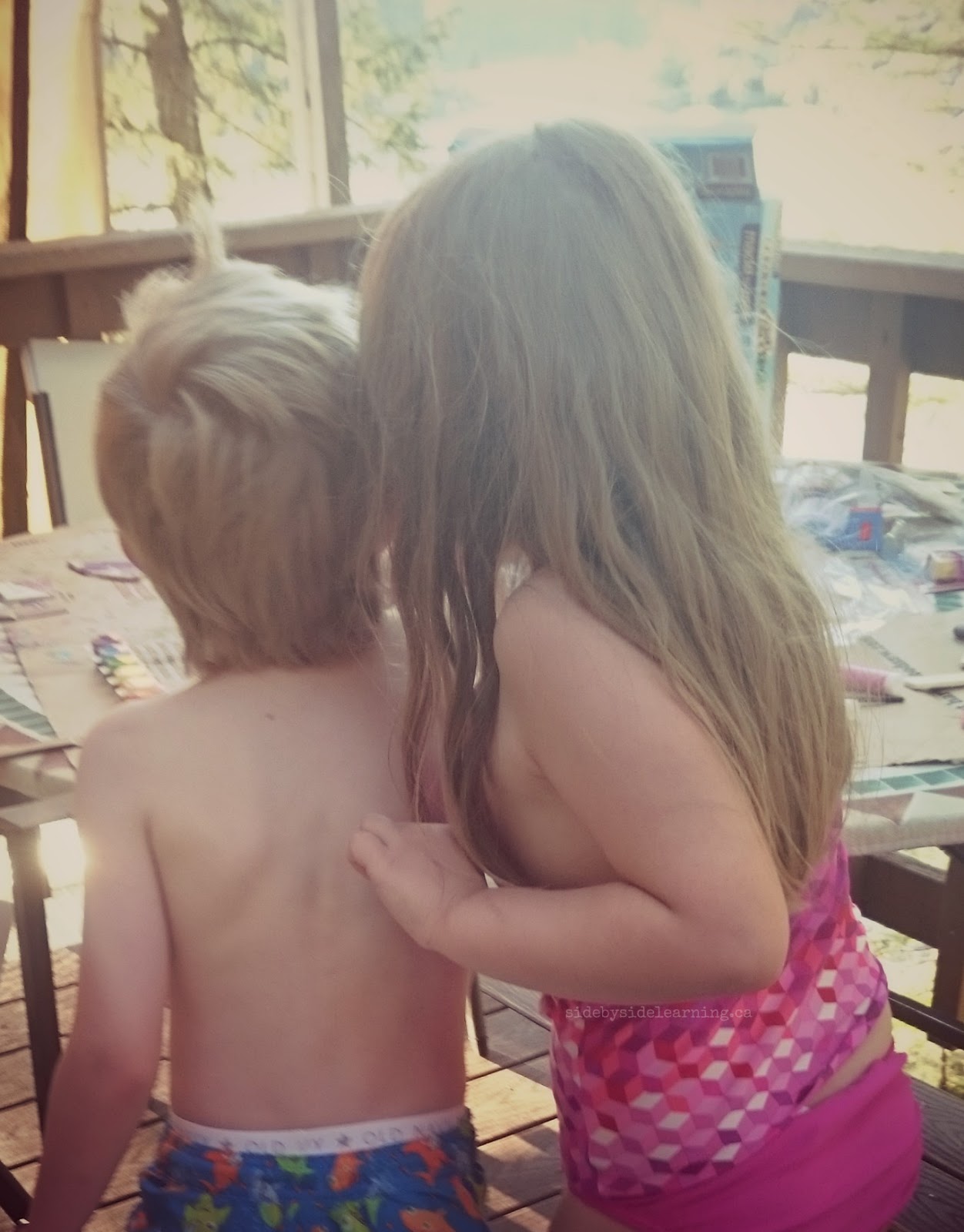
6. Be goofy with cousins
Cousins are the best! I have many fond memories of times with my cousins and we do our best to help our kids have the same opportunity.
They played constantly for the whole week. They got out bubbles, puzzles or activities to fill their time with but more often than not they used their imagination for tons of fun.
7. Stay up hours late
Seriously hours…. At the cabin, time is a whole different thing. We are too busy having fun that the kids don’t even start to settle down til 9 pm. Oy. The kids love staying up late but I always look forward to getting back to our routine. Aka early bedtime.
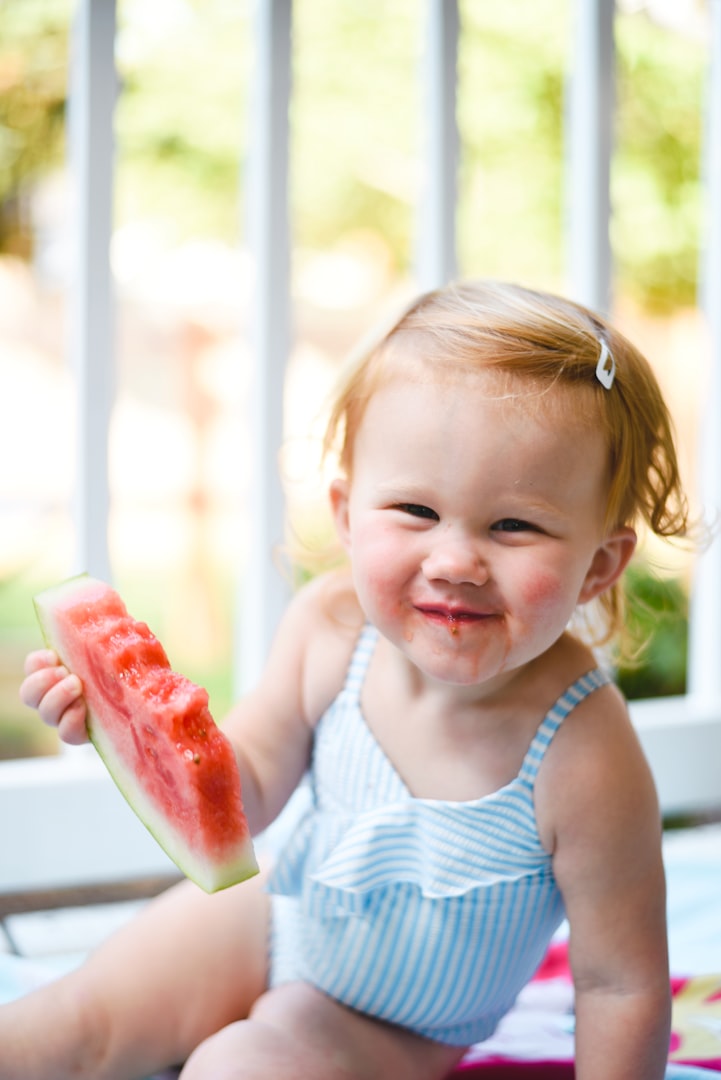
8. Eat too much food
Our entire extended family is filled with amazing cooks which leaves us all stuffing our faces during meal times, snacks and deserts. Tiger especially loved to try and fit all the watermelon in his mouth at once. Often he succeeded. Silly boy.
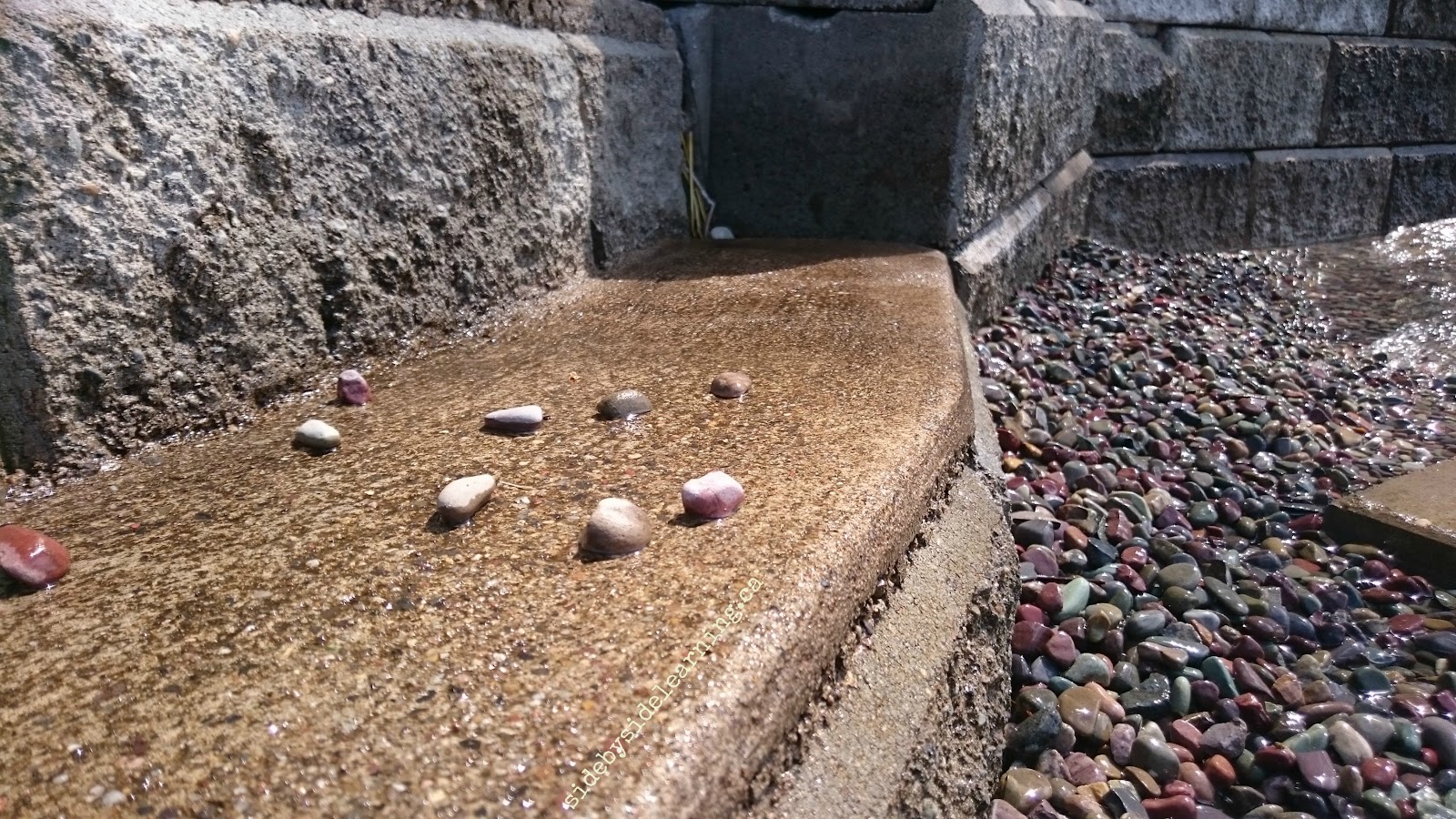
9. Lay traps for adults
.
Rocks make the perfect trap, without shoes on its close to the kids leaving Lego’s scattered around. Sticks work good too but are more easily seen.

10. Go boating
We watched skiers, went in the paddle boats, went behind the boat and the kids even helped drive the boat with Grandpa for some small cruises.
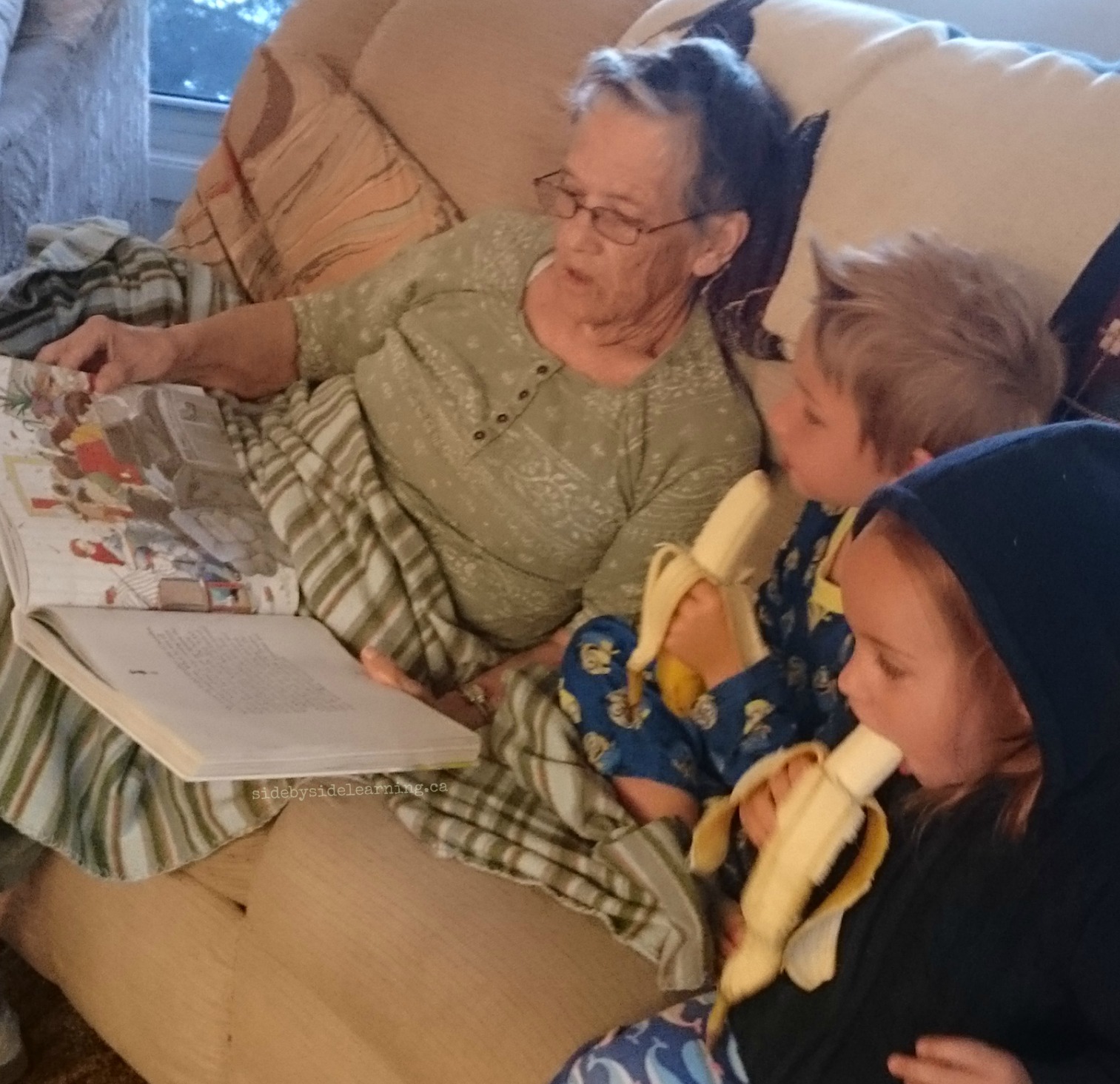
11. Read tons of books
Have family to read aloud, great grandparents, grandparents, cousins or anyone that walks in the room. There is almost always time for one more story.

12. Snuggle
When you wake up in the morning snuggle for a bit longer. When your reading, curl up under a blanket. When your drying off from a super ski ride, snuggle up. Steal some kisses too, if you can. When your kids run, chase them and snuggle them again.

13. Explore Nature
Go on hikes if your close to the mountains or just explore the area your in. Look for different types of wildlife. See the colors all around you. Notice the different patterns on birds and leaves. Observe the bottom of the lake (if its clear) or look at the banks. Count the lily pads as you pass them. Wherever you are just take a minute to really look around. Maybe even touch some new textures.
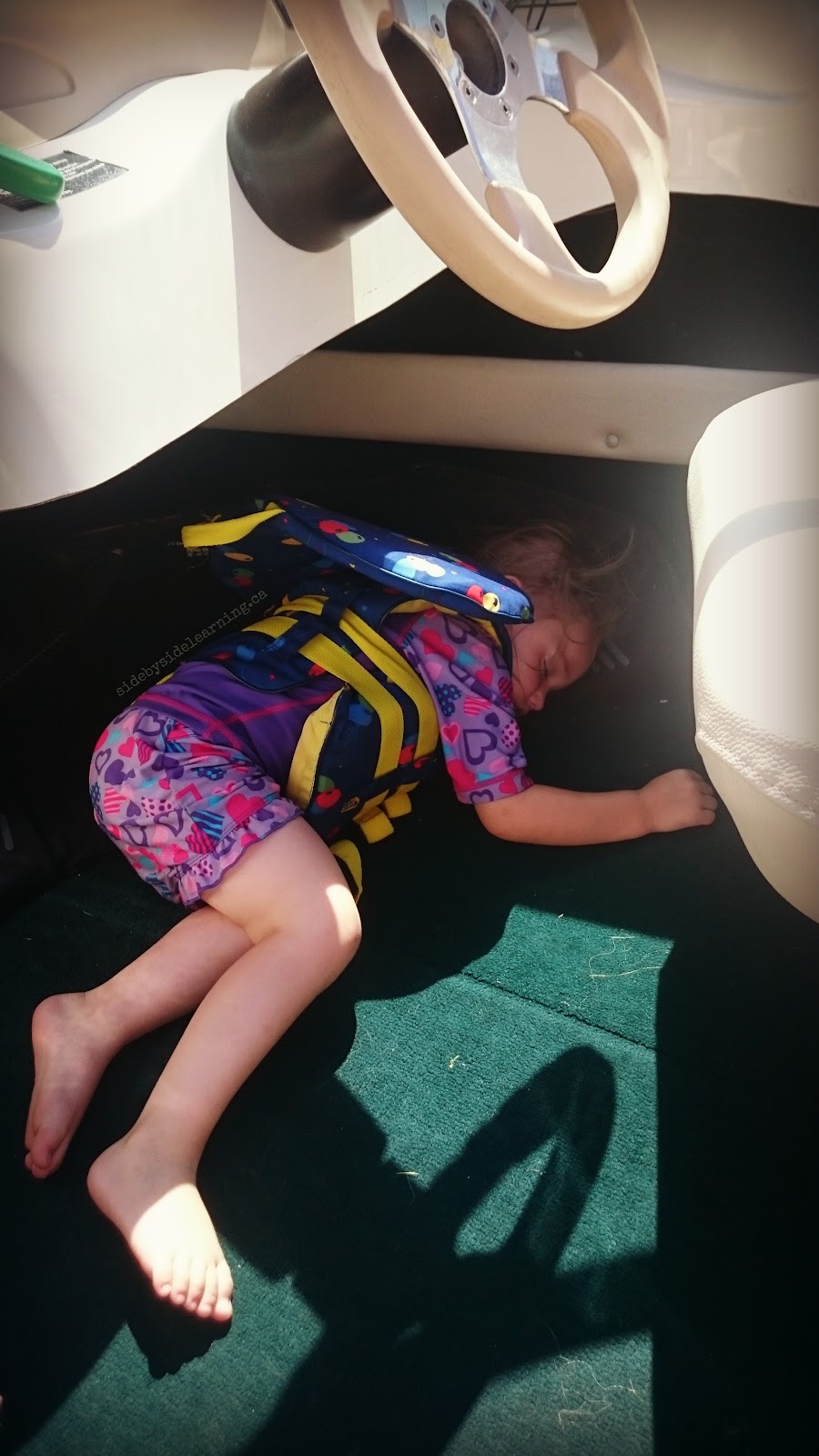
14. Fall Asleep in unusual places
I don’t think my toddlers set out to accomplish this one but they often reach their fun maximum and collapse in funny spots. Sweets often curled up by my Dad’s feet as he was driving the boat. Its shaded under there and the motor sounds help lull little ones to sleep. I was always surprised that she went willingly. I guess she was just that tired.

15. Work Hard
Include your kids in what you are doing. Growing up we always had to work on a project of some sort before we could play in the lake for the afternoon. It worked out well as the water is chilly in the morning. The cabin is much more established now so our projects are generally smaller but when one comes up every pitches in. Yes, even the toddlers.
Last year we started to build an addition to the retaining wall. Lots of rocks needs to be moved. The kids helped to move rocks that they could lift but they also supervised Great Grandpa as he drove the Kubota to the unloading area. Once they were parked the kids unloaded rocks and threw them where they needed to go. When it was the big boys turn they moved out of the way but they were included. Doesn’t seem like typical vacation fun but they loved helping and proving how big they were.
The Importance of Sensory Experiences in Early Childhood Development
Engaging with a lake offers young explorers a unique possibility to awaken their senses and foster overall development through *hands-on experiences*. The vibrant colors of lily pads, the subtle rustling of reeds in the wind, and the varied textures of wet soil and smooth stones all invite toddlers to observe, touch, and interact. These sensory experiences ignite curiosity and learning, stimulating various modes of inquiry that enhance cognitive and motor skills. As a notable example, when a child dips their fingers into the cool water, they not only experience temperature differences but also explore the concept of cause and effect as ripples emanate outward. These moments solidify foundational knowledge that is crucial for cognitive and sensory development.
Moreover, the natural environment of a lake serves as an *interactive classroom* where children can explore myriad sounds, smells, and sights. From the croaking of frogs to the delicate flutter of dragonflies, each encounter enriches a child’s auditory and visual literacy.These sensory stimuli promote not only individual exploration but also social interaction as children share discoveries with peers. Activities such as collecting leaves or creating simple nature-based art can further deepen their engagement and understanding.
What sensory activities can young explorers
engage in at a lake?
There are numerous sensory activities that young explorers can part ake in while visiting Lakes,making the experience not only educational but also enjoyable. One popular activity is water sampling, where children can use jars to collect small samples of lake water. This hands-on experience allows them to observe microorganisms and learn about aquatic ecosystems. Children can also engage in sensory scavenger hunts, searching for items such as smooth stones, soft moss, and textured twigs, encouraging them to document their findings through drawing or writing.
Another engaging activity involves nature art made from found objects. Children can create nature collages using leaves, flowers, and other materials gathered from the lake’s vicinity. this activity enhances their tactile experience and encourages creativity. Moreover, sensory play can also include dipping fingers in the water to feel temperature variations, or gently touching the vibrant textures of lily pads.Each of these activities promotes fine motor skills while reinforcing concepts of environmental stewardship and appreciation for biodiversity.
How can lake exploration enhance cognitive development in young children?
Exploring lakes can significantly enhance cognitive development in young children by fostering critical thinking, observation skills, and problem-solving abilities. When children engage with the natural world, they are compelled to ask questions and seek answers, thereby strengthening their curiosity and inquiry skills.For instance, a child who observes a frog leaping from a lily pad may wonder why it chose that particular moment to jump, leading to discussions about animal behavior or the concept of survival.
Additionally, observations made during lake exploration promote scientific thinking. When children notice changes in the Lake over time—such as the arrival of new wildlife or seasonal shifts—they learn to make predictions and draw conclusions based on their observations. For instance, noting the differences in insect populations between summer and winter can ignite discussions about life cycles and environmental changes. Studies show that nature-based learning environments, like Lakes, can perhaps improve problem-solving and cognitive flexibility, nurturing skills essential for lifelong learning.
What role does sensory exploration at lakes play in emotional and social development?
Sensory exploration at lakes also plays a crucial role in emotional and social development. Many children experience a sense of calm and emotional regulation when immersed in nature. The tranquil environment of a Lake can provide a soothing backdrop for exploration, allowing children to connect emotionally with the natural world. Studies indicate that nature exposure is linked to reduced stress and improved mood, which can foster positive feelings and build resilience in young learners.
Socially, lake exploration frequently enough occurs in groups, promoting teamwork, communication, and shared experiences. As children collaborate on activities such as collecting samples or creating art from natural materials, they practice essential social skills like negotiation, empathy, and cooperation. These interactions help them build friendships and strengthen their interpersonal skills, encouraging a sense of belonging and community. Additionally, group discussions following lake activities can facilitate deeper understanding as children share their insights and observations with one another.
What safety considerations should be taken into account when exploring lakes with young children?
When exploring lakes with young children, safety is a paramount concern that should not be overlooked. First and foremost,close supervision is essential.Since Lakes can pose drowning hazards, especially for younger children, adults should maintain a watchful eye, ensuring that children stay at a safe distance from the water’s edge and do not engage in unsupervised play. It’s advisable to discuss safety rules before heading to the Lake, such as not running near the water or throwing objects.
Another significant aspect is awareness of local wildlife. Lakes are home to various creatures, some of which may pose risks. It’s beneficial to educate children about safe interactions with animals, including recognizing which species are harmless and which should be left undisturbed. Wearing appropriate clothing, such as sturdy shoes and long pants, can also protect against ticks or insect bites common in lush, Lake-laden areas. Furthermore, using sunscreen and insect repellent can enhance comfort and safety during outdoor exploration, allowing for a more enjoyable experience focused on discovery.
How can parents and educators facilitate sensory exploration at Lakes?
parents and educators can play an instrumental role in facilitating sensory exploration at lakes by planning structured yet flexible activities that encourage discovery and engagement. Readiness is key; adults can help children set clear objectives for their exploration, whether it’s identifying different plant and animal species or engaging in water experiments. Providing children with simple tools like magnifying glasses, nets, and notebooks can enhance their interaction with the environment, making observations more engaging and informative.
Additionally, fostering a sense of wonder through storytelling or guided discussions can significantly enhance the experience. Parents and educators can introduce relevant themes, such as the importance of ecosystems or the water cycle, to spark interest and deepen understanding. Encouraging reflective activities like journaling or creative arts after the visit can also help solidify the knowledge gained during the exploration.This approach not only reinforces learning but also encourages children to express their feelings and thoughts about their sensory experiences in nature, solidifying the connection between exploration and education.
In Summary
Lakes serve as invaluable sensory discovery zones for young explorers, providing rich, hands-on experiences that ignite curiosity and foster a love for nature. Through the sights, sounds, and textures found in these ecosystems, children can engage in critical observation and exploration, enhancing their cognitive and sensory skills. studies show that immersive outdoor experiences not only promote physical health but also support social-emotional development in early childhood.
By integrating Lake-based activities into educational frameworks, caregivers and educators can create a holistic learning environment that nurtures young minds while instilling a sense of stewardship for the natural world. So, next time you venture outdoors, consider introducing the children in your life to the wonders of a local Lake—each visit can be a new chapter in their adventurous journey of discovery.
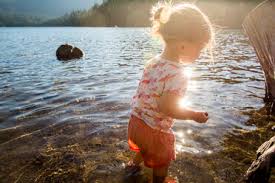
Superscript
3 Reasons to Explore Wild Water & Tips to Keep Everyone Safe and Having Fun
I know that many of you already love exploring rivers and streams with your kids. I know because I’ve seen your pictures. But I’m writing this because if I can persuade just one person that there is something wonderful and unique about splashing around among the gentle rapids of a river, it’s worth it.
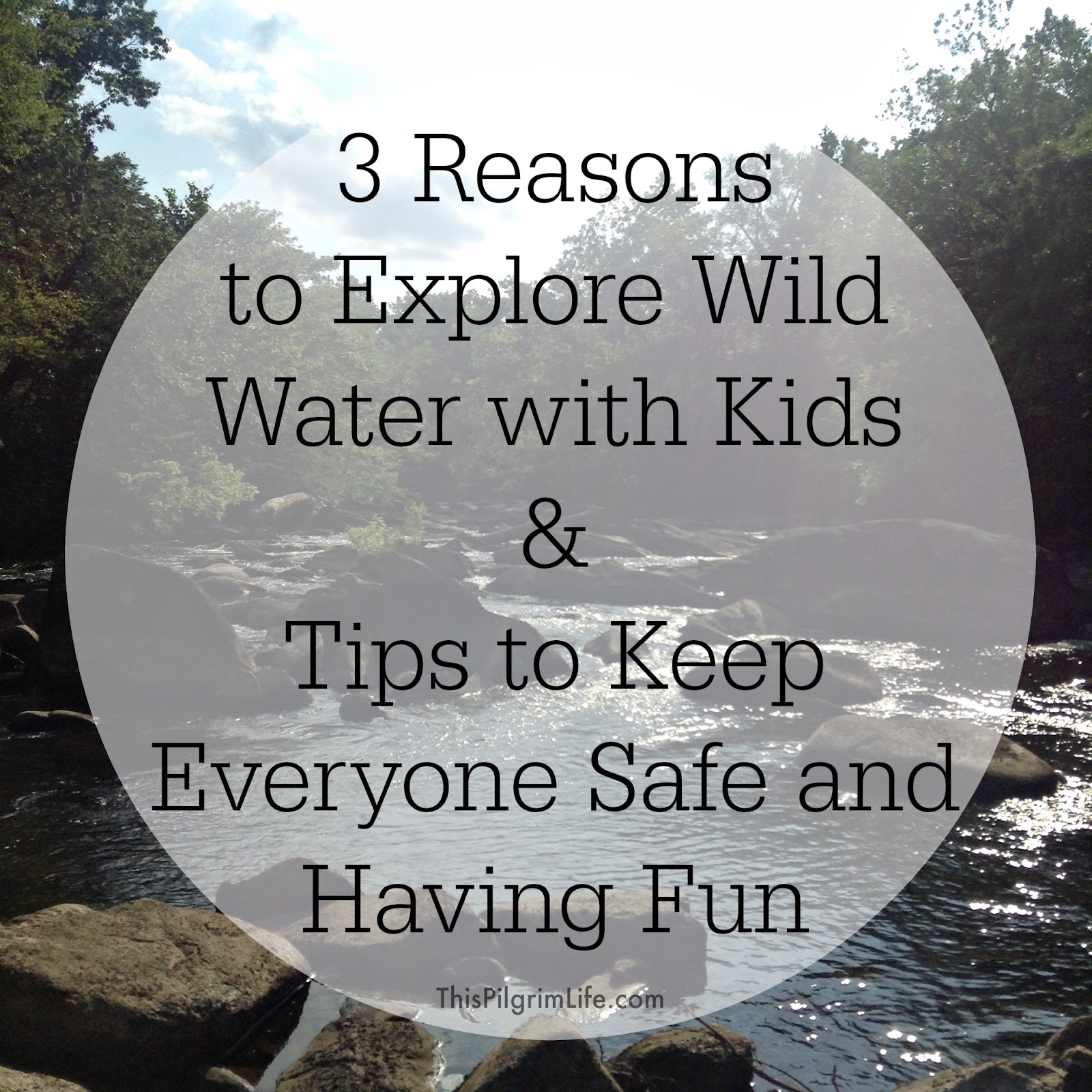
This is our first summer that our family has a pool membership. The pool has only been open a handful of days and we’ve already been twice. Each of us are very excited about the prospect of spending many afternoons poolside.
So I wasn’t surprised my middle child asked why we weren’t going to the pool instead as we headed to the river yesterday evening . The pool is new (to him) and obviously a lot of fun.
It wasn’t long, though, before all disappointment disappeared in sight of the river. We parked along the bank and unloaded our gear… ourselves, a net and one small tote bag with a few of supplies.
Across the river and through a small field, we came to our spot. Shallow water with plenty of rocks and small rapids to explore.
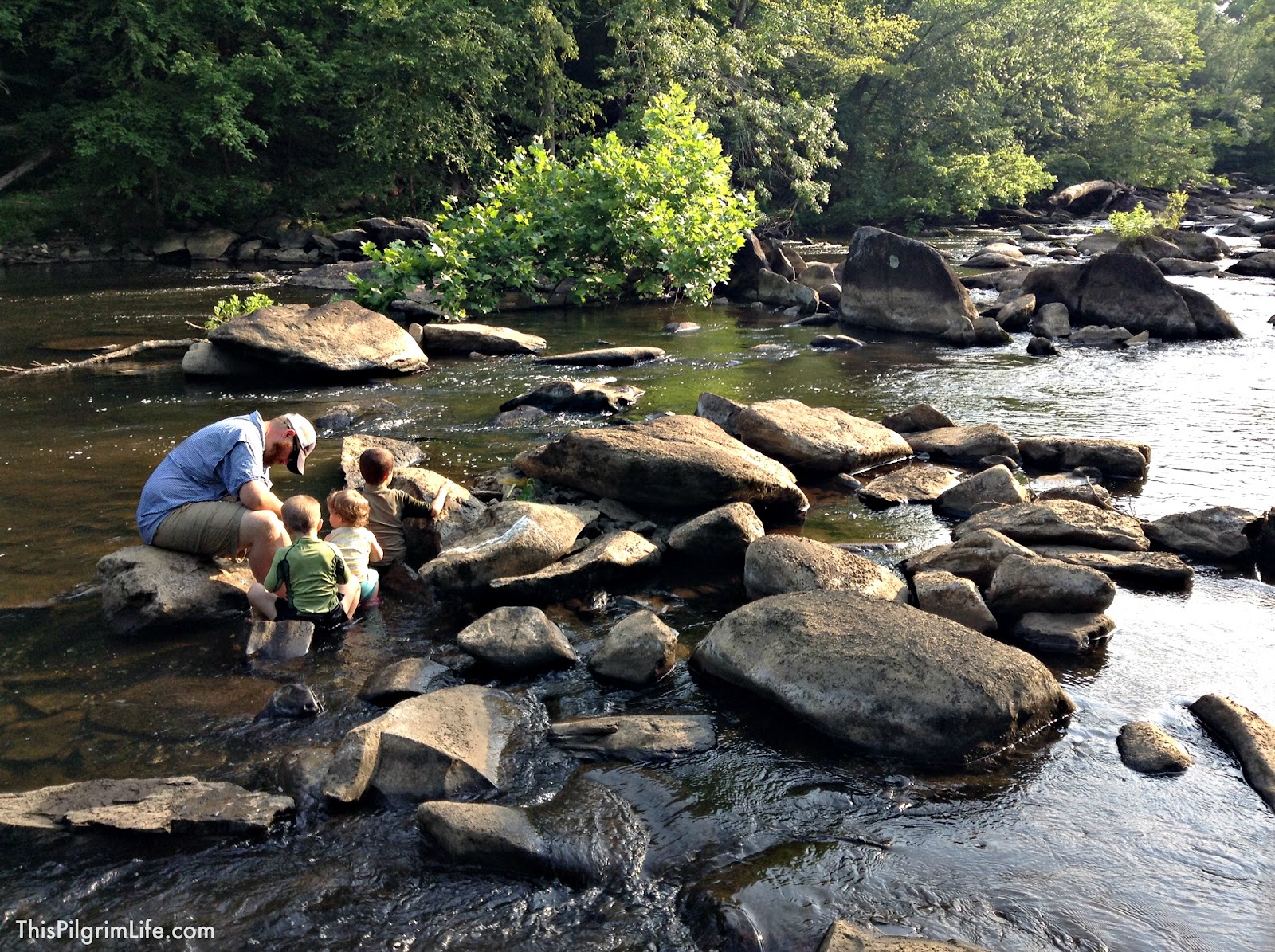
The next hour and a half was spent searching for clams, climbing on rocks, pretending to be snapping turtles, examining wildlife, and generally loving the water.
Moments of natural wonder and feelings of being so incredibly thankful for each other and the ability to appreciate God’s incredible creation.
At least, those were my feelings. They are what I hope are being passed on to my children too.
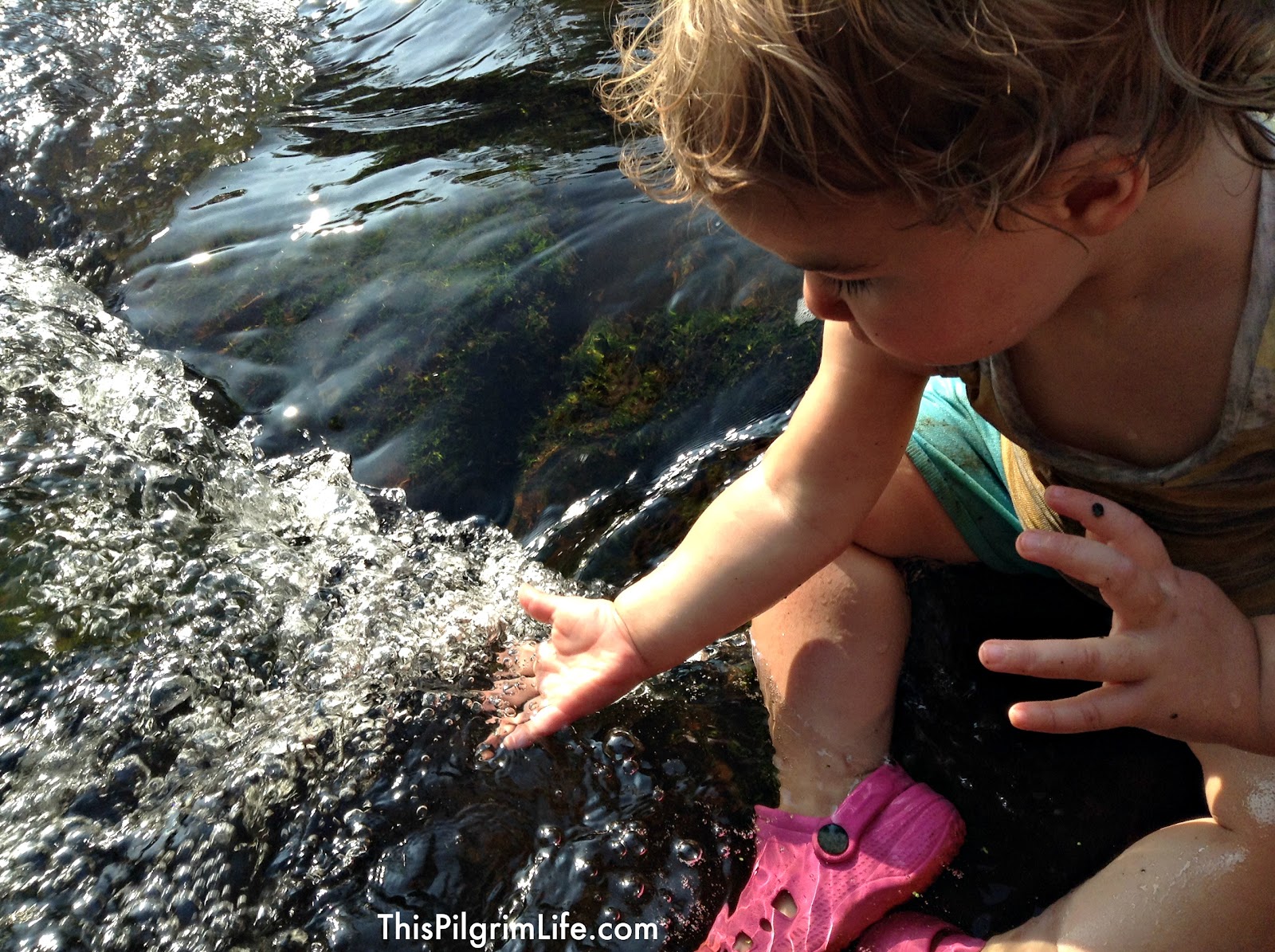

Exploring wild water with our kids is hands down one of our favorite things to do together.
We are members at our science center, frequent players at parks, and there is seldom a week that doesn’t find us at Costco or Target or both. We enjoy doing all these things together but there is something intrinsically different about being in the wild, in nature, together.

So while I wouldn’t ever try to persuade you to give up floating around in your local pool this summer, I will encourage you to find some wild water of your own…
3 Reasons to Explore Wild Water with Kids
1. Solitude, scenery, & stress relief
When we arrived at the river yesterday evening, the contrast between wild water and swimming pools was clear. No one was around. The only sounds we heard were the sounds of the water splashing over the rocks and the sounds our children doing the same.
Along with the peaceful solitude of the river is its impressive scenery. Without fail, every.single.time I go out and explore rivers and streams, I’m in awe all over again of the beauty of God’s creation. The sun shining through the trees and reflecting on the water is enough to stop me in my tracks.
Studies have shown that being outdoors in such serenity is proven to be a stress reliever to kids and adults alike. If for no other reason, go out and enjoy the quiet in order to unwind and slow down the normal pace of life for a while.
2. Countless learning opportunities
As my eldest matter of factly stated when we left the river yesterday, there is more to learn about at the river than the pool because nature is there. There is no nature at the pool.
My soon-to-be five year old gets it. From the grasses on the banks to the creatures in the water to the herons in the air. Everywhere you look, there are things to admire and examine. You just have to look.
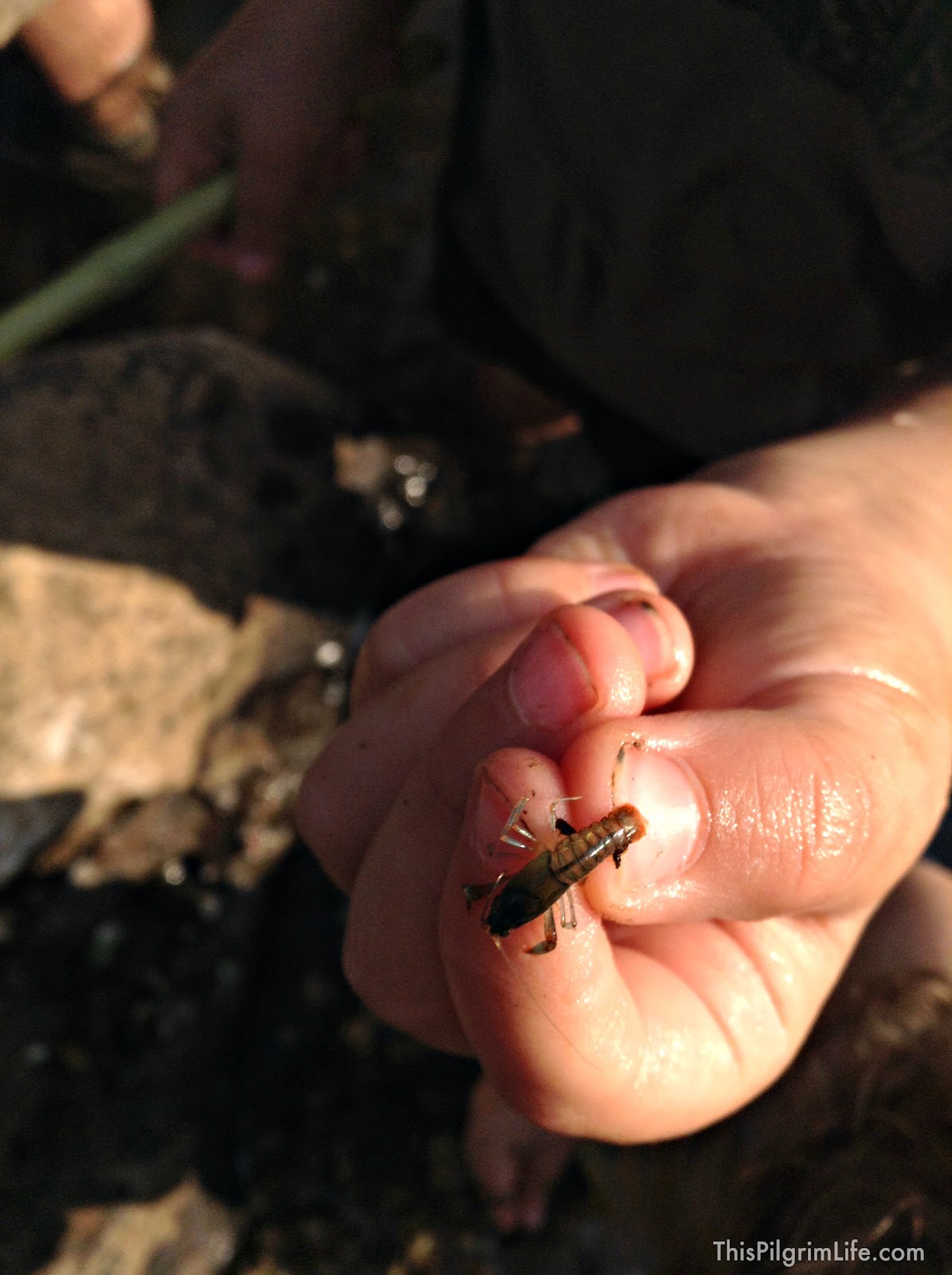
Start by simple playing and exploring freely, no pressure to make great discoveries, and learning opportunities will inevitably present themselves. Whether or not you do anything more at home, the simple act of looking and talking is a great boon to your child’s education.
3. Greater strength and agility
Yesterday I watched my toddler standing upright in the shallow areas of the river, bending down to dig up clam shells, wading through the water, and climbing up on the rocks around her. This is just her second or third time on her own in the river.
I saw my three year old confidently crawling across rocks and over small rapids, pretending to be a turtle and using both his hands and feet to carry him safely through the water.
My tall five year old, the most capable and confident in the water of my three children, is learning how to walk sure-footed through the water. To avoid the slick rocks and to catch his balance when he doesn’t.
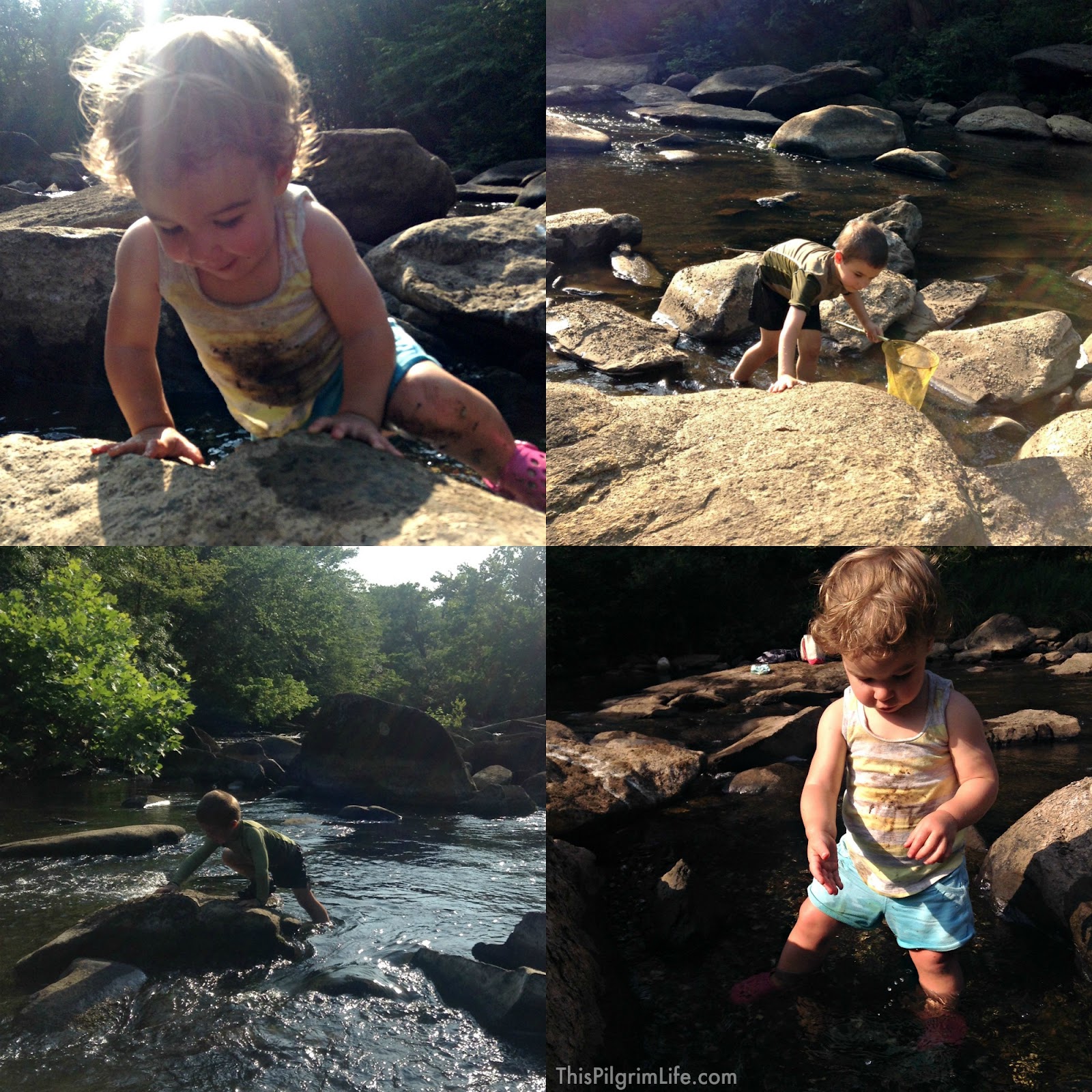
Our kids are learning from us to be safe in wild water and they are gaining more ability and confidence each time we go.
“When going on outdoor adventures, the temptation for many is to rope off hazardous areas and create a “safe” zone for their children. But never for a moment think that you can childproof the wilderness. It can’t be done. What’s more, it shouldn’t be done. Children learn to safely interact with wild places by interacting with them. Even toddlers...”
–Babes in the Woods
Tips to Keep Everyone Safe and Having Fun
Wear the right shoes.
Leave your flip flops at home and stick to shoes with toe and heel straps, as well as a good sole. Bonus points for shoes that protect your toes. Our boys live in KEEN sandals during the summer and we have never been disappointed in them.
Look for good access to avoid steep banks.
Find a spot on the bank that will be safe to get down and to climb back up when are all wet and tired.
Let an adult wade first.
If you are in an area that is new to you, wade out first before your children to check for any drop-off or especially mucky areas in which they might sink.
Drink lots of water.
Any time you are out in the sun is an important time to drink lots of water. But often being in the water makes us think we aren’t really thirsty. Be sure to drink water and encourage your kids to drink water whether or not you feel like you need to.
Wear old, fast drying clothes.
I have a stash of fast drying shorts and rash guard shirts that I have found over the past couple of years at Goodwill reserved for the times we are out in wild water. My kids can get dirty without concern, and I know that they will be comfortable for whatever activity they do.
Bring: nets and a container for treasures.
Nets aren’t really essential when hands will do just as well, but having a small bag or pail to store a few found treasures in is. Being able to bring home a few interesting finds makes the trip more special and opens up more opportunities for identification in field guides and recording memories in nature journals.
Don’t bring: valuables or anything not meant to get wet.
Leave most valuables at home or in the car. If you need to bring a phone, keep it in a safe place on the bank (not in your pocket!). You don’t want to be worried about getting it wet if you accidentally slip or be encumbered from really playing with your kids.
Be observant.
It is good to be aware of what poison ivy looks like and what potentially harmful snakes live in your area so that you can avoid both if need arises. We have seen both and have never had a problem with either. I will share more on both in an upcoming post, but for now, just remember that snakes generally do not want to be any closer to you than you want them to be. Any snakes we have seen have been quick to get away as soon as we approach.
Don’t know where to go?Check Google maps, ask a friend, or call a local fishing shop. With an angler for a husband, I am certain that last option is able to point you in the right direction!
So tell me? Are you convinced? If not, what’s holding you back?
More in the {Real} Magic Kingdom Series:
Bringing the Outdoors Home: Ideas for Continued Learning
Favorite Resources
Projects for Water Play & Exploration
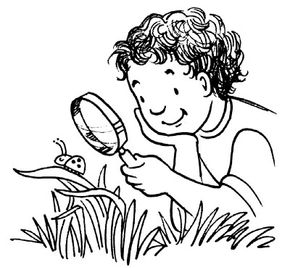
Have you ever wondered what goes on between blades of grass, or what you can find flowing along with the water in a stream? An easy outdoor science activity for kids can help you find the answers.
There's a whole world out there, waiting to be investigated and explored.
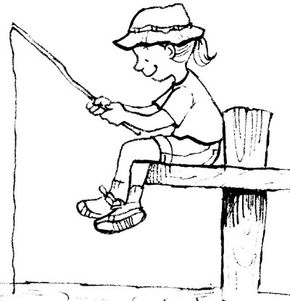
There's lots to do at the lake or river--watching for a nibble with our homemade fishing pole!
Pack up the car and head for your local beachfront -- it's time for some fun with lake activities for kids.
There are plenty of crafts and activities for the family to do on a mini-vacation at the local beach. These activities will teach you about the local wildlife and might even enable you to catch some fish.
It's Huck Finn all over again with this easy-to-make fishing gear. Find out how to make a homemade fishing rod.
Keep reading to learn how to find out what's going on underwater!
For more fun outdoor activities, check out:
Do-It-Yourself Snorkel Mask
Now you can go snorkeling without even getting your face wet with the Do-It-Yourself Snorkel Mask!
So what's there to do when you're standing knee-deep in a lake and you're just not up for a swim? Use a "snorkel mask" to check out what's going on below the water's surface!
What You'll Need:
Plastic two-liter ice cream container
Safe scissors
Plastic wrap
Tape
Rubber bands
Step 1: Cut out the bottom of a large ice cream tub. Adults may want to do this step for younger children.
Step 2: Cover this hole (and the sides of the container) with a large piece of plastic wrap. Tape the wrap in place.
Step 3: To make sure the plastic wrap stays put, slide a rubber band over it at the top of the container. Do the same at the other end.
Now you're ready for some underwater exploring! Place the plastic-covered end of your mask in some shallow water. Then, look through the open end of the mask and see if you can catch a glimpse of plants and animals in their watery home. Be sure you don't get any water inside the mask, though, or it'll sink like a stone!
Keep reading and you'll learn to catch fish the old-fashioned way!
Homemade Fishing Rod

You'll get nibbles aplenty with this homemade fishing pole!
Your child doesn't need expensive equipment to catch fish. The fish don't care if you have a homemade fishing rod or a store-bought one.
What You'll Need:
Sturdy stick, four to five feet long
Fishing line
Safe scissors
Fish hook
Plastic bobber
Bait
NOTE: The best type of stick for your fishing rod is strong, yet slightly flexible. Bamboo, about one half-inch thick, would be ideal. Find something similar in your own yard or campground.
Step 1: Tie one end of the fishing line to the handle (use the thicker end of the stick as the handle). Wrap the line in a spiral around the stick until you reach the tip.Tie the line firmly to the tip, but don't cut the line yet.
Step 2: Unroll the line about a foot longer than your stick, and cut it off the roll. You should have a continuous length of fishing line extending from the handle of your stick down to the hook. (That way, if the fishing rod breaks in the middle, you still have the line in your hand.)
Step 3: Tie a hook to the end of the line. Fasten a bobber to the middle of the line. You'll want to use a ball-shaped red and white bobber with a spring-loaded hook that will fasten it anywhere on the line.
Now you're ready to fish! For bait, use worms or other material from a sporting goods store.
Make an Awesome Aquascope

Awesome Aquascope
Have you ever looked at the surface of a pond or stream and wished you could see what was going on down there? With this awesome aquascope, now you can.
What You'll Need:
Half-gallon milk carton
Knife
Plastic wrap
Large rubber band
Heavy tape
How to Make an Awesome Aquascope:
Step 1: Take an empty half-gallon milk carton, and cut the bottom and top off the carton.
Step 2: Stretch clear plastic wrap over one end of the carton. Use a big rubber band to hold it in place tight, or use heavy tape. You just made your own aquascope.
Step 3: Head for that pond or stream. If the water is deep, have an adult along with you. Hold the plastic-covered end of your aquascope just under the surface of the water, and look through the other end. What's going on down there? Be careful not to harm any of the wildlife.
If the aquascope still doesn't get you a close enough look, keep reading to learn how to observe water organisms with a pond net instead.
Bug Dipping Net
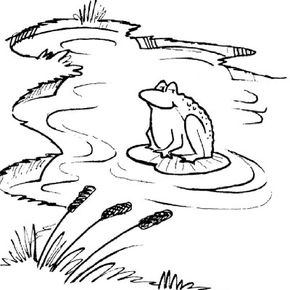
Bug Dip Net
One way to explore water life is to create a pond or bug dip net and catch living organisms for observation. Don't forget to return the animals back to the pond when you're done.
What You'll Need:
Stiff wire coat hanger
Broomstick- stick from the woods or a dowel
Heavy wood staples (the kind that are hammered in)
Tape measure
Waterproof tape
Safe scissors
Cheesecloth or wide-mesh nylon net
Needle and thread
Tall rubber boots
Large metal pan (such as an aluminum roasting pan)
Bucket
How to Make a Insect or Bug Dipper Net:
Step 1: To make a dip net, bend a stiff wire coat hanger in the shape of a D, leaving the hook in the middle of the straight part of the D. Straighten the hook and use heavy wood staples to fasten the straightened hook to the end of a broomstick.
Step 2: Fold the wire back over the last staple. Wrap the end in waterproof tape.
Step 3: Measure the distance around the wire frame. Cut some cheesecloth that width and 18 inches long.
Step 4: Sew the ends together into a tube. Stitch one end of the tube shut. Sew the open end of the tube to the frame by turning the edge over the frame then stitching the fabric to itself.
Step 5: To use your dip net, put on rubber boots and wade into a pond (with an adult along). Be careful not to wade in water deeper than your boots.
Step 6: Hold the net in the water with the handle upright and the net resting on the pond bottom. Have a bucket with a little water in it ready in the other hand.
Step 7: Move slowly through the water and gently move the net up and down. Stop now and then and dump the contents of your net into the bucket. After you've done several nettings, come ashore and dump the bucket into a wide pan. Add a little water so your animals can swim.
Step 8: When you are done, return the animals to the pond. Some pond animals (such as native turtles) are endangered because of over-collection.
What's in the Water?

Find out what's in a river with a DIY strainer.
You'll be amazed by all the things that travel down the watery highway of a creek! Make this gadget and see what you can catch.
What You'll Need:
Wire coat hanger or piece of strong wire
Screen or mesh
Duct tape
Step 1: Bend a wire coat hanger into a rough circle.
Step 2: Take a piece of old screen, and bend it around the coat hanger. (Be careful not to stick yourself with the screen. You may want to wear work gloves or gardening gloves while doing this.)
Step 3: Apply duct tape to hold the screen in place.
Step 4: Go to a creek or stream with an adult. Put your screen into the current and hold it there for a few minutes.
Step 5: Take out the screen and see what the current has carried onto it.
You might find seeds that will land on the creek's bank and grow into plants. Or, you might find water animals such as insects, minnows, or crayfish. (Put them back in the creek right away, so they stay alive.)
You might even find something somebody lost a long way upstream!
The next science activity will put you in the mindset of a famous explorer.
Exploration Activity
Discover your own uncharted territory with this fun and educational exploration activity! You can be an explorer when you visit a river, stream, lake, pond, or tide pool.
What You'll Need:
Notebook
Pen or pencil
In 1804-1806, Meriwether Lewis and William Clark were the first European-Americans to travel across what is now the western United States.
They kept journals full of notes and drawings to tell the rest of the world about all the strange, new things they saw: plants, animals, mountains, and much more.
How to do the Exploration Activity:
With an adult, visit a body of water near your home. Imagine that you are an explorer.
Look closely at the plants, animals, rocks, and other natural elements. Tell about them in a journal.
You can even make a map of the area for explorers who will follow in your footsteps. Don't forget that explorers may find all kinds of surprises. Meriwether Lewis met a grizzly bear one day, and had to jump into a river to escape!
Keep reading for a science experiment that shows what can grow in places you may not expect.
Kids can explore their prospects and see if they pan out with the activity on the next page.
Things Will Pan Out

See which things pan out in this lake and river activity.
When curious kids examine a riverbed, they'll be fascinated to see how things pan out. This lake and river activity for kids will get young explorers panning for treasure, just like hundreds of thousands of Americans did during the gold rushes of the 19th Century.
Hundreds of thousands of gold miners searched for their fortunes during the 1800s. Some of them went deep into caves to search for riches. Some panned for the gold they found. Your child can try their hand at gold panning too, using these easy tips.
What You'll Need:
Old pie pan
Cheesecloth
Fine mesh strainer
Riverside
Gather an old pie or cake pan, a piece of fine cheesecloth, and a metal mesh strainer and head for the riverside.
First, show your little gold digger how to gather a scoop of riverbed dirt in a metal strainer. Then, help them rinse the finer dirt from the scoop using river water with the cake pan just beneath the strainer. The cake pan catches the finer dirt and metal that sifts through the strainer.
Help your child strain that finer material through cheesecloth, again using river water. Do they see any golden flakes? They might have struck gold, and even fool's gold is something special.
Sand & Shore Toys That Don’t Break the Bank
What are the best items to use from home at the beach for kids? Grab your Top 5 Household Items for Beach Toys list.
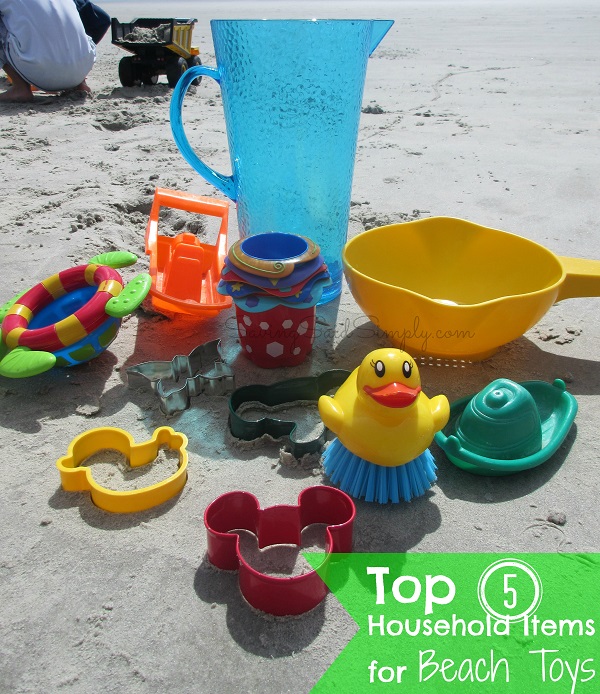
Top 5 Household Items for Beach Toys
I’ve had this happen multiple times. Your kids are bored with your beach toys. You forgot them. Or worse…they got “lost at sea.”
Instead of paying for more of them, you might have some of these ordinary household items around and collecting dust. Here’s my list of the Top 5 Ordinary Household Items that Make GREAT Beach Toys. As a Florida beach mom, these are must haves!
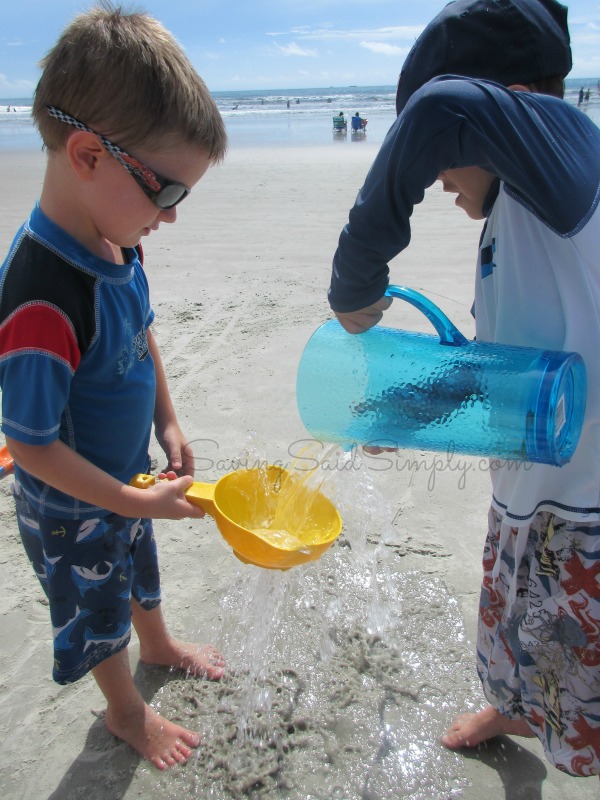
1. Strainer
Great for finding new treasures, collecting shells or straining water and sand!
2. Pitcher
A pitcher is wonderful! Take a plastic one to hold your new toys, fill with sand, water or both!
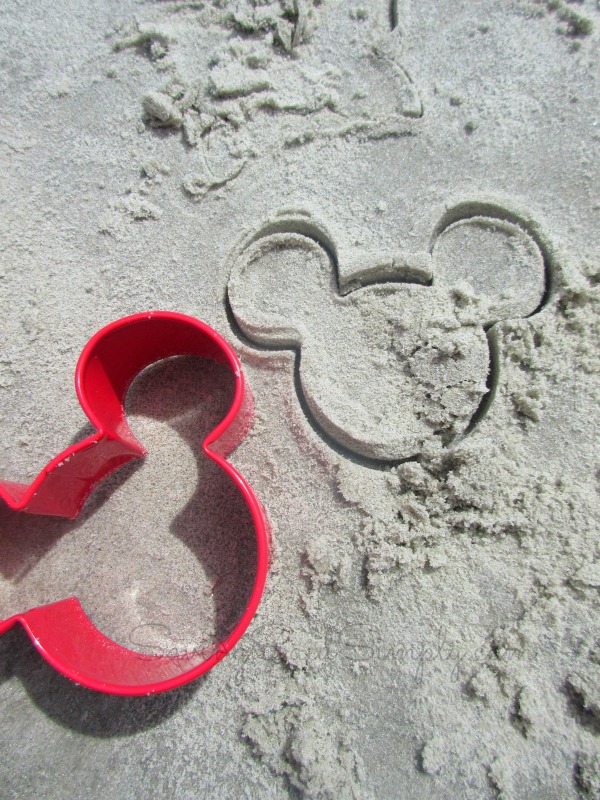
3. Cookie Cutters
Make new sand shapes with cookie cutters! Bring your child’s favorite!
4. Bath Toys
Who says bath toys are for home only? Take some old ones to the beach and give them life again!
5. Ice Cream Scoop or Measuring Scoop
Can’t grab sand without a digging tool!
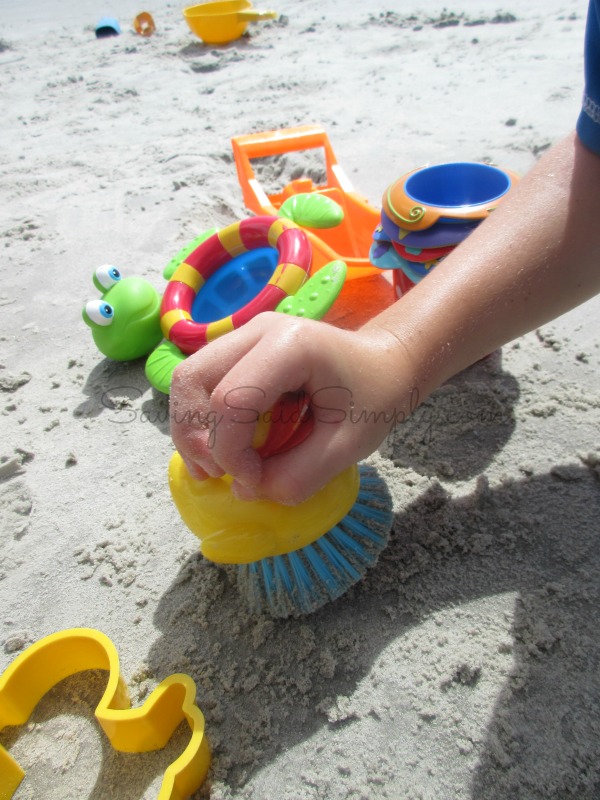
6. BONUS – Scrub Brush
I loved the idea of kids cleaning up the sand. Make new patterns, erase footprints or just smooth out an area for play.
How to Make Plastic Bottle Sand Scoops.
It’s cold here right now. Yesterday morning it was -2 degrees C in my kitchen (which is possibly because one wall and the ceiling are still made of blue tarps).
I think I was a hibernating animal in my past life, because when it is dark and dreary outside I just want to shut all the doors, pull down the blinds and keep everyone in. I know that’s not good for us, especially the kids, so I try to get outside every day, even if it is just a five minute walk up the drive to the letter box, or a a quick run around the play group at school pick up, but some days I really REALLY don’t want to!
Despite the freezing bite to the wind and frosty mornings, the sun has been shining here this week which has just been blissful. I can cope with the cold if the sun is shining!
So to encourage everyone outside into the sunshine, and to give the boys something to do while I potter in the garden, this week we resurrected our sand pit and made some plastic bottle sand scoops!
I’d been collecting various plastic bottles for a while now, knowing they’d be good for something (in the past we’ve made these cool fairy houses) and they were perfect for making scoops!
How to Make Plastic Bottle Sand Scoops.
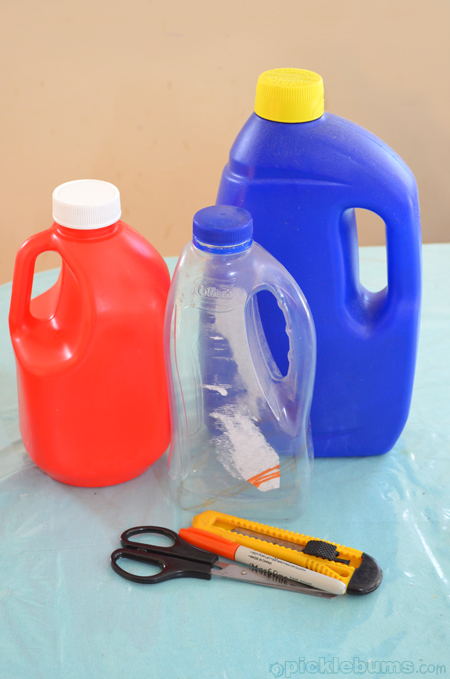
You’ll need:
Plastic bottles in any shape or size, with the lid.
Scissors and/or a craft knife
A permanent marker
Mark a line across the side of the bottle – from the handle down to the side. Make sure you leave enough plastic around the handle to keep it intact and strong, and cut down far enough on the side to make sure there is no lip left from the bottom of the bottle.
Make a starting hole with the craft knife and then cut along your marked line with scissors or continue with the craft knife. I find scissors easier to control, but some thicker bits of plastic may need a craft knife to get through.
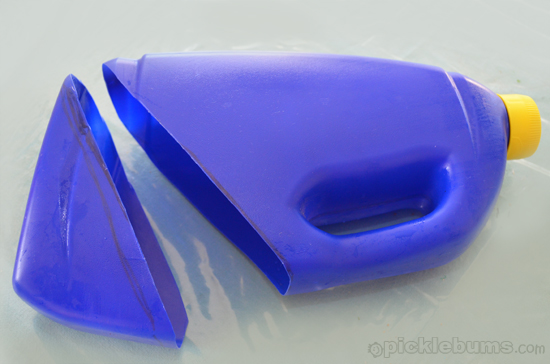
You can tidy up your cut after you’ve made it… cutting off any sharp edges and making corrections till you get the perfect looking sand scoop.
You can screw the lids on tight or take the lids off all together and you have a scoopey kind of funnel. You could have lots of fun if you melted holes in the lids and used the scoops with water or fine sand too.
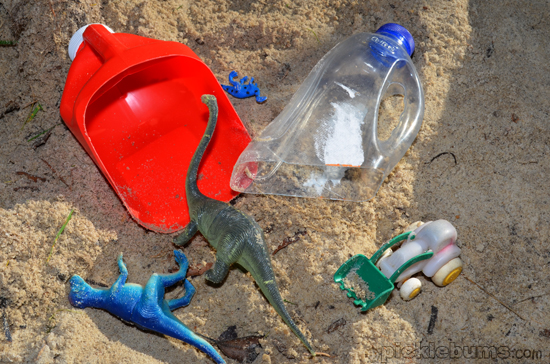
Our sand pit has definitely seen better days. It isn’t used as often these days with the big kids preferring dirt and plants and potion making to the sand pit. So the boys and I had to pull out a good few weeds before we could try out our scoops. I also dug over the sand pit with my big proper garden shovel. Fluffing up the sand makes it a lot easier for the kids to dig and scoop, it’s worth doing every now and then regardless of how neglected your sand pit is.

Now get out there and enjoy the sunshine while you can!!
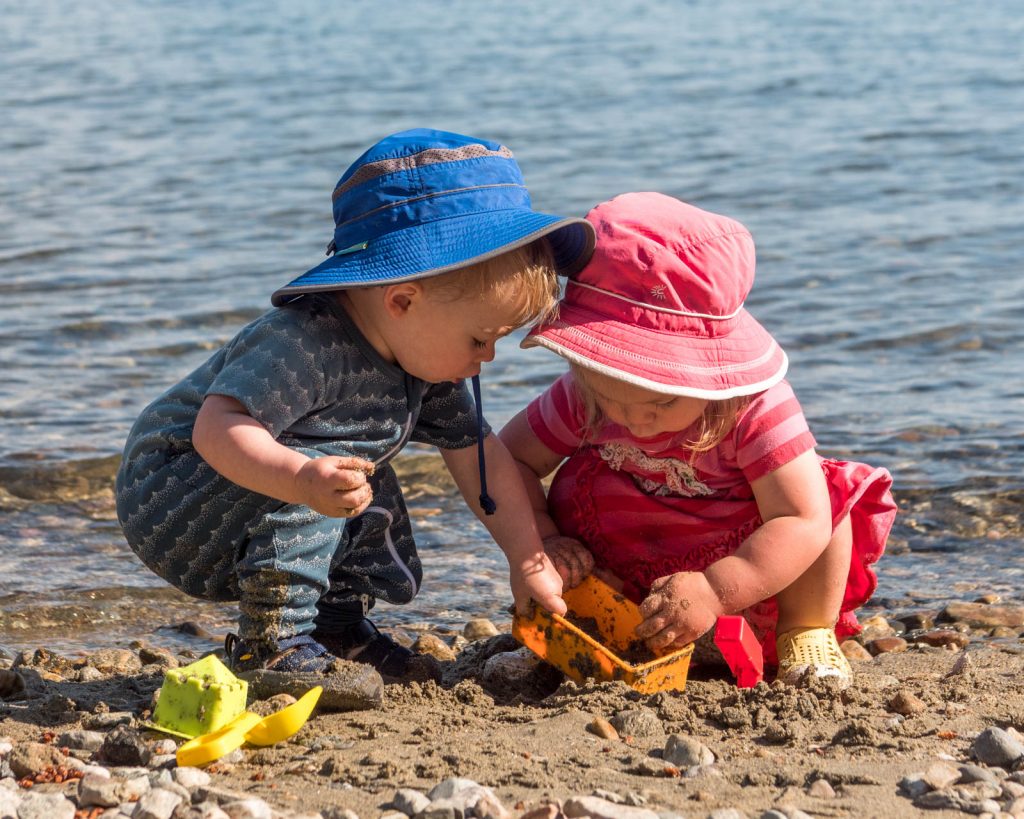
Superscript
Fun Lake Activities for Kids and Mom:
Learn, Play, and Protect Nature
“The secret with kids is to ‘just add water’, and everything resets”, my mother in law once told me, when I was lamenting about how rowdy my kids get when we’re all home. It sounded a little too simple… but over the years I’ve found this to be true. There’s just something about running water that resets the entire dynamic in our home. In fact, researchers have found that the sound of running water can trigger our parasympathetic nervous system; helping our bodies relax by lowering our heart rate, decreasing blood pressure, and moderating our cortisol secretion.
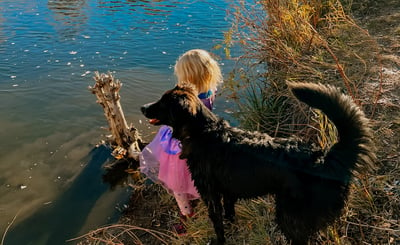
But I don’t need a scientific publication to convince me: I can see it in my own children immediately. While I love an evening on our paddle boards, and the kids love an evening swimming at our rec center, there’s something so beautiful about simply wandering along our local lake. It feels healing. “Just add water”.
Did ya know… about lakes?!
One of the coolest parts of being a mom is that I get to teach my children the “secrets of the world”, and I get to choose to prioritize the information that I believe are the most important. But of course, we never get tired of “cool facts” in my family. My kids love telling people:
“Did you know that the Nile runs through 11 countries?! 11!!”
“Did you know that some lakes run UNDERGROUND?! Where nobody can see them?! CRAZY!”
“Did you know that bull sharks can live in lakes for long periods of time? They’ve been found in the Mississippi lake!!”
“Did you know there are teeny tiny microorganisms in lakes? Some are in the shape of a corkscrew!”
“Did you know you can find GOLD in lakes?!”
But just as importantly, I love teaching my kids how lakes play an essential role in the water cycle- and how our health and the health of all wildlife is reliant on our lakes. If WE want to be healthy, we need our EARTH to be healthy, which means we need our lakeS to be healthy. And the coolest part? Even the littlest adventurers can help keep our lakes healthy!
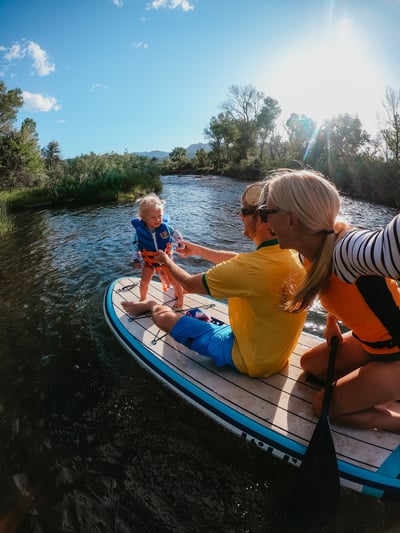
Kid Friendly Activities Along The lake
Richard Louv reminds parents in his book, Last Child in The Woods, that one of the best things we can do for the health of our planet, is to raise a generation of children who will be invested in CARING for the earth because they’ve grown up playing outside. Heading to the lake with your little explorers is one of the best ways you can invest in long term care of our earth. We love heading to our local spot along the lake a few times a week. Think you might be bored “just walking”? Think again! Here are some of our favorite activities to do:
Search for Frogs, Toads, and Crawdads
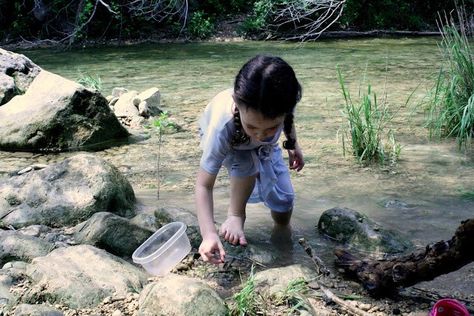
My children can spend HOURS barefoot in our favorite shallow spot along the lake looking for critters. It keeps us in sync with the seasons of nature as we’ve paid attention to the life cycles of our local amphibians. Last week we saw THOUSANDS of tadpoles- it was one of the coolest experiences my littles have had on a hike. Our little beach along the lake has been my favorite science classroom as a mother: I get to learn about the local species of wildlife as I teach my children.
Look Under Rocks
It sounds so simple- but we can spend hours doing this. The number of species of different bugs is absolutely mind blowing- and it’s fascinating to see how our findings change throughout the year. Want to sit back while your little ones explore?Pack a seat,bring a book, and dip your feet in the water.
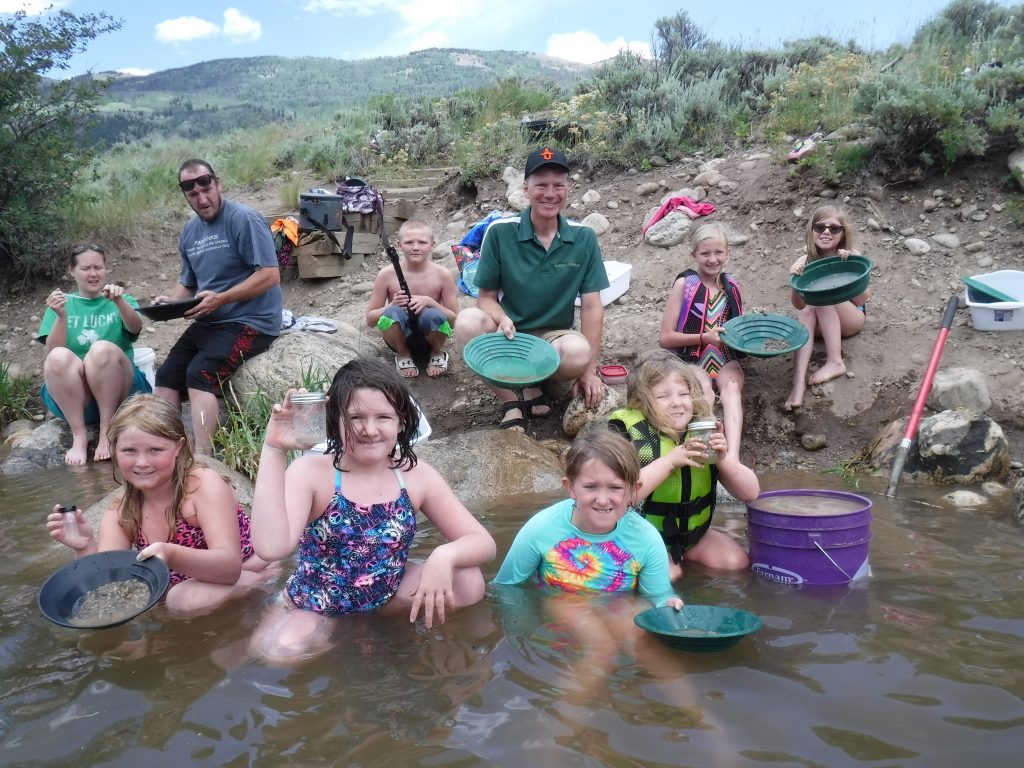
Pan For Gold
While I don’t expect that we’ll find enough gold to send them all to college, this is a great activity to keep our kids engaged during their treasure hunt. It’s also cool to remind them that lakes cause erosion, and have carried these flakes a long distance, before depositing these heavy particles along the lake bed. We learned how to pan for gold a few summers ago- here’s a link to a gold panning kit to try your own luck.
Make an Underwater Scope
One of the more important lessons to teach my children is that there is so much “below the surface” that we cannot see; Literally, and metaphorically. There are whole worlds beyond our typical perspective. To help your little ones see “below the surface” of the lake, you can make an underwater scope. Check out the simple tutorial! While you can’t expect to see the dense universe of microorganisms with your underwater scope, it’s a great opportunity to teach our little ones that our lakes are full of life.
Learn from a Naturalist
A few times a year we’ll attend an event with a naturalist. We’re lucky to live within a few minutes of an audubon center, with a wealth of opportunities to learn. Many State and National Parks and recreational areas offer these experiences, too. We always leave with a sense of awe and amazement, and a reminder of our footprint and impact. Do a quick search in your area and see what naturalist experiences are offered!

10 Apps Websites for Bird Identification
10 apps for kids to learn bird identification, wonderful nature science learning tool for kids from preschool to high school. | STEM
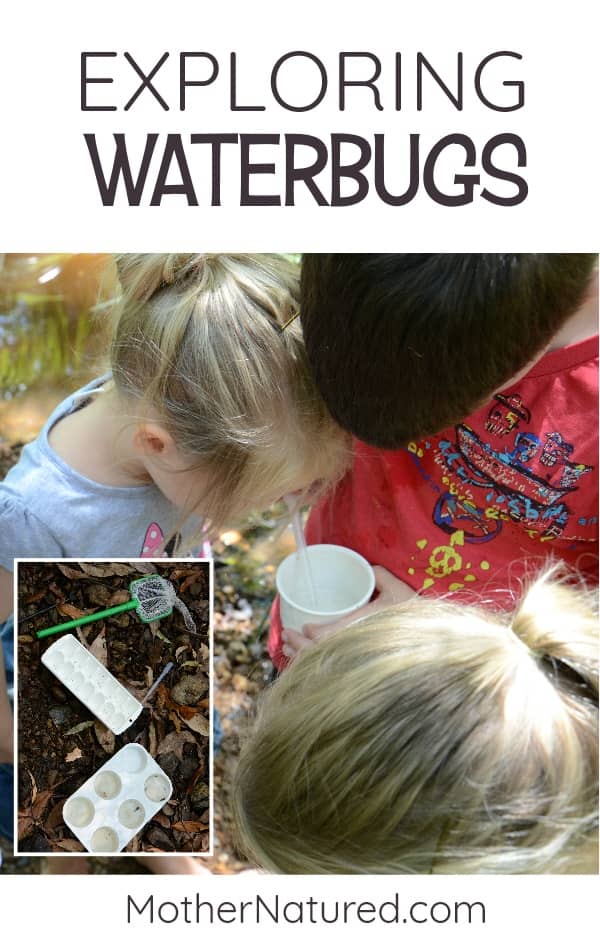
Macroinvertebrates for kids, oh where do I start with this wonderful activity.
It’s been so dry and hot lately that the little trickling creek out the back of our house has gone silent and I can’t even remember the last time I heard the chorus for Great Barred frogs from my bedroom window. Although I miss those sounds tremendously, the lack of them did make me wonder if the creek had little puddles of water that were perfect for exploring waterbugs.
Waterbugs are aquatic macroinvertebrates. They are small animals that live in the water and are just big enough to see with the naked eye. Many water bugs are insects but they can also include worms, mollusks and crustaceans. I took a quick look down at the creek and saw some pockets of water that I knew held a lot of little creatures under submerged rocks and leaves. I couldn’t wait to show the girls and I invited our neighbours along too.
Here’s how to explore the freshwater creeks and ponds for macroinvertebrates.
What to take waterbug hunting:
fish nets
tweezers
white ice cube try and paint tray
magnifying glass
identification book
pipette and spoon
paint brush
White container
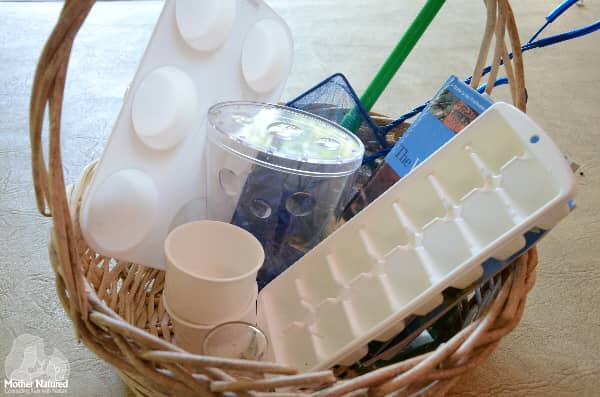
Macroinvertebrates for kids
How to find Waterbugs
There are a few ways you can catch waterbugs but first you’ll need to fill your containers with water from the pond. Try to collect it before your children start to dip their toes in the creek and muddy up the water.
Pick up stones
Pick up a stone or rock that’s submerged under the water, turn it over and use a paintbrush to gently brush the bugs into the containers of water.
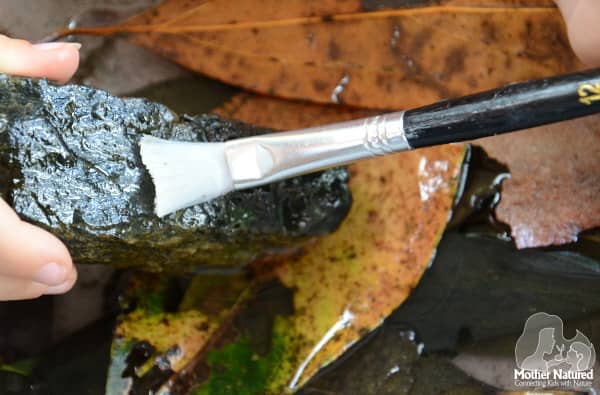
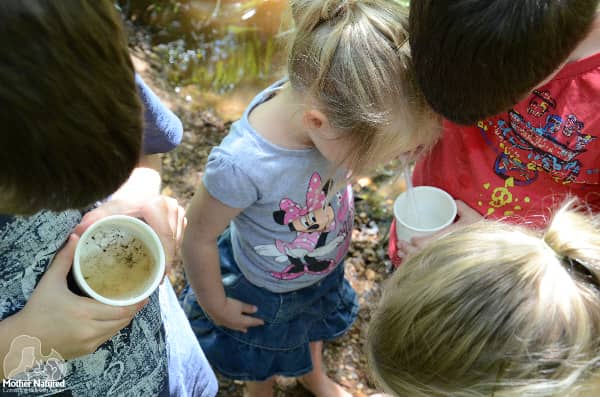
We found snails, a small leech and a few species of aquatic worms this way.
Skim with nets
Use a fish net to catch water bugs by gently scraping through the water as close to the bottom of the creek as you can without collecting too much debris. Tip the contents of the fish net into a large white container and sift through the debris to find the macroinvertebrates. If you brush the leaf as you take them out, you’ll start to see lots of movement on the bottom of the container.
If the waterbugs are small and you want a closer inspection, you can use the pipette or spoon to pick them up and place them in their own section of the ice cube or paint tray. Take a closer look with a magnifying glass.
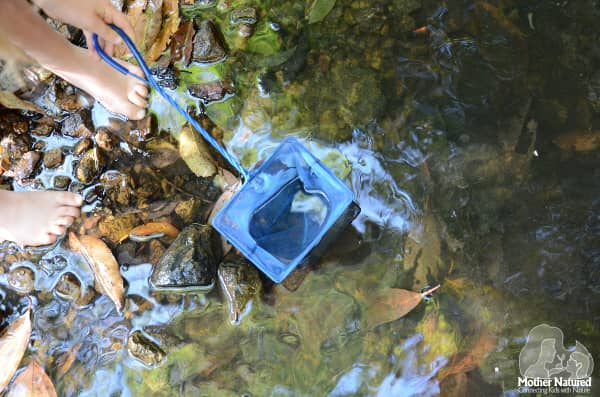
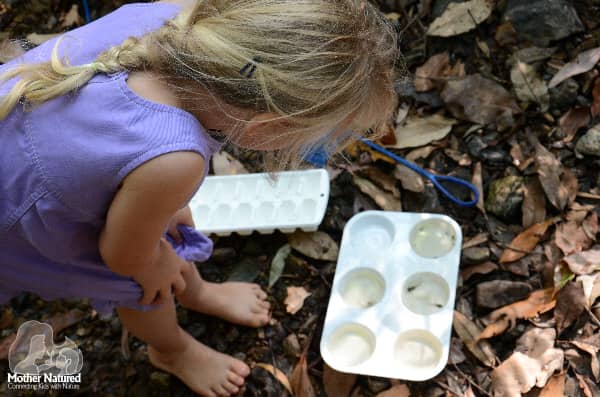
By sifting through the debris we found snails, worms, mosquito larvae and back-swimmers. We also found tadpoles too. This may not be a macroinvertebrate but the children were very excited to find some.
Explore the surrounding area
Water bugs can be found around and on the water too. We found water striders, dragonflies, a fishing spider and unfortunately quite a few mosquitoes!
My girls are quite young so my only objective was to build on their knowledge and interest of the world around them. We had a brief look at a book that we borrowed from the library that identifies local waterbugs, The Waterbug Book (affiliate link) by John Gooderham and Edward Tsyrlin. The girls weren’t that keen to know the species of the macroinvertebrates just yet. Nevertheless, I enjoyed looking through it’s pages. It’s a fantastic guide book.
In future I’d love to take some home in a mini aquarium so that we can learn more about the little creatures we found. It would be a great opportunity to understand how they play an important role in the biodiversity and health of the creek. I’d also use that opportunity to introduce life cycles and food webs.
Right now, while their young, I’m just happy to get their little toes in the creek exploring nature in our wonderful world. Macroinvertebrates for kids, or Waterbugs, are easy to find, fun to study and your kids will love learning about them!
Packing for a Epic Trip to the lake with Kids
Thank you Tampico Beverages for sponsoring this discussion.
All opinions are my own.
One of the greatest things about moving to Texas is the lake running through our town. It’s a spring-fed, crystal clear, 72 degree, lake that is perfect for swimming, tubing, wading, or kayaking. Oh, and it’s free to play in.
However, taking multiple kids to the lake, can be tricky, scary, and stressful. There are spots where the lake flows fast and gets deep quickly. Due to spring rains this year, it’s higher than normal too. There are no lifeguards either.
But I am not one to avoid something just because it appears “hard.” And what else are you supposed to do in the hot summer Texas heat than go swim (especially if you’re pregnant)?
Generally speaking, I don’t take my kids by myself to the lake. First, it’s not nearly as much fun as having a girlfriend or a husband to share the adventure with. Second, I like having an extra pair of hands and eyes to help with my littlest ones, especially since my best friend has kids who are 10 and 13 and very helpful.
I have taken my (at the time) three kids to the lake by myself. We survived and had a good time. I just don’t prefer to do it. Just in case. Along with another person there are several other things I take with me to the lake to make it not only safe, but extremely enjoyable for all.

What to Take to the Lake
When You Have Young Kids
I don’t like to bring more than I absolutely have to when I go most anywhere. The lake is no exception as there is almost always a fairly good walk from the car to the lake, especially when it’s the weekend or a holiday and everyone else in town is also going to the lake!
**If you are looking for kid-friendly stops along your route, be sure to download the GoWhee app the best app for traveling families.**
1.) Swimsuits. If you get a swim shirt for your kids or yourself you’ll also worry less about sunburns.
2.) Towels. My kids have a tendency to get cold and wanting to come out and warm up in my lap for a while. Towels are also helpful for wiping off dirty hands before you eat and keeping your car seats from getting drenched.
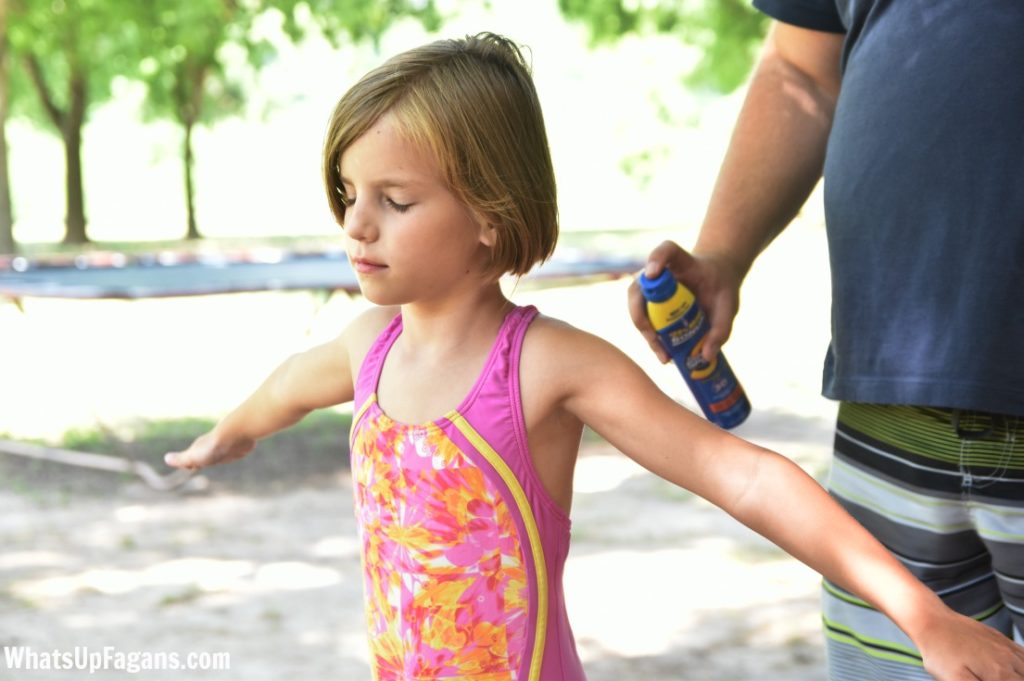
3.) Sunblock. The spray kind is amazing. Make sure it’s waterproof and a high SPF. I still prefer a lotion kind for applying to faces though.
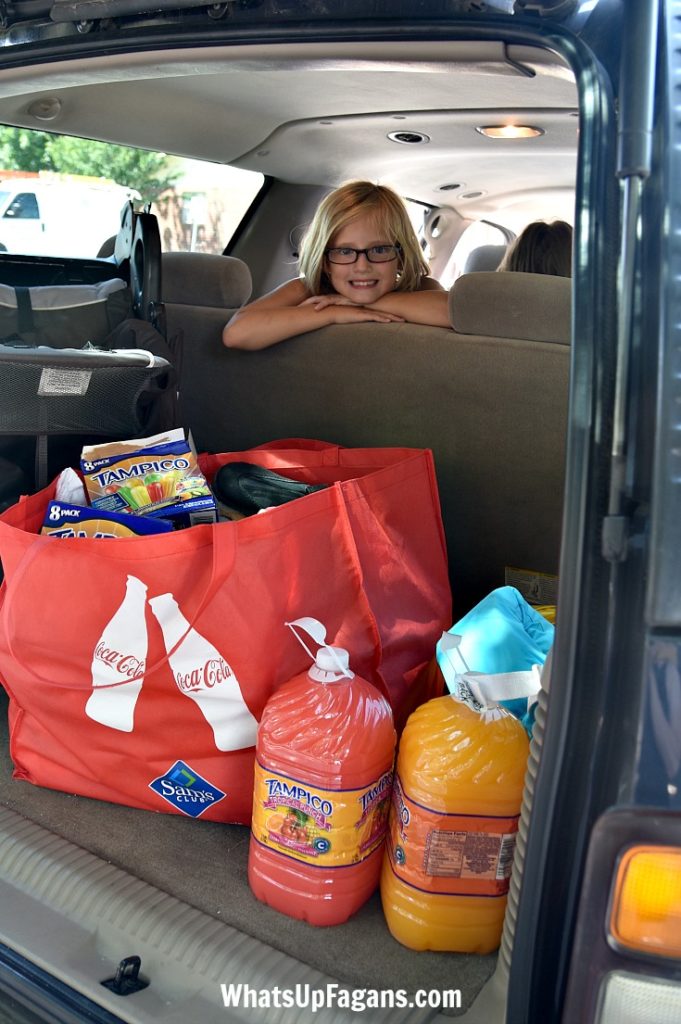
4.) Drinks. Playing outside in the sun and water zaps your body of hydration. Bring an insulated water bottle so your water will stay cold, put drinks like Tampico in an ice chest, and if you can figure out a way to keep them frozen, Tampico Popsicles are a fun easy way to stay hydrated too.

5.) Aqua socks. For kids and adults. lakes are full of seaweeds and rocks along the bottom, and it super helpful to have aqua socks so no one complains of sore feet, slimy stuff, or even hot rocks.
6.) Swim diapers. If you have a baby or toddler still using a diaper, you need these. A regular diaper will swell and ooze out its absorbent beads everywhere. Leaving extra in your purse/diaper bag as well as in your car ensures you don’t forget them!
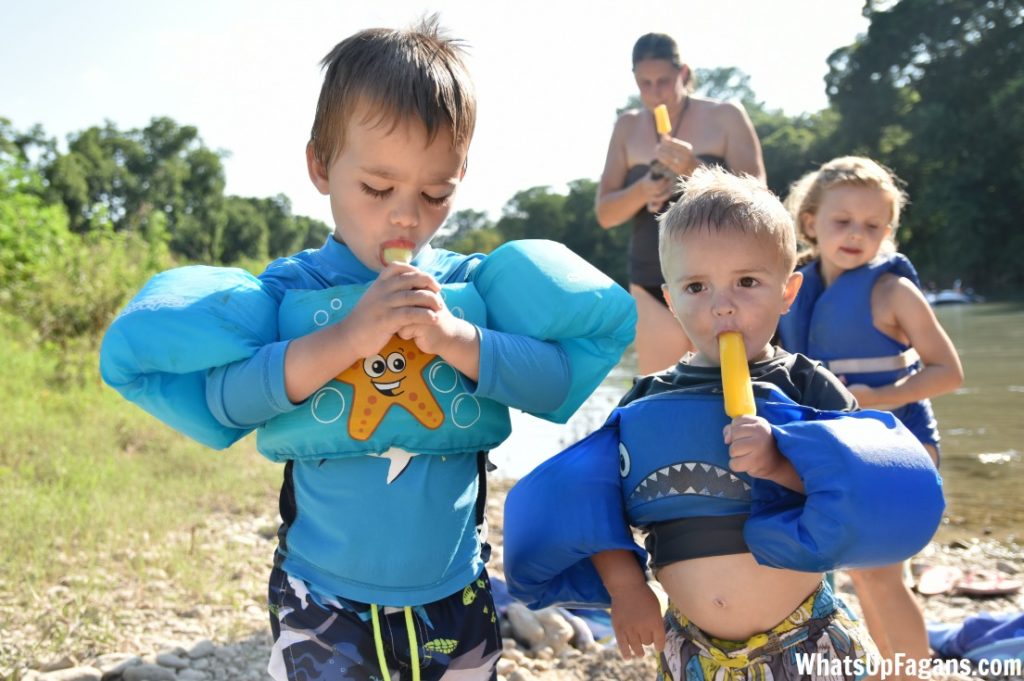
7.) Flotation Devices. My 3 year old son has a Puddle Jumper to help keep him safe in the water. My baby uses a baby float. I picked up a very simple one for $1 at the Dollar Tree the other day (where I also picked up a box of 8 Tampico popsicles) with two inflatable rings. I’ve used it in the lake several times and it works great. It gives my back a break from holding a baby the entire time. Plus, I discovered you can part the current with your body and the baby float will stay right in front of you without you having to constantly be holding it! My baby loves the water, and this allows her to enjoy it without constantly being in my arms or lap. But, they are not life saving devices and you need to be with your child while using one the whole time.
8.) Sunglasses or hat. My eyes are sensitive to the light and I prefer to wear sunglasses when outside as much as possible. If I’m chilling with a baby in the water, my head isn’t going under water anyway. My husband has a bald head and a hat provides extra sun protection. A sun hat for baby is a great idea too (we don’t currently have one). Just take them off before going under the water.
9.) Regular clothes. This includes dry underwear, your day clothes, regular dry diapers, and regular footwear (a pair of flip-flops works). If you need to run to the store afterward or for some reason need real clothes, you have them. We don’t always change before heading home, but having the option is super smart.
10.) Hair ties and bobby pins. If you have long hair, water can make it a tangled matted mess. Our friends usually braid their daughters’ long hair before swimming. I always put mine up in a ponytail and tie back my bangs and short postpartum baby hairs in bobby pins or a headband.
11.) Camp chairs. If you go to a part of the lake that is very rocky, think about bringing camp chairs. Sitting on the ground or a rock for extended periods of time isn’t the funnest thing ever.
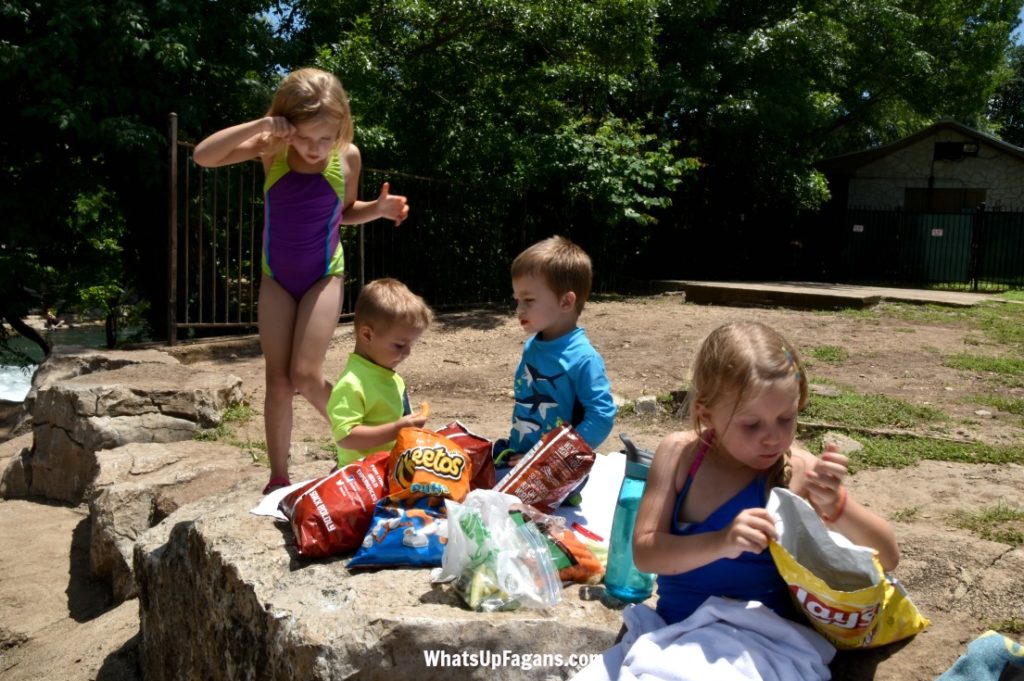
12.) Food. Kids get hungry. Adults get hungry. Think about packing some coolers and food for a snack at the very least. Remember that chocolate things will melt (including granola bars with chocolate) and stick to finger foods as much as possible so you don’t also have to bring plates and utensils. Grab napkins or wipes to clean up hands and faces and be sure to throw any trash away appropriately or take it home with you to do so properly later.
However, sometimes I purposefully don’t bring food so that I can lure my kids away from the fun “so we can go get food” without tantrums. They want food more than they want to keep playing at a certain point.
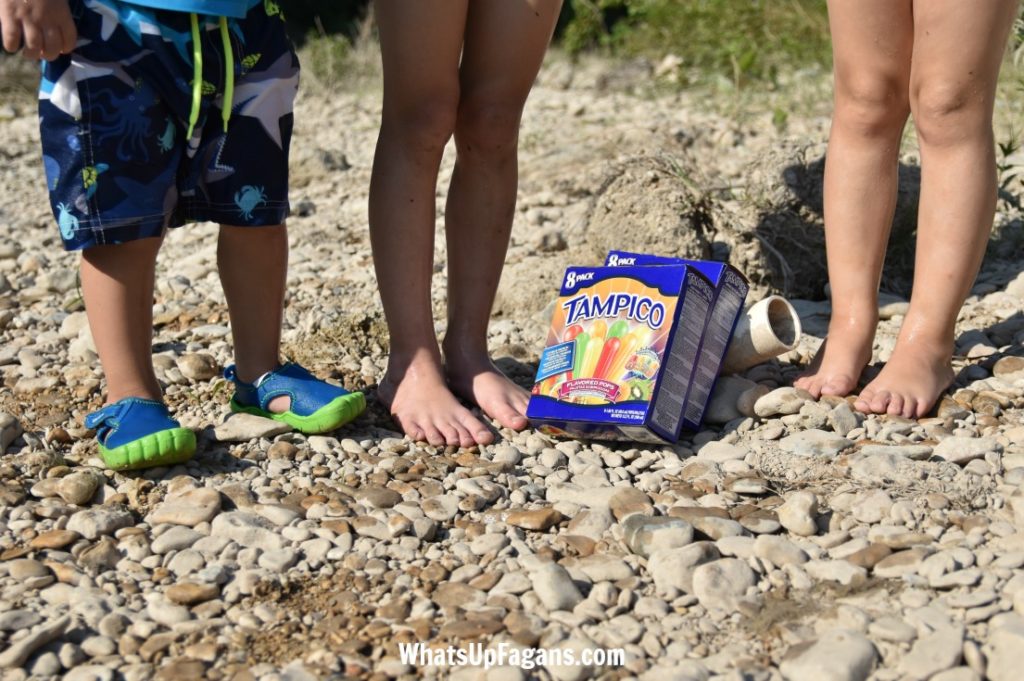
Extras: It’s fun to bring goggles, nets, buckets, and other water toys to the lake, but they are optional. So are things like a bluetooth speaker, water guns, and even a canopy. If you forget them, you’ll survive just fine, but you may want them too.
See this post for more water safety tips for kids.
As long as I have the necessities, and even if I don’t, my family usually has a great time swimming in the lake, which is good because it’s what you do in the summertime here in Texas!
What do you take to the lake with you when you have kids in order for them to be safe and have a great time?
Related Posts:
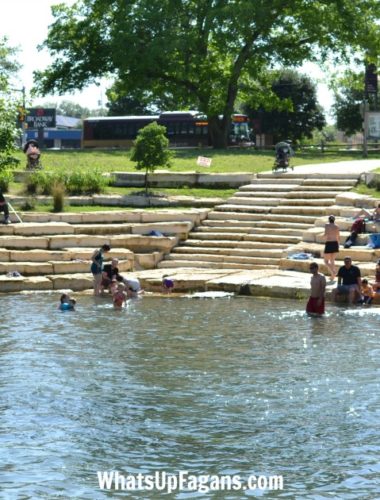

10 Safety Tips for Worry-Free Water-Fun
How Sunshine Benefits Everyone in the Family
Ultimate Guide on Lake Safety for Kids
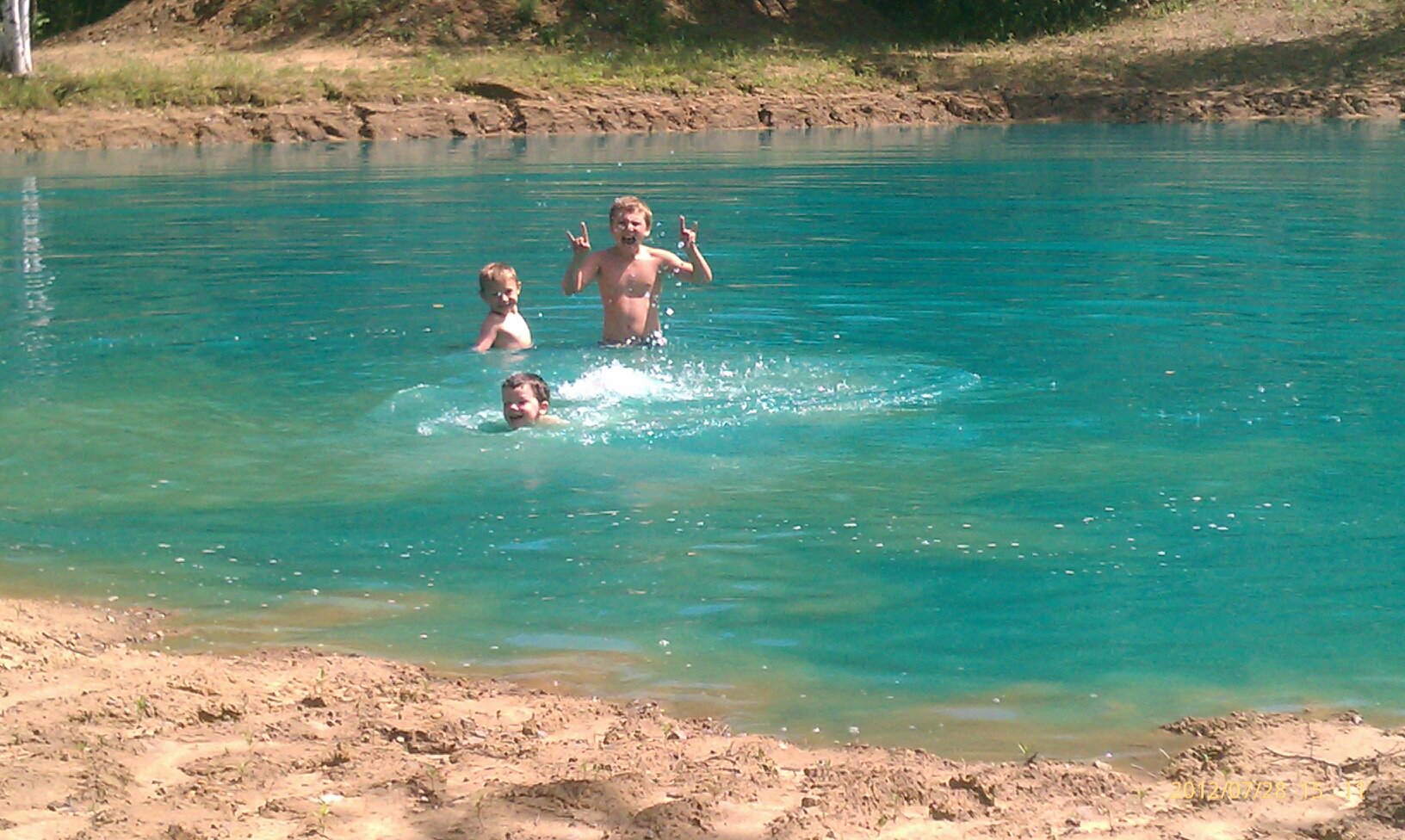
I have been taking my kids to the lake every summer for years. They have years of summer adventure memories playing in the lake and on the shores of lake. They have found some precious treasures throughout the years that they keep in their bedrooms from the lake. Just small trinkets of fun lake memories.
When heading for a fun adventure at the lake with your kids, here are some helpful tips to remember.

Lake Safety for Kids:
Choose the Right Spot
This is a safe lake shore to enter in and out of the lake without any issues. I love this spot because the sand was super soft and we had tons of shade! I had a good view of my kids when they were in the lake. They are older here and still made sure the lake was calm enough for them to play around and explore.
Summer is a great time for outdoor exploration and playing in and around bodies of water. While beaches and pools are safer, sometimes exploring a wild lake seems like the ultimate fun summer adventure.
If you do decide to take your kids to the wild lake for the ultimate summer swim adventure, take some precautions and keep yourself and your kids safe with these lake safety tips for kids.
Choosing the right spot to swim and play in a wild lake is crucial. Explore and observe the lake. Keep walking until you reach a calm shallow part of the lake. It should not have a rush or strong current nearby. Avoid areas of the lake with deep drop-offs or where you have to jump in to get in the water because the lake shore is too high. You want everyone to be able to get out of the lake safely once in.
Types of Lake Shores That Are Safe for Kids
The lake shore should be like a beach where it is shallow enough to gently walk into the shallow calm lake. The lake bed should be easy enough for everyone to safely enter in and out of the lake without any issues. lake water should never reach waist level on any child so be sure the other side of the lake can be accessed by all swimmers without the water level reaching their hips.
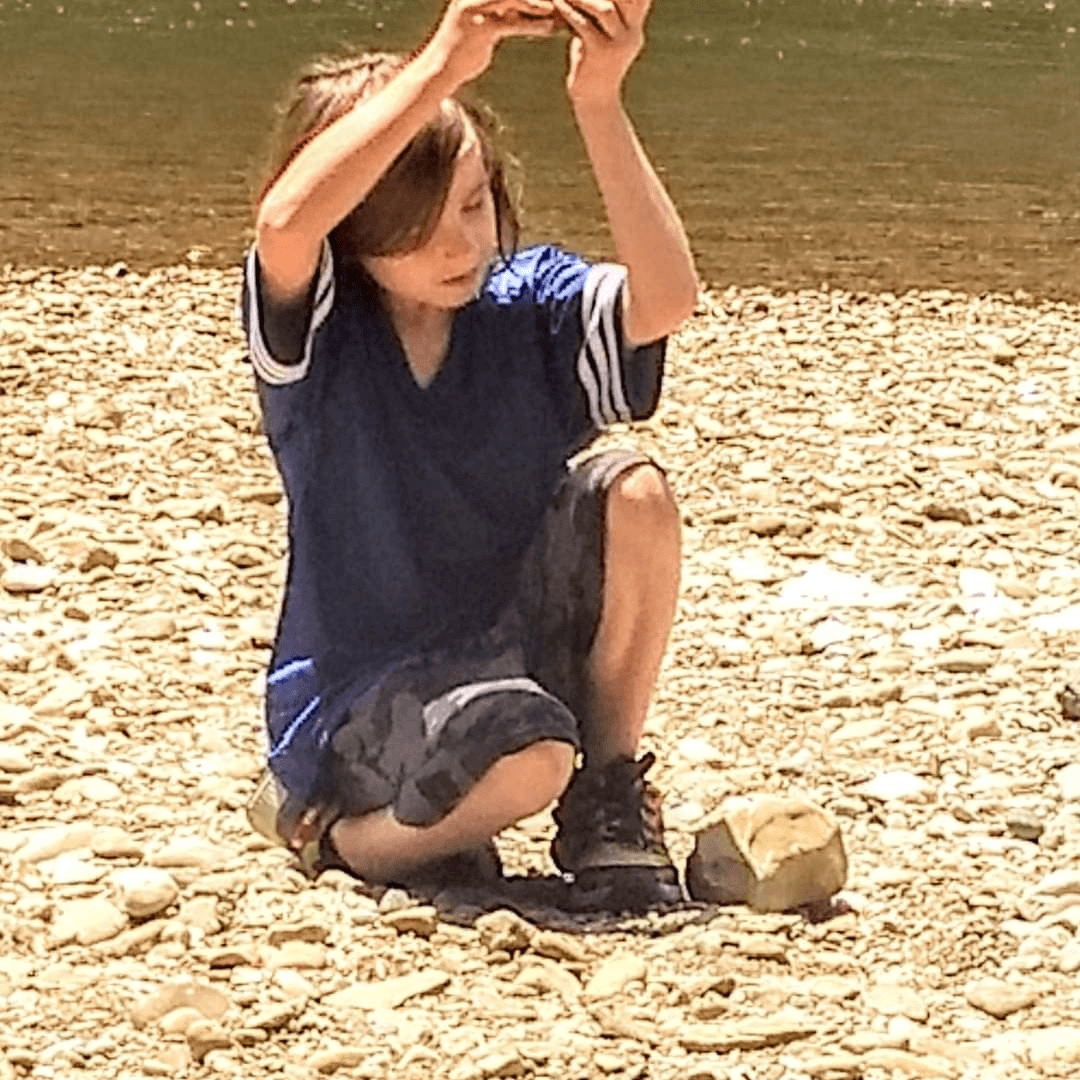
This is another example of a safe lake shore for kids to safely enter in and out of the lake without any issues. My sons were able to enter in and out of the lake and explore this area of the lake for hours. Rocks and sticks can keep kids busy!
Find a good safe lake shore with a good view of the lake and shore without too much overgrowth of vegetation that will block the views of your kids playing around the lake water. You want to be able to see everyone on the shore and in the lake at all times. Do not allow kids to walk along the lake shore away from you and others into heavy vegetation. They could slip in the lake and you would not be able to see them.
Avoid Thick Vegetation Areas
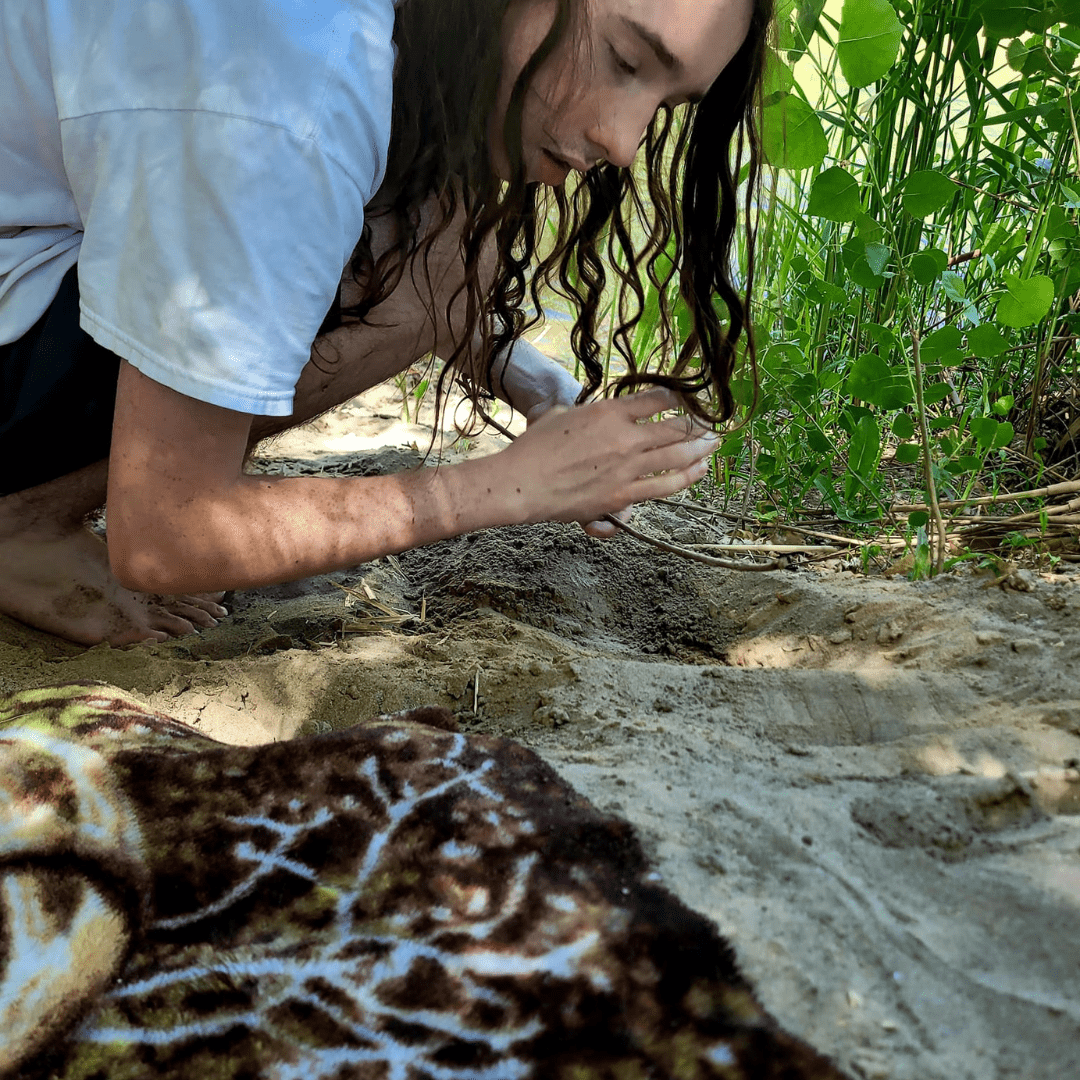
This lake shore had some vegetation, but I never allowed the kids to enter through the tall vegetation and I kept an eye on everyone at all times. A lake shore with soft sand is fun for kids of all ages including teenagers to explore and use their imagination and to disconnect from WI-FI for a few hours. Nobody complained about wanting to play on their X-Boxes while we were at the lake for hours! It was like they totally forgot about WI-FI and were having fun at the moment in nature.
Do Not Allow Kids to Wander in Thick Vegetation Near Lakes
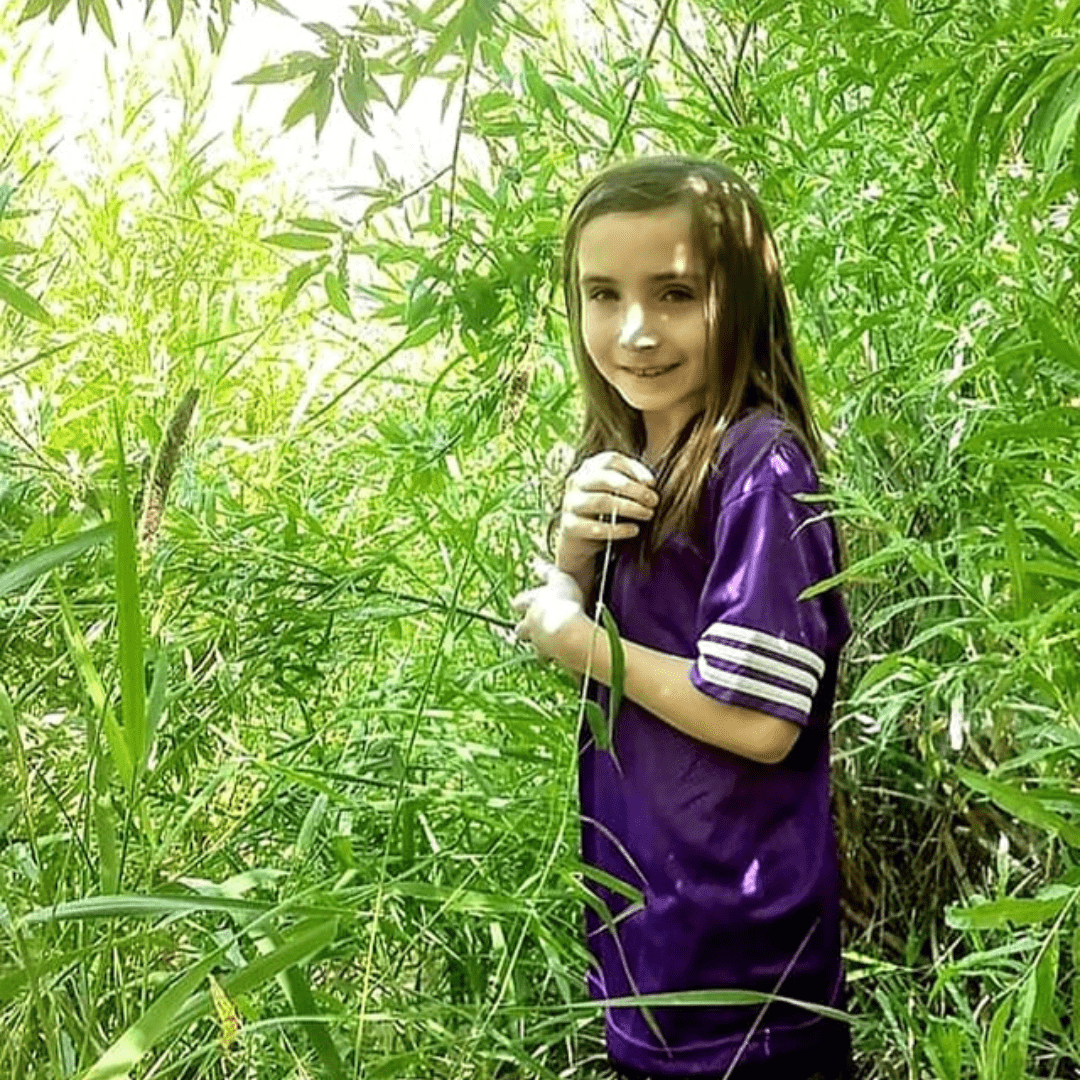
Kids love to explore the outdoors. When you are around a lake, never allow your kids to enter thick vegetation along the lakeside at any time. You can easily lose sight of them and they can quickly fall into the lake and who knows how strong the current will be? This is a situation to avoid.
In this photo, one of my sons really wanted to enter this vegetation. I explained to him that this is very dangerous since we can hear the rushing lake water just on the other side of this heavily thick vegetation. Explain to your curious kids that as they enter thick vegetation near a lake, the ground could be muddy and slippery and they can easily lose their balance and slip right into the rushing lake. We kept walking to find a safer area.
As fun as exploring a jungle mess of thick vegetation and pretending you are in the jungle can be, avoid this temptation at all costs. Keep walking and find a more clear and safe area to explore the lake.
Lake Safety for Kids: Consistent Water Supervision
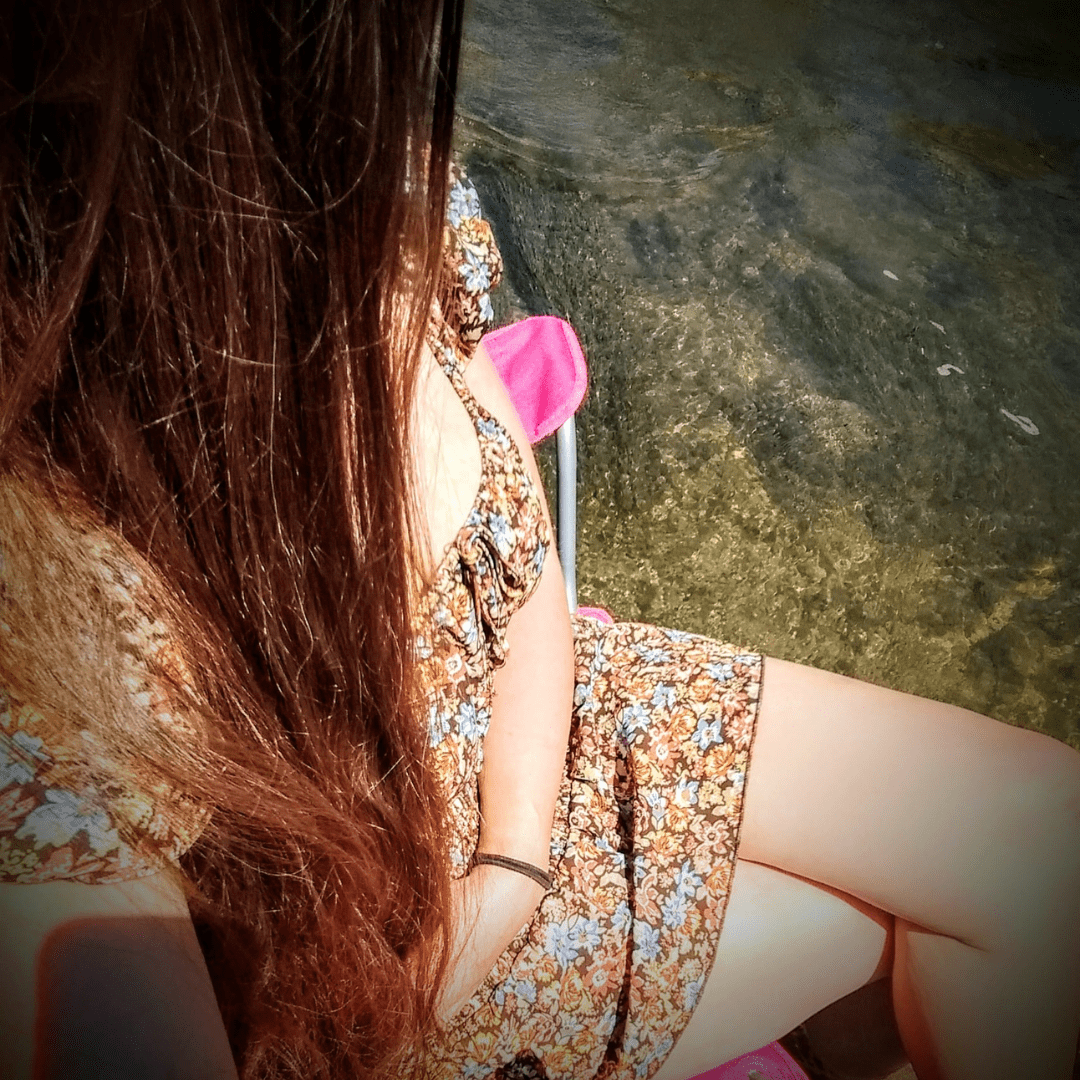
When you have kids playing in or around water, you need to have consistent supervision. Get close to the water and be within reach quickly should your kids need your help. Here I am sitting in the lake in my camping chair. I did not feel like swimming, but wanted to be close to my little swimmers and lake explorers.
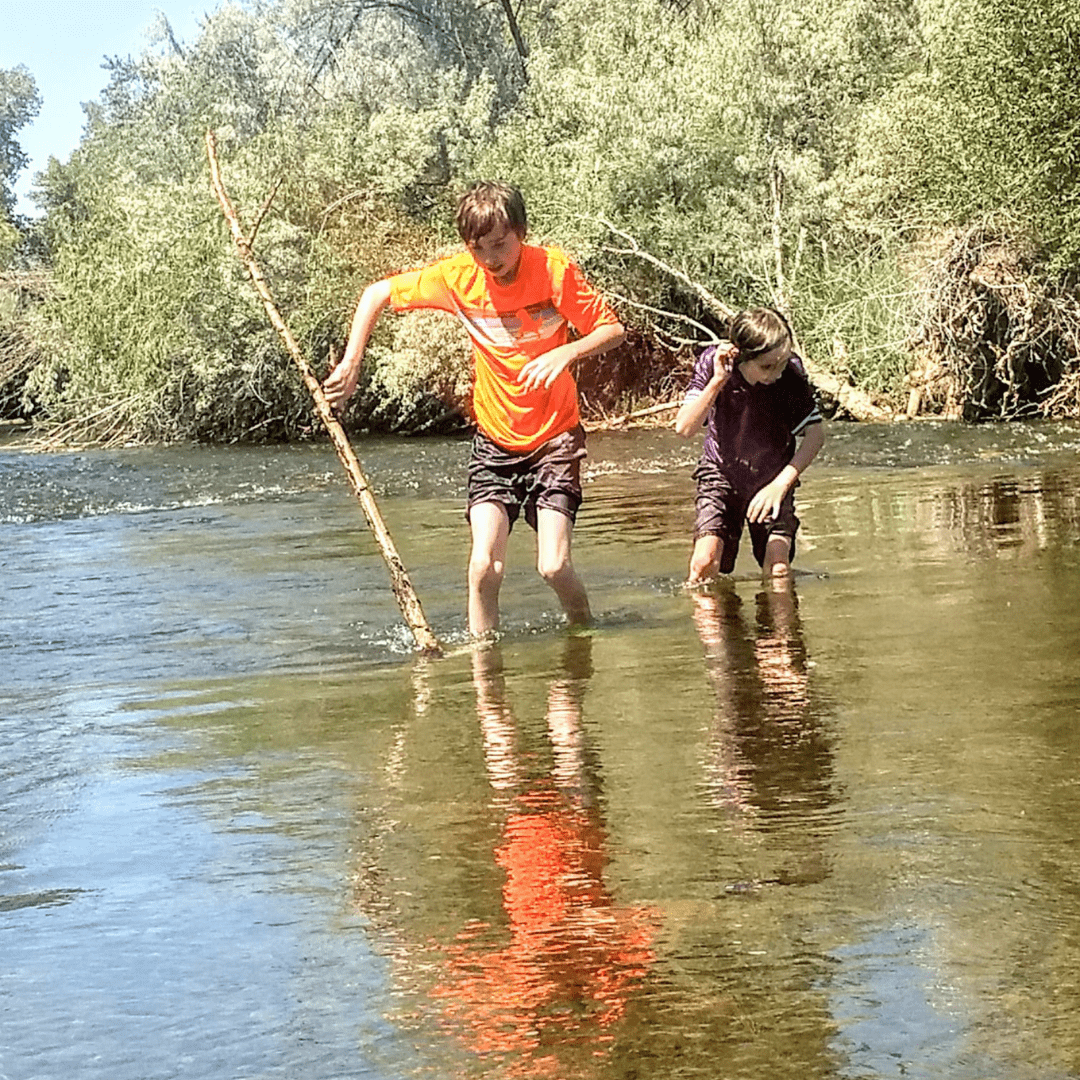
Again, always ensure every part of the lake where your kids are playing never reaches to their hips. Kids of all ages will still have a ton of fun in safe shallow lake water. As you can see in the photo, my kids are older and still exploring and having fun.
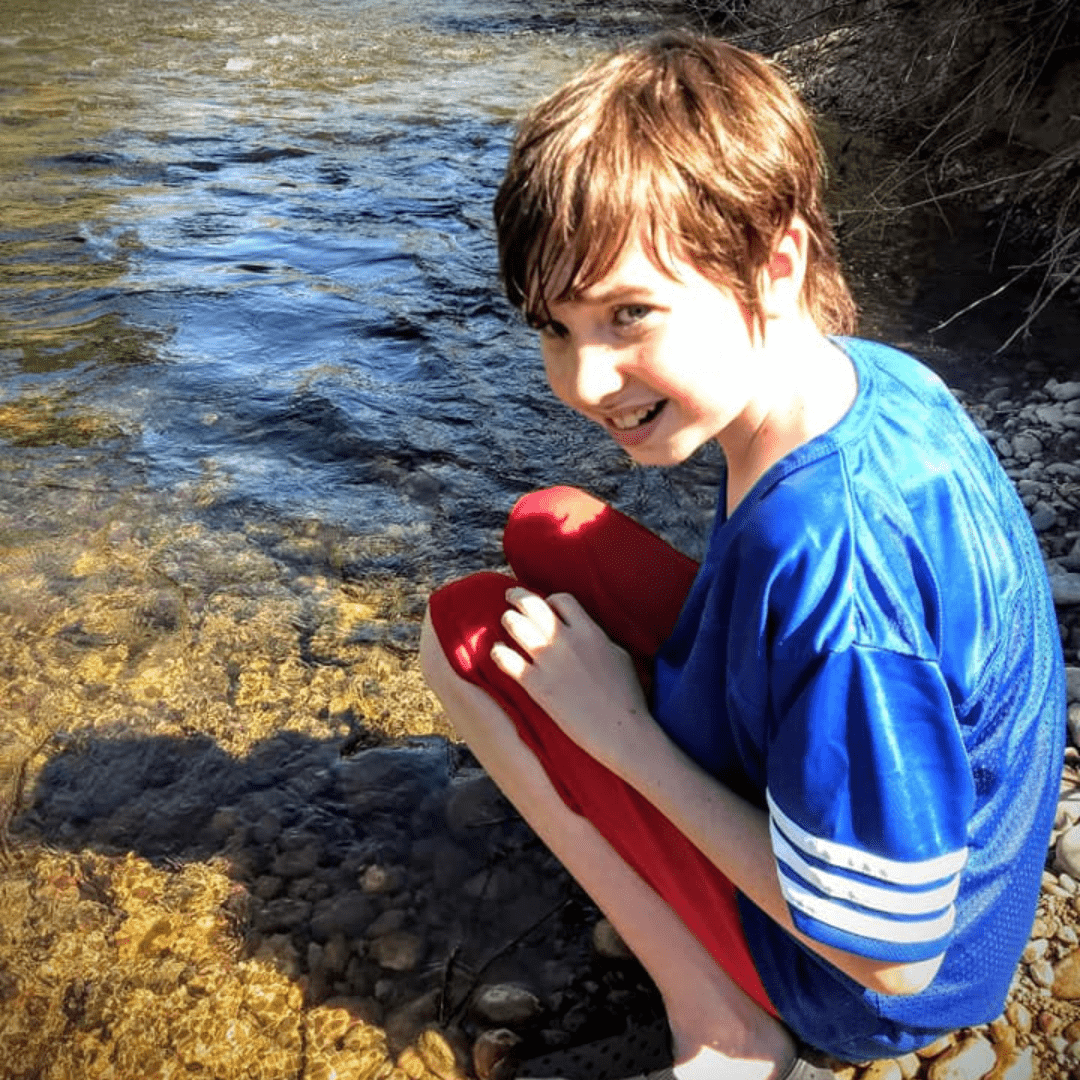
Cooling off in the cold lake on a hot summer day makes the perfect afternoon. If you and your kids desire to explore the joys of the lake, just remember to do it safely!
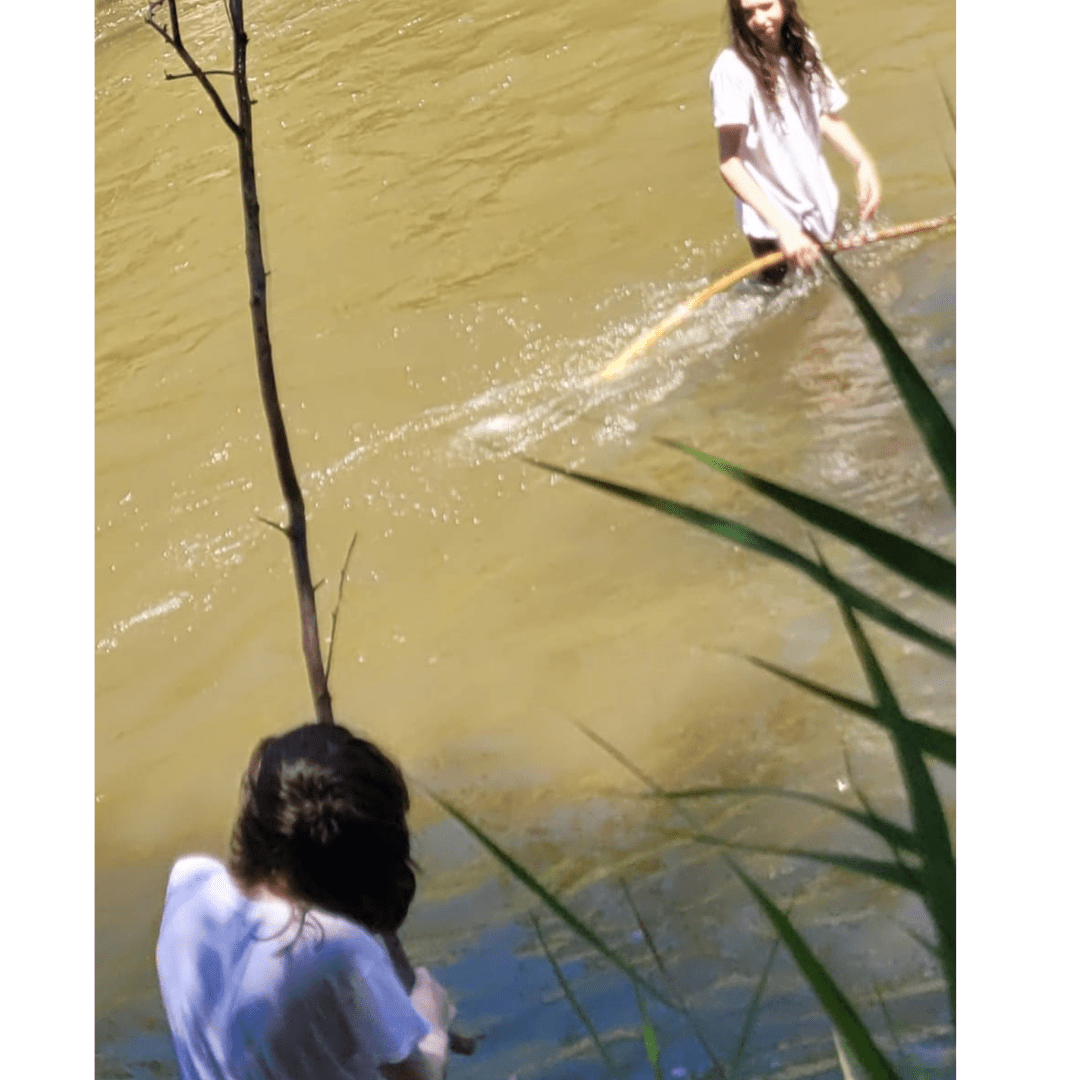
Teenagers can have a ton of fun in the lake playing. In this photo, my teenage sons are having fun with large branches that they wanted to watch float away down the lake. As you can see, the lake water is a bit high, but not reaching their waists.
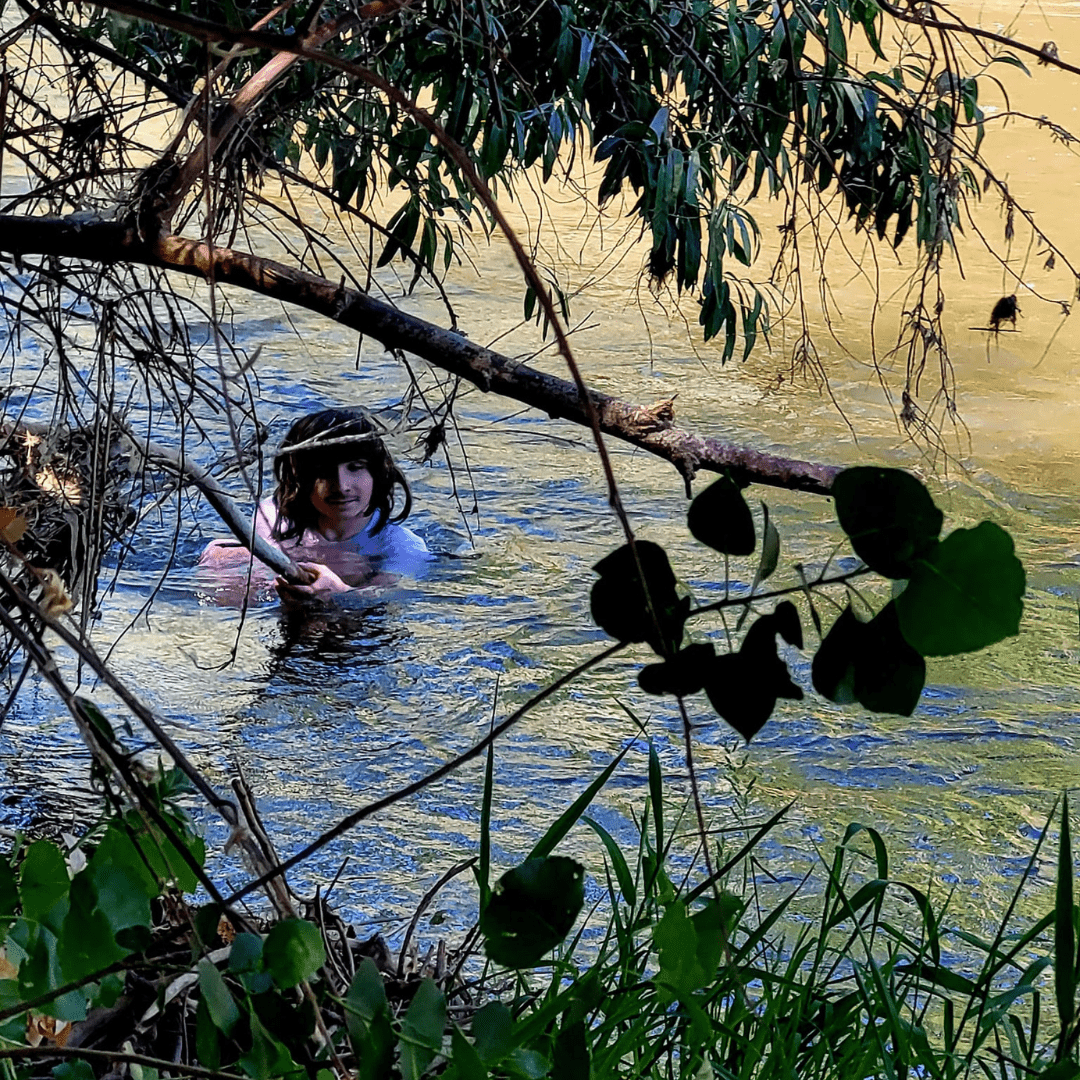
You may think that this son of mine is dangerously in deep water, but fear not, he is sitting down!
Lake Rope Swing Safety
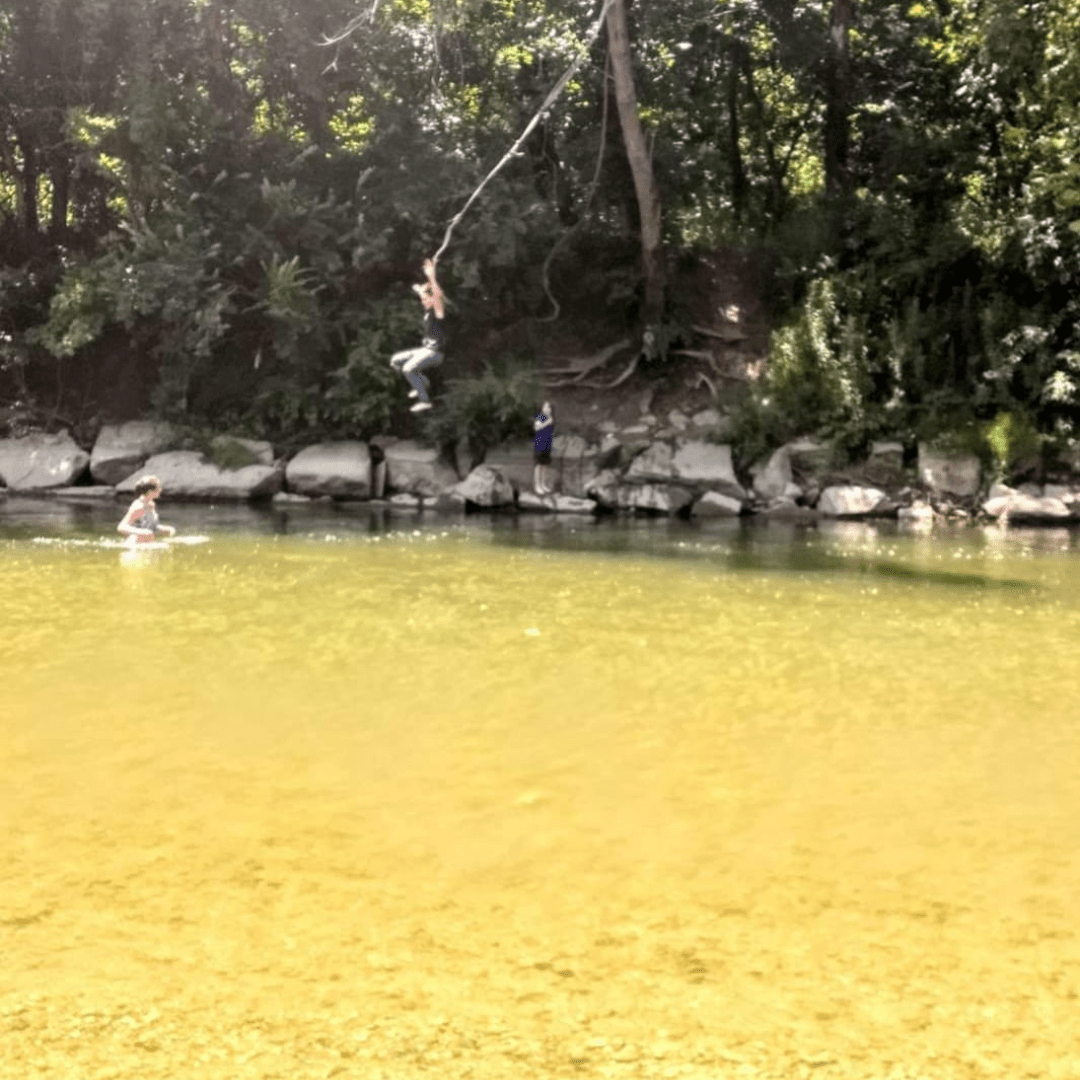
My kids attempted their summer goal of taking a daring shot with the lake rope swing one summer!
A trip to the lake would be pointless if you never got a shot at daring the lake rope swing! If your little daredevils want to conquer the lake rope swing this summer, here are some lake rope safety tips to keep in mind.
Lake Rope Swing Safety Tips
If a lake rope has been installed, inspect it for safety. You may never know how long it has been there. If you can, take the first swing and plunge into the lake! Ha! If the rope will hold you, it will hold your kids.
Inspect the depth of the lake water for safety. If the water is too shallow, you may need to find something else to do! If it is too deep, tell your kids that you are uncomfortable with this daredevil stunt and prohibit them from doing it.
Make sure you, another adult, or older kids are always in the lake to assist the daredevils who swing off the rope should they need help once they are in the water.
Local Wild Water Exploration
Nature activities to do with the kids in wetlands

Want to sell the idea of a family walk to the kids? Here are our 10 tips to whip up some enthusiasm!
All year round, wetlands around the local waters are buzzing with life. Whether it’s watching ducklings follow their mothers in spring or the exciting spectacle of waterbirds in winter, there’s plenty to see and do for little (and not so little) ones.
We asked WWT team members how they spend time outdoors with their families. Read on to find out how to whip up enthusiasm for a lovely family walk, whatever the weather.
Water Activity 1:
Go on an adventure
Waters are the perfect place for adventures.
Cross wibbly-wobbly bridges, dart across stepping stones and put your balancing skills to the test! Zig-zag along winding paths and play hide and seek amongst the trees.
Or why not learn survival skills and hunt around for fallen branches, sticks and leaves to build a cozy den?
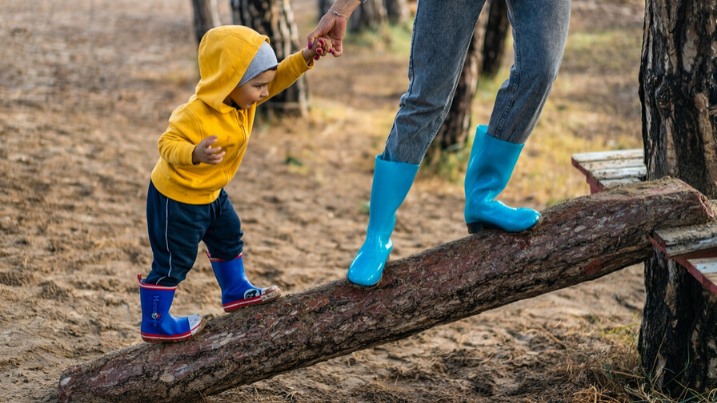
Water activity 2:
Play pretend
Who can do the best impression of a duck?
Make Waters come to life by playing pretend and inventing a mini-story about your Water creatures. You’ll have the whole family waddling, quacking and rolling on the floor laughing.
Once you’ve finished, you’ll just need to find the perfect spot for your kids to perform their best impressions. We promise; you’ll be in stitches.
Water activity 3:
Grab your wellies and splash about
A rainy day? Not a problem.
Waters are perfect for kids who like to splash in puddles. Grab your raincoats, don your wellies (muck boots) and see who can make the biggest splash! Some of our centers run dedicated puddle-jumping events to turn wet weather into fun, so keep an eye on your local center info page to see what's coming up.
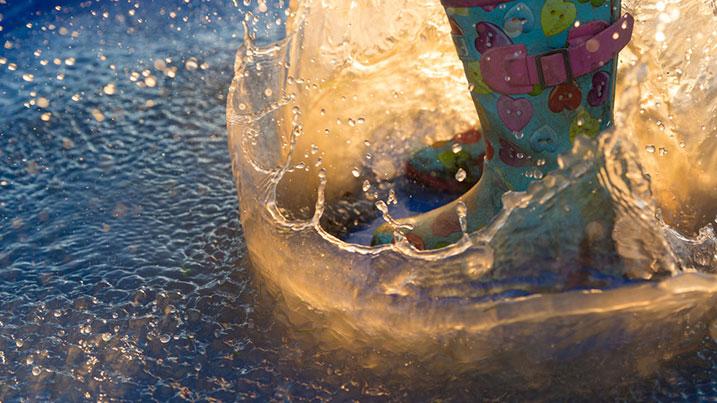
Water activity 4:
Spot some spring chicks
There’s something magical about seeing the first chicks in spring. From downy ducklings to gangly goslings, Waters are packed with fluffy young chicks in the spring and summer, and even in very early spring you can see exciting signs of ducks courting and nesting.
Keep those eyes peeled: you might see a protective adult bird keeping a watchful eye over the nest.
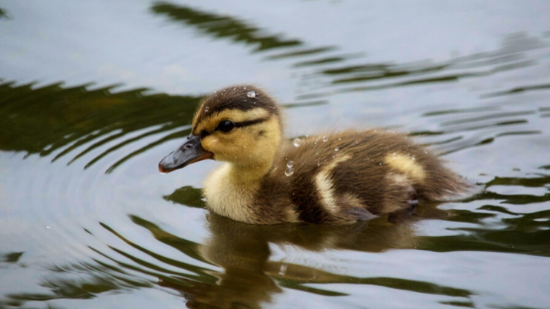
Water activity 5:
An excuse to spend time outdoors
After a winter tucked away, it’s invigorating to get out and about in the great outdoors.
Waters have amazing benefits for health and wellbeing. Whether you want to get the family running around again or you simply want to inspire the little ones by watching some wildlife, it’s a great way to have some family time outdoors.
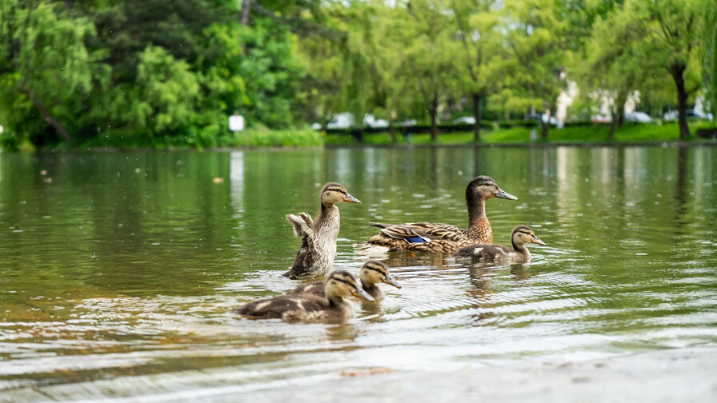
Water activity 6: Brush up on your birds
Don’t know your coots from your moorhens? Test your own bird watching knowledge while teaching your kids all about amazing Water wildlife.
You’ll be amazed by how much you learn by exploring Waters each season.
Here are some of our top tips for beginner birdwatchers, young and old.
Water activity 7: Look for creepy-crawlies
Don’t forget your magnifying glass! It’ll help you to get a closer look at those mini beasts under the lens. Root around under rocks and stones, hunt under logs and see what insects you can find this Spring. There are lots more creatures lurking under the water’s surface. From tadpoles and frogs to toads and water boatmen, who knows what you might find? Watch out for snappy crocodiles!
We’ve got lots of tips for bug dipping - check them out here
Water activity 8: Get imaginative
Family games are lots of fun, and the Waters are the perfect stage. Have you thought of coming up with a new dance inspired by Water wildlife? What about playing spot the difference?
Get those imaginations running wild by asking the kids: why do birds have wings while amphibians don’t? Why do swans have webbed feet?
Waters are the ideal place to get your kids thinking about the science behind wildlife, all while having some splishy splashy fun.
Water Activity 9: Become a Water Explorer
Is yours a house of budding explorers who love their wildlife? Hand out some pens and pads so you can challenge the whole family to see who can spot the most water wildlife.
Did you know sand martins arrive in the UK in spring following their long migration from their wintering ground in South Africa? If you know what to look out for each season, you can have fun seeing who will be the first to spot the signs of spring, or the first winter swans.
Water activity 10: Bring the wild home
We know that it's not always easy or even possible to get out the house. That's why you can find a whole range of activities to do at home on our Fun and Learning hub - from homeschooling lessons to nature-based activities for indoor and outdoor entertainment (away from the screen). We add new activities every so often so be sure to check back.
Superscript
15 Water Activities for Kids & Ways to Get Active on the Water
It may be back to school season, but there’s still LOTS of summer left! Temperatures have been soaring around most of the U.S. over the last couple of weeks. It’s only natural that many of us have been gravitating toward the water to catch a break from the heat! Today, we have the amazing Chelsea Furlong, photographer and mom of 2, here with 15 kid-friendly ways to get active on the water this summer! Not only will these water activities for kids keep them cool, but they’ll help with swimming skills, improve balance and coordination and wear them out! This post is sure to inspire you to get outside and into the water as soon as possible!
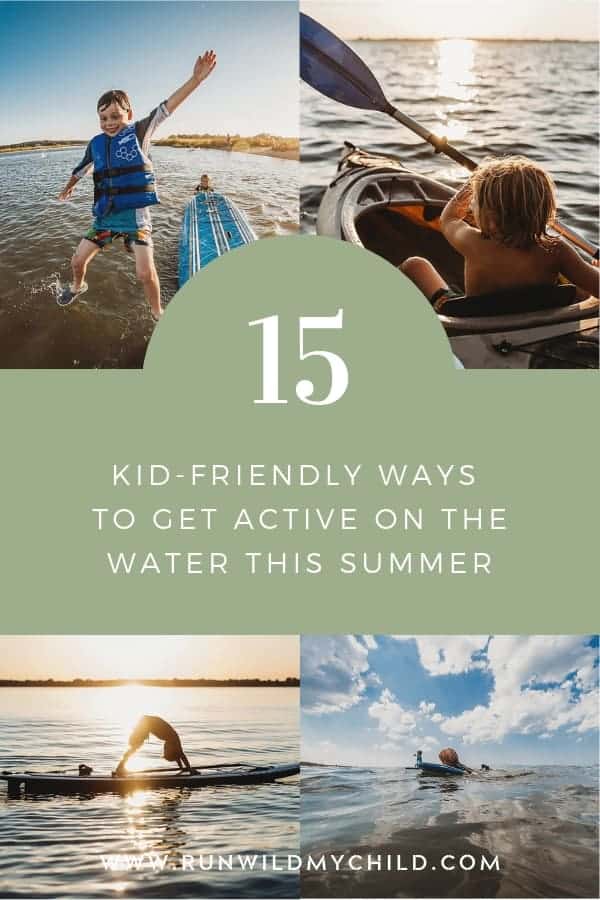
Get active on the water
Summertime is the BEST time to get active with your family and it’s extra fun when the activities involve water. With two very busy kids in our house, we’re out adventuring on the water almost every single day. We’re lucky to live in Virginia Beach where the weather is warm most of the year and the beach is nearby, but we’ve done lots of these water activities for kids on lakes and rivers all over the East Coast!
Benefits of spending time on the water
As my children continue to grow, our list of family activities to do on the water grows right along with them. Each summer we’re able to add a few more fun water activities to do together that we weren’t quite able to do the previous year. We love being able to create so many incredible memories with our children while also getting plenty of exercise! The more time we spend outside together, the happier we all are. And it doesn’t hurt that the kids are nice and tired when bedtime rolls around!
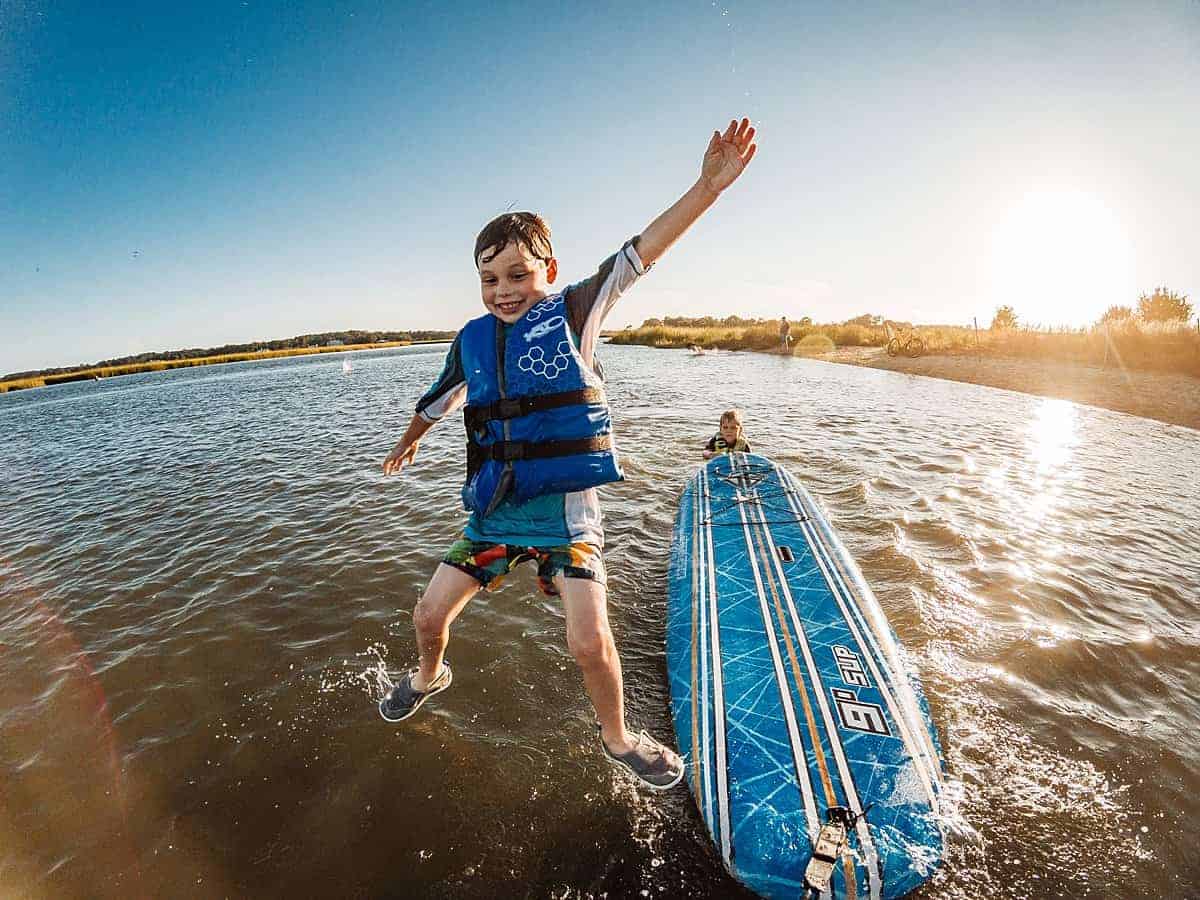
15 kid-friendly ways to get active on the water
Getting outside and active on the water doesn’t have to be hard. And it doesn’t have to be the same old thing again and again. There are so many ways to enjoy the outdoors and keep cool. Here are 15 different water activities for kids that will get your kids outside and active on the water this summer!
1. Stand up paddleboarding
Stand up paddleboarding has become one of our absolute favorite summertime water activities for kids. We started when our kids were young (ages of 4 and 6), so our kids are now great at paddleboarding alone or just sitting along for the ride. Stand up paddleboarding is a great full-body workout. While you’re balancing, your body is using your core, shoulders, arms, legs, and back. If you’ve done it before, you know that it’s even great for foot strength! You’d be surprised at how tired your feet will get from gripping the board to balance.
Our kids also love to play a game they call “Paddle Battle.” They stand on opposites sides of the board, facing each other, and rock the board from side to side to try to get the other person to fall off the board first! They can play this game for hours and never get sick of it! They enjoy climbing up onto the boards and jumping off of them as well. If you’re not comfortable heading out for a long paddle, your kids will have a blast simply playing around on the boards. They’ll come up with all sorts of fun games!
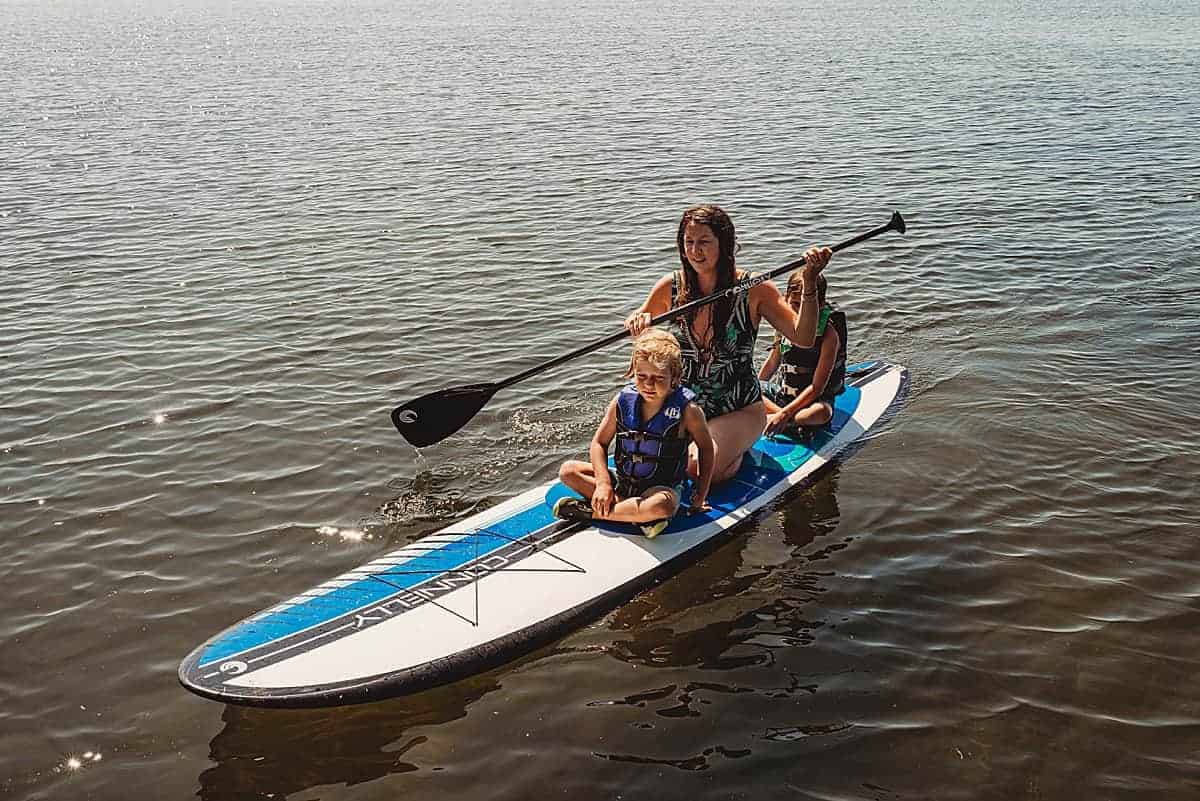
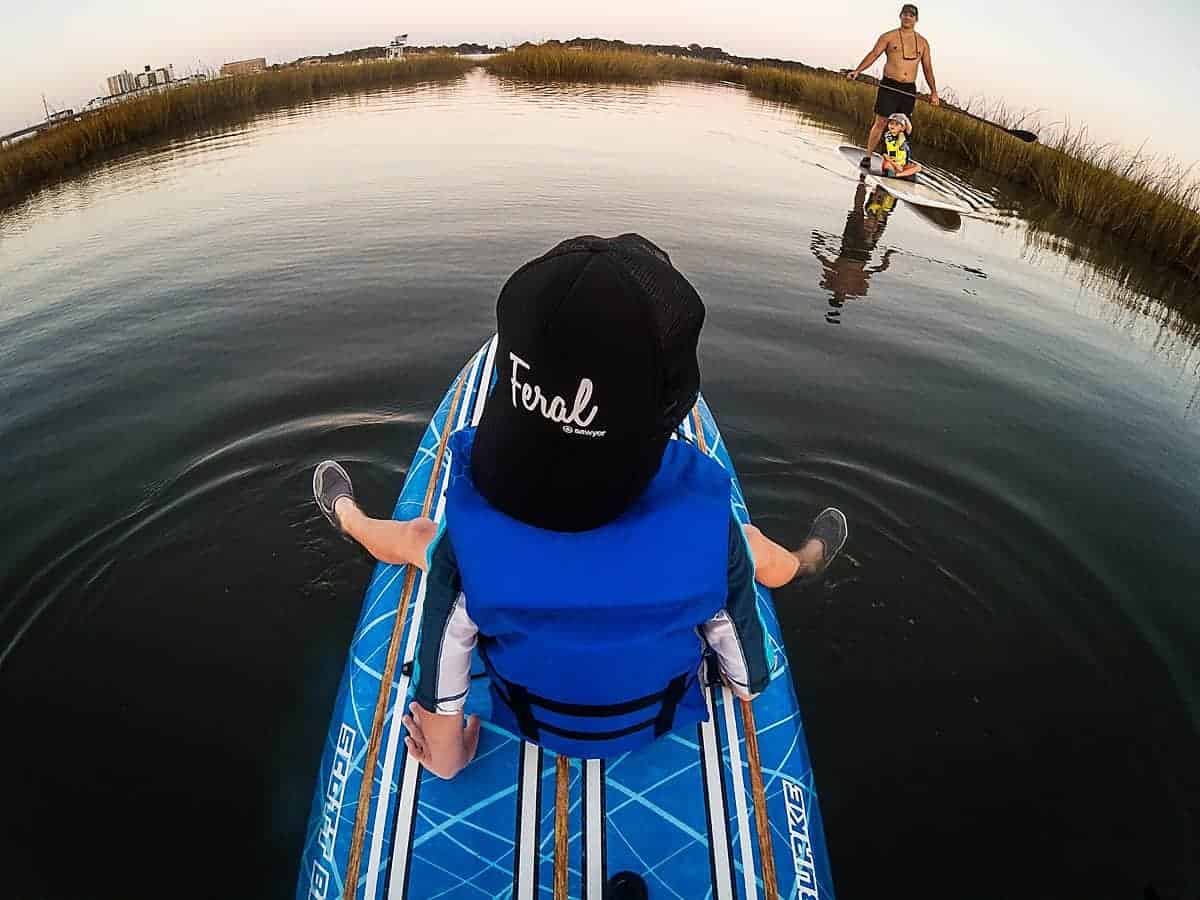
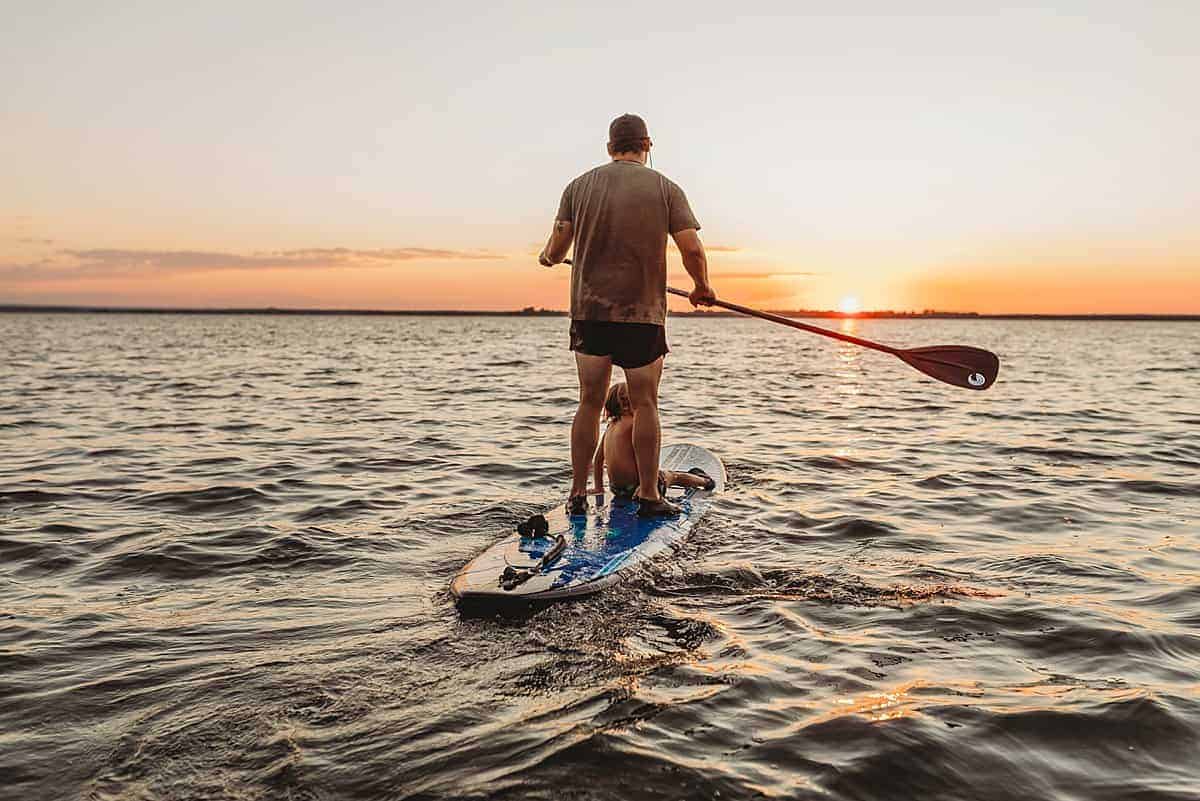
2. Kayaking
Another favorite water activity of ours is kayaking. Depending on the age/size of your kids, they can join you on a ride or paddle along in their own kayaks! Our kids have learned to kayak on adult-sized kayaks. However, there are wonderful kid-sized kayaks that you can use as well. You’ll be surprised how quickly children will learn how to use their paddles to navigate a kayak. And if they’re able to go a distance on their own (even in very shallow water where you’ll easily be able to walk to them if they need help), the pride on their faces from that sense of independence is absolutely priceless. It’s like learning to ride a bike for the first time!
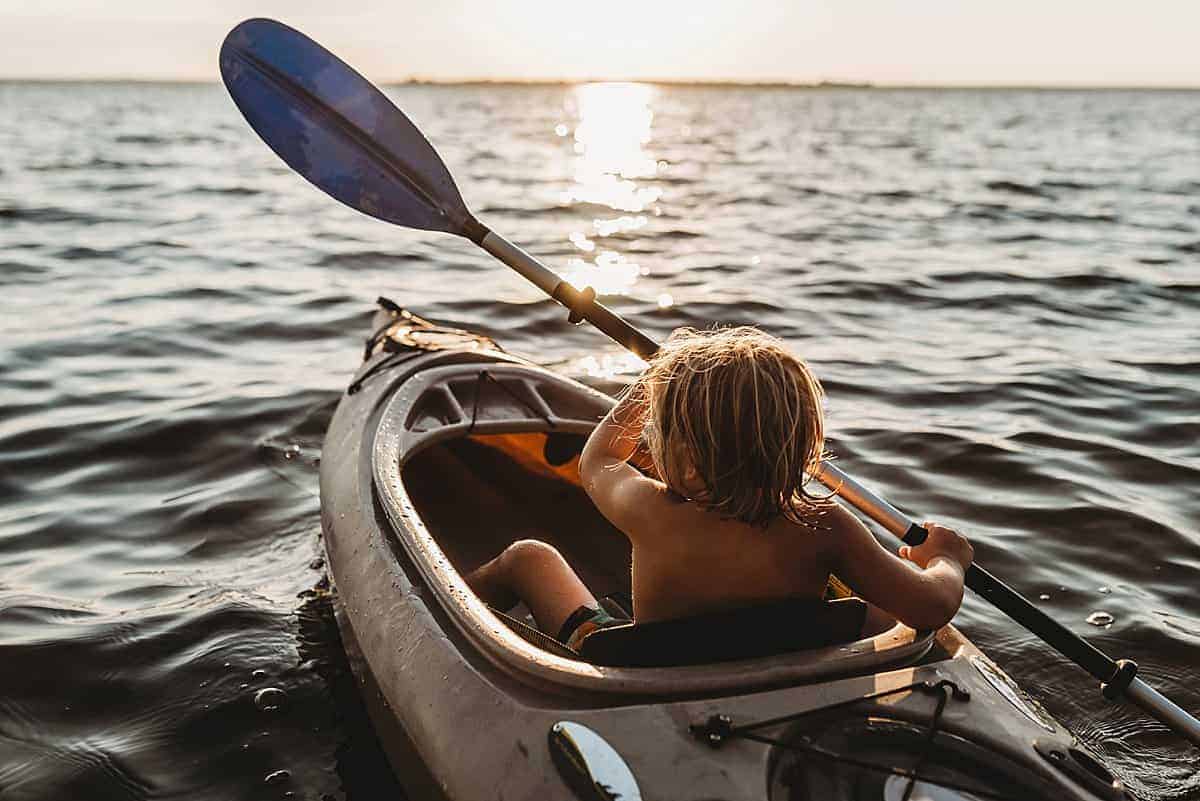
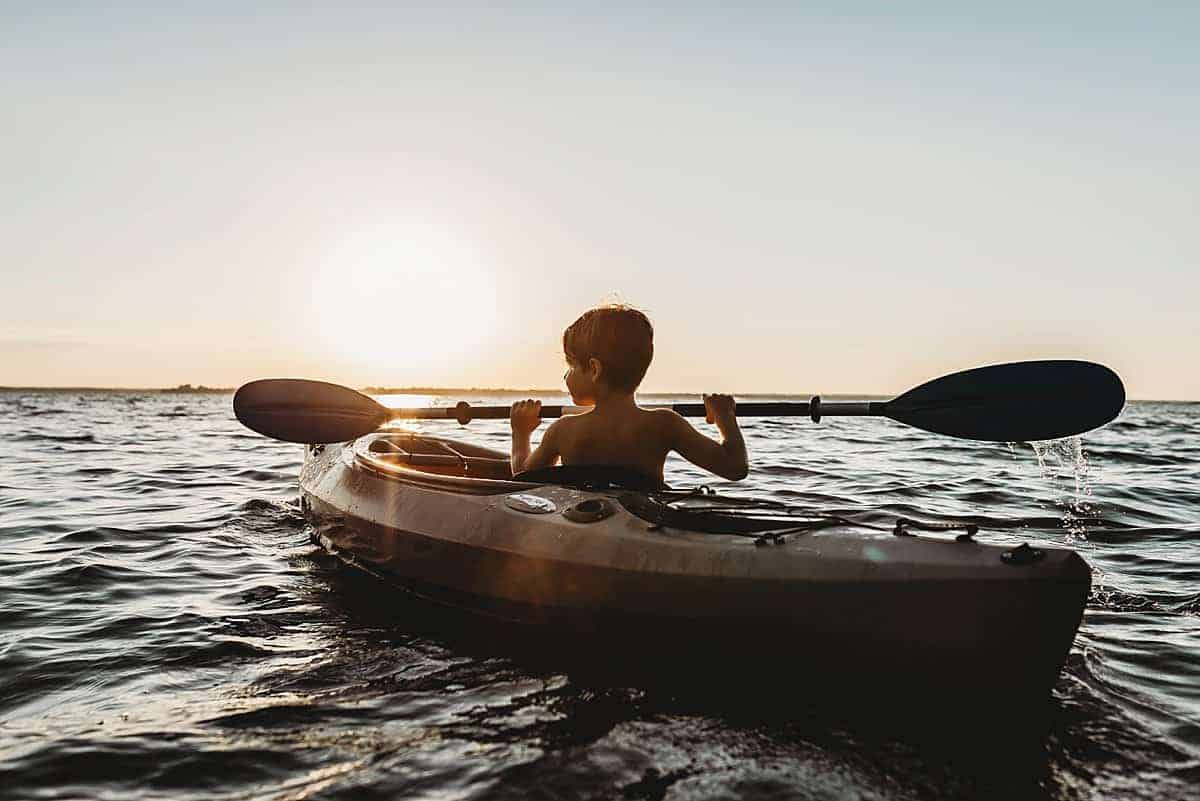
3. Hiking or trail walking
Sometimes our favorite water activities for kids involve more than just water. Whether you’re near an ocean, lake, river, creek or stream, you should be able to find lots of great walking trails close to water to enjoy! Here on the coast, we have several boardwalks, as well as walking/hiking trails along the inlets. If you’re further inland, you can usually find great hiking trails in state parks or up the mountains beside rivers and waterfalls! If you have young children, it doesn’t even have to be a very long distance. Just a quick trail with water to toss some rocks into will thrill them!
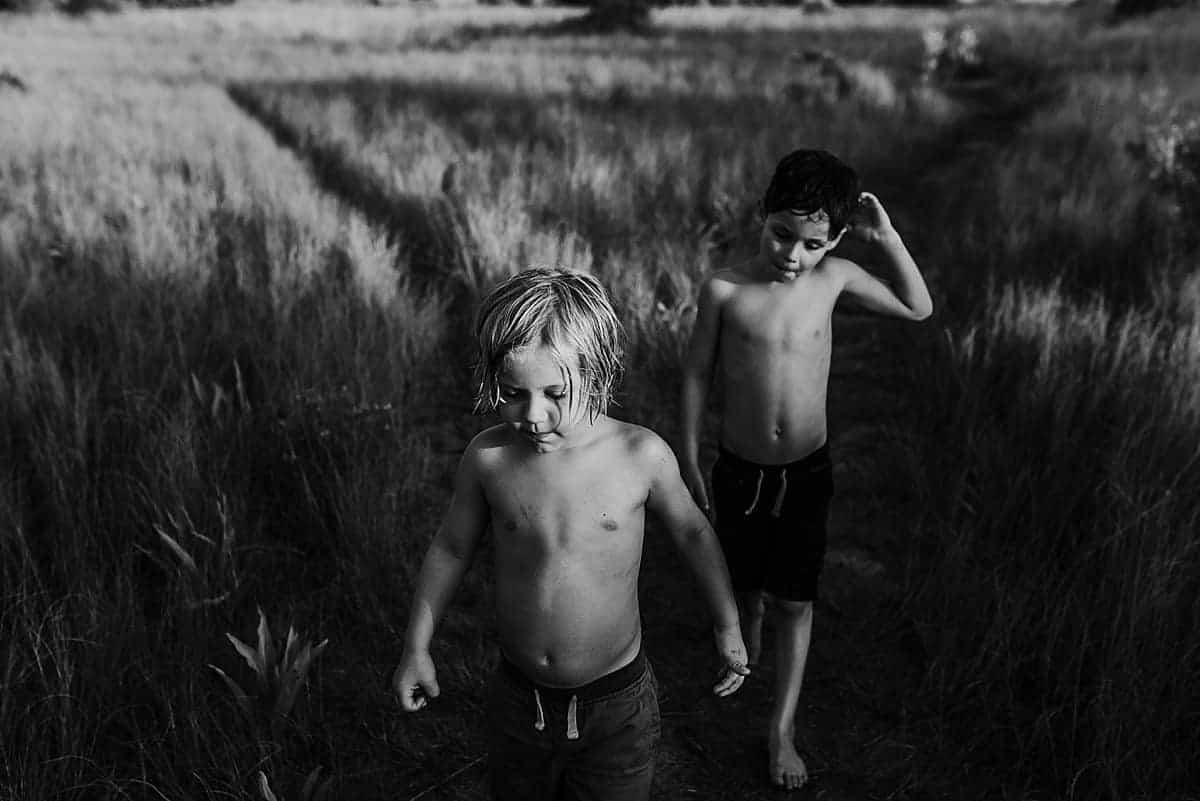

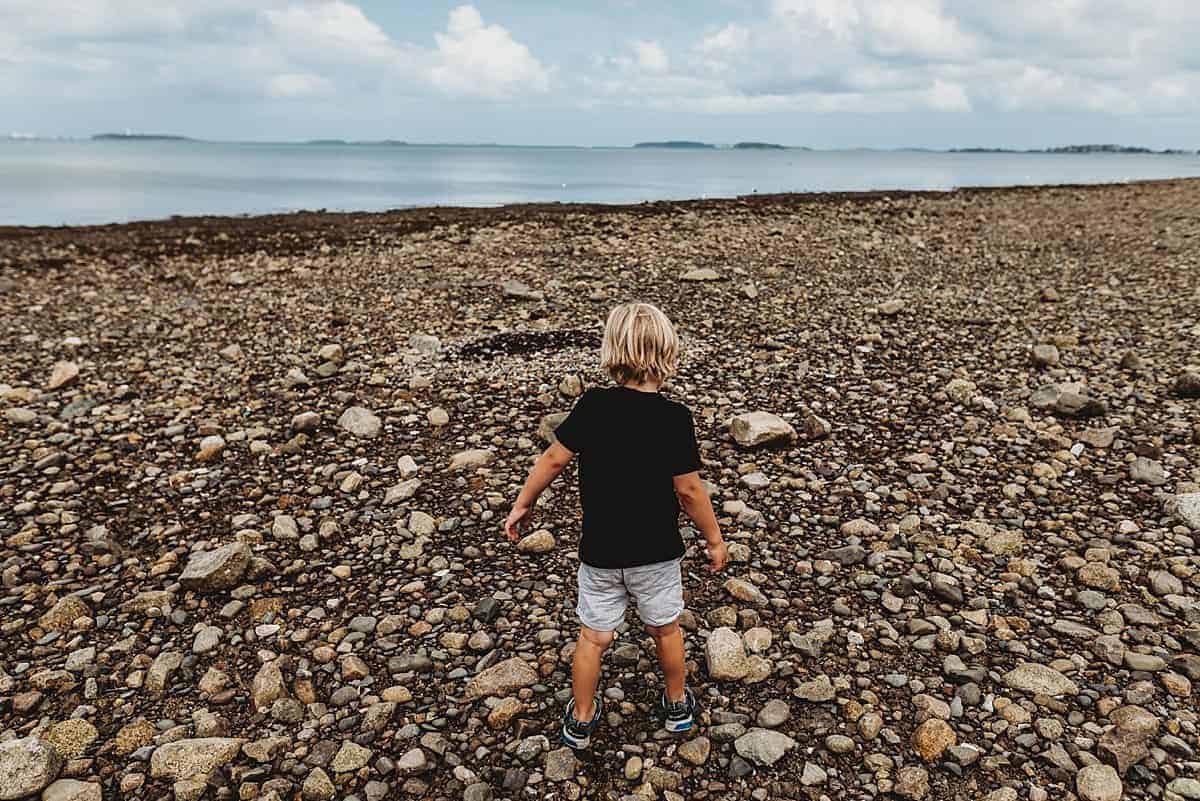
4. Nature hunts
Along those same lines, nature hunts can be an amazing way to spend a few hours by the water! We often find ourselves out on a nature hunt during that rough late afternoon/early evening timeframe when it’s too early for bed, but the kids aren’t tired yet. You know what I’m talking about. That’s a perfect time to go out for a nature hunt if you have some water nearby. We’ll walk or ride bikes to the beach or inlet, and the boys will search for bugs, crabs, turtles, birds, snails, etc. They’re never disappointed.
Kids are so curious – they can find some kind of amazing treasure wherever they go. Even a new rock and a stick is enough to excite my kids. You can either come up with a specific list of items for the kids to search for, find a list online, or forget the list and just see what you happen to come across. No matter how you decide to do it, the exercise, fresh air, splashing, and nature treasures will always be a crowd-pleaser.
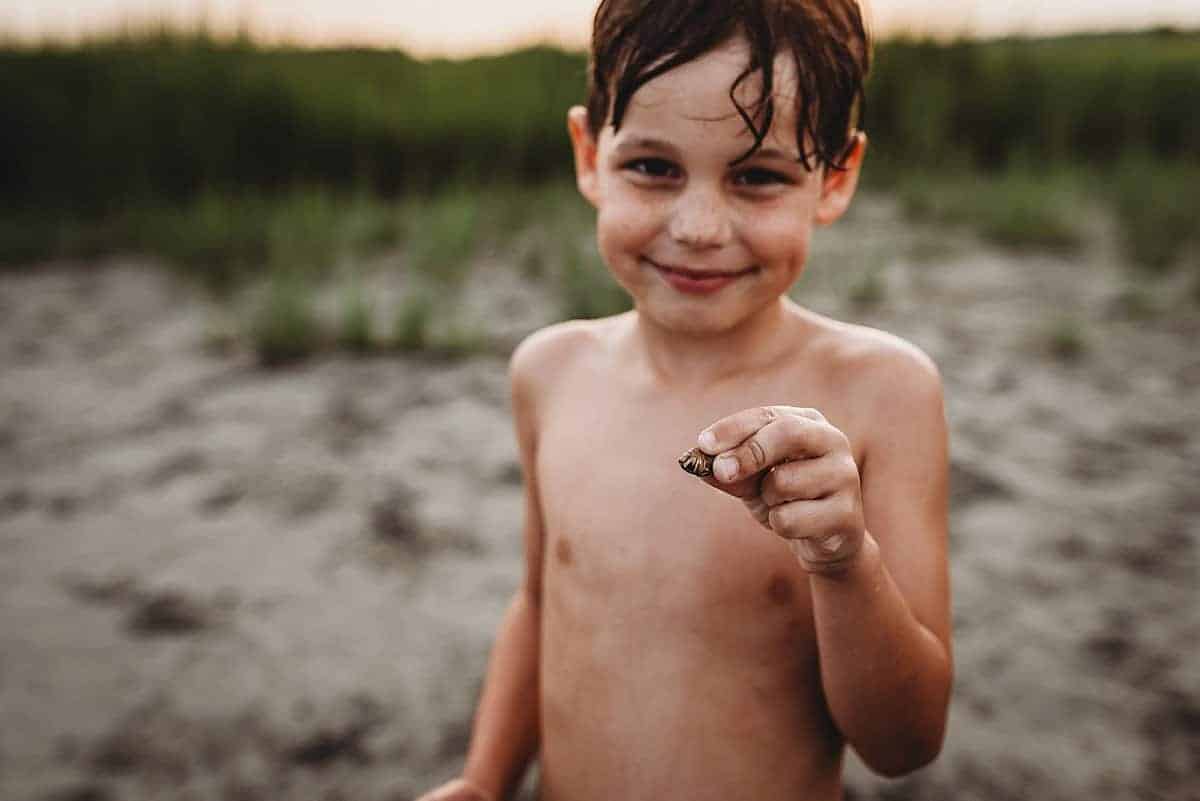
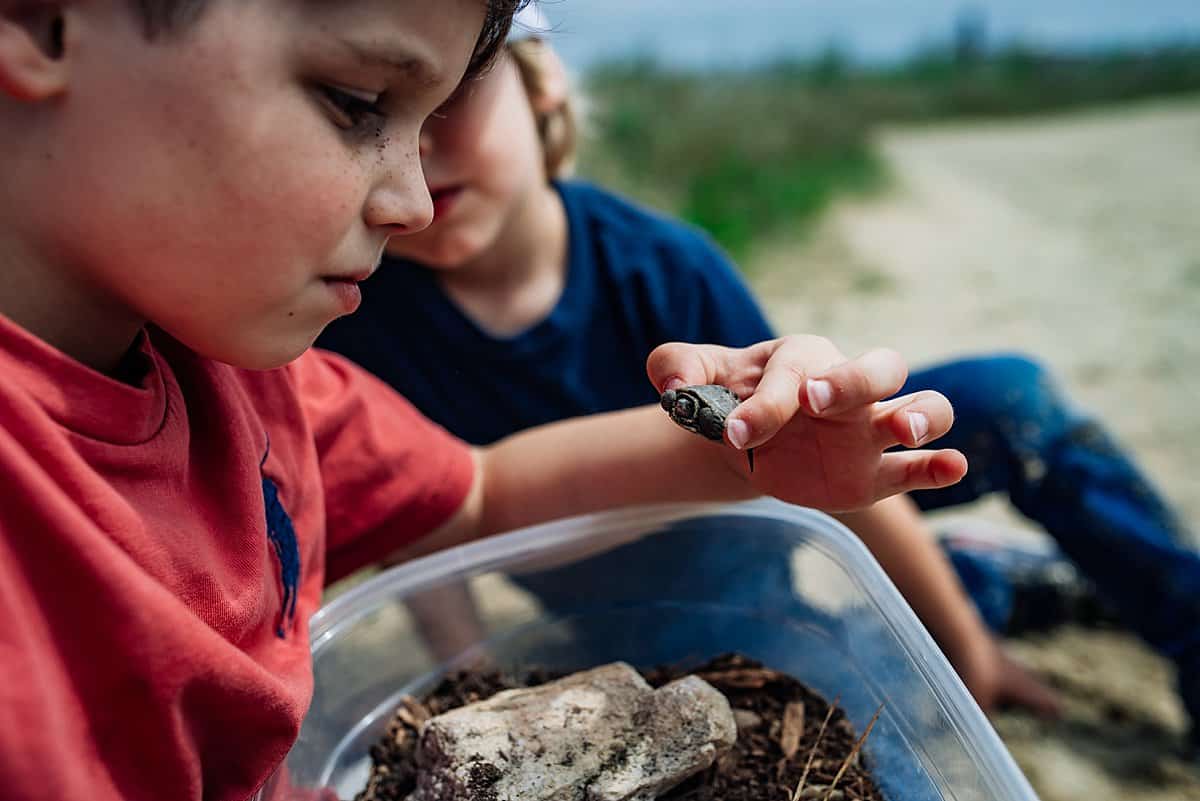
5. Pedal boating
Another great way to get active on the water is to cruise around on a pedal boat! I remember trying these out as a kid when we were on vacation at places like campgrounds with ponds or lakes. Sometimes local parks will have these for rent on the lakes. My kids are lucky because their grandmother happens to have one for them to play on at camp! And they love that thing!
Last year their legs were a little short so the adults ended up doing most of the pedaling. This year, however, both boys had both grown quite a bit and were able to reach the pedals on their own. Pedal boats are a surprisingly good leg workout and if you pedal around enough, you’ll likely feel it the next day! Our kids love cruising around where there’s lots of seaweed but still shallow enough for the sunlight to illuminate the creatures swimming below.

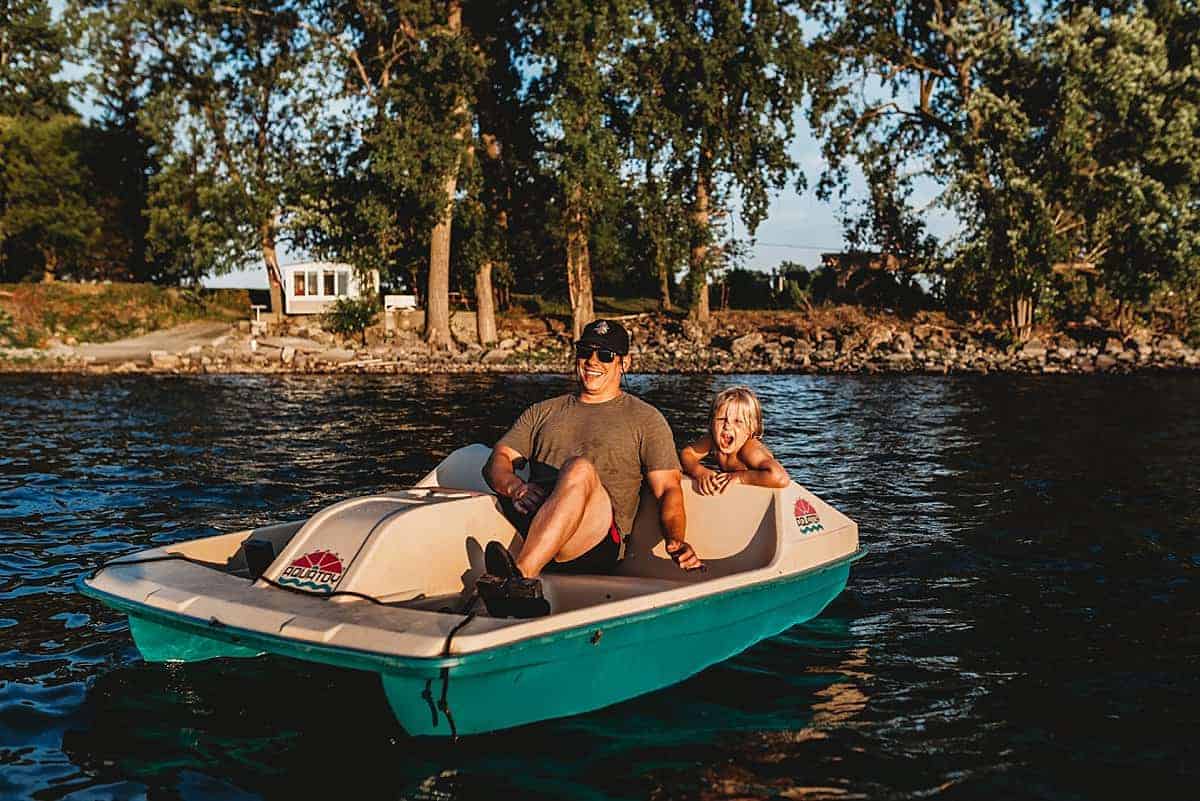
6.Yoga
While it may seem like a land activity (and it is), yoga can really be enjoyed anywhere, including on or near the water! You can do yoga on the beach, on docks at the lake, and even on a stand up paddleboard! We like to turn our paddleboard yoga session into a bit of a challenge. We’ll see who can get into certain poses without falling off the board or see who can hold specific poses the longest. There’s no shortage of laughter during that particular activity!
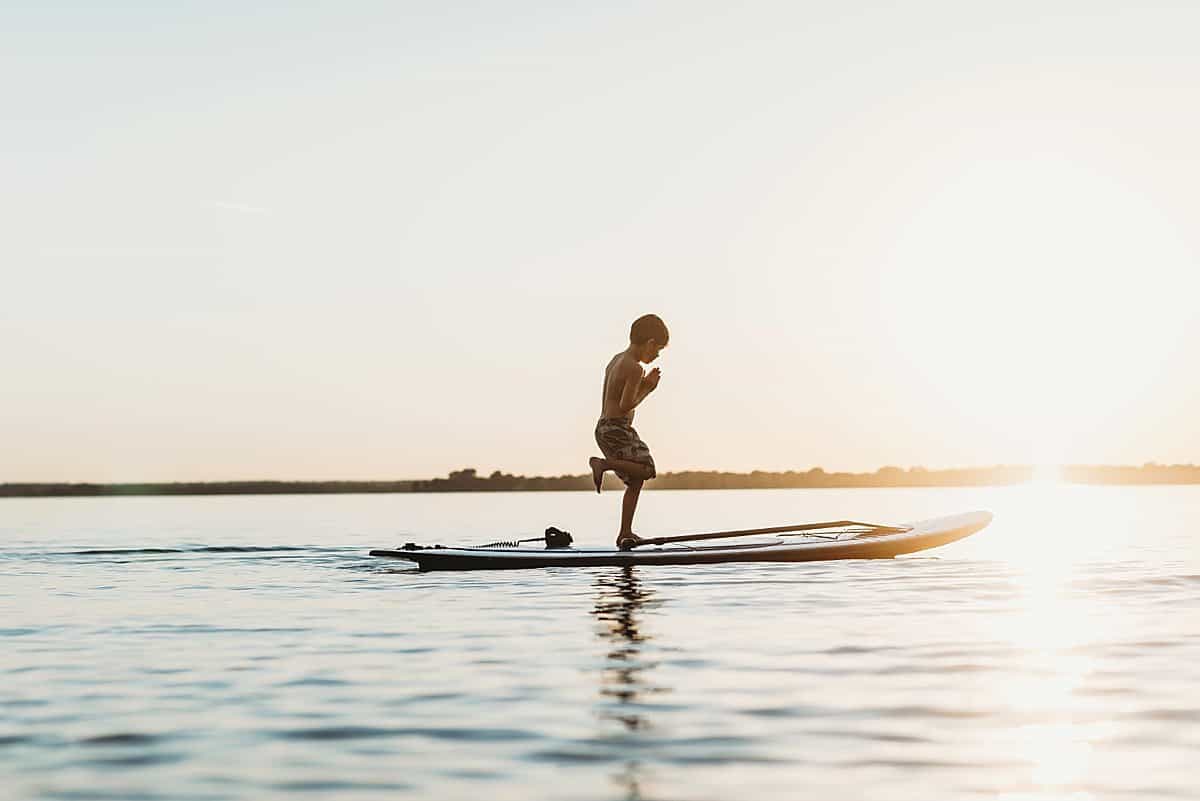
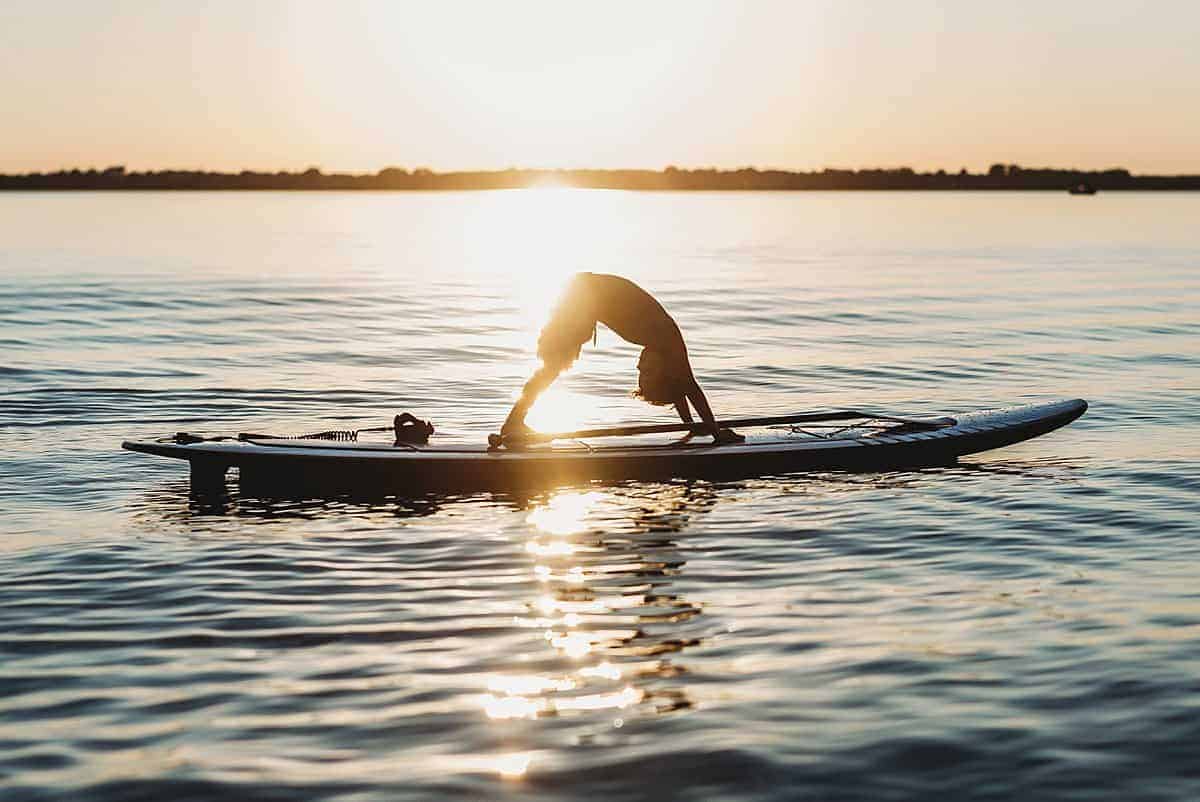
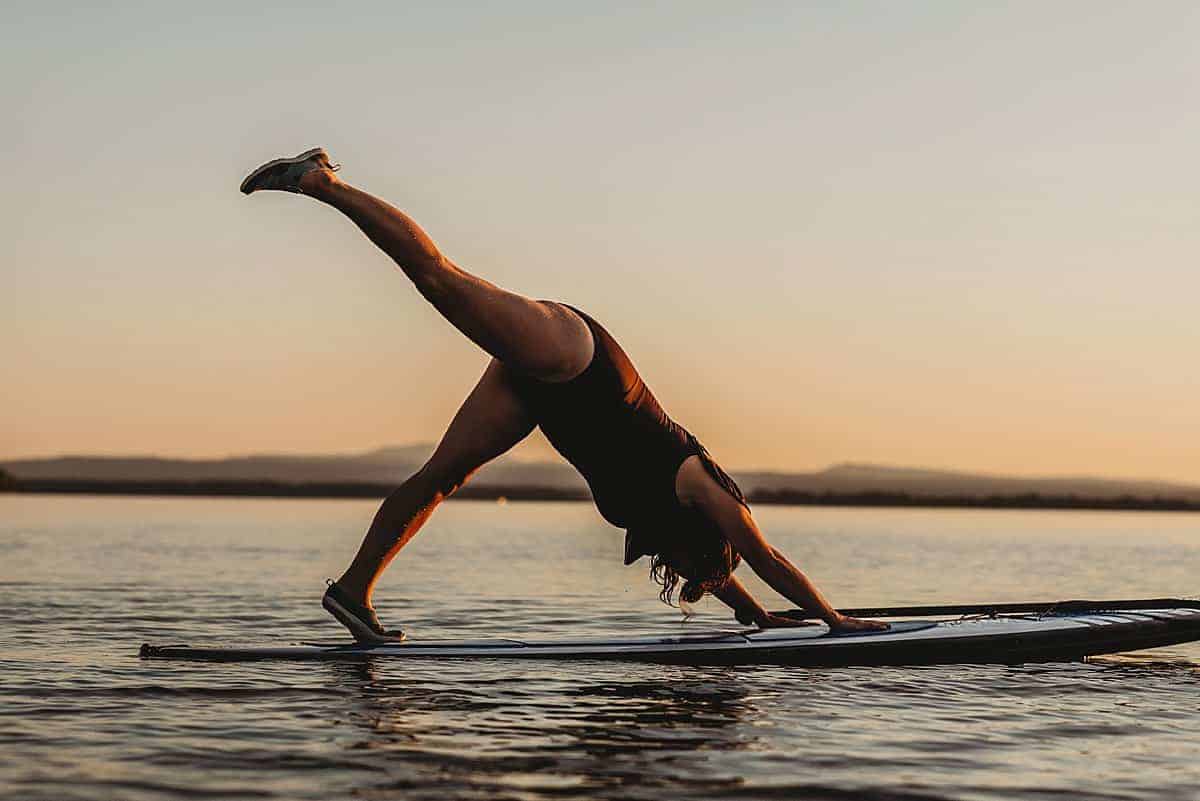
7. Skimboarding
Skimboarding is a fun outdoor summer water activity for kids that my boys have are just getting into this year! At the beginning of the summer, they saw some older guys using them at our beach and they didn’t stop talking about it until I finally broke down and got them a skimboard of their own. At 5 and 7, I wasn’t sure our kids would be old enough yet but they proved me wrong! They’ve had a ton of fun on that skimboard. It takes a lot of patience and coordination. Plus, it occupies them for hours.
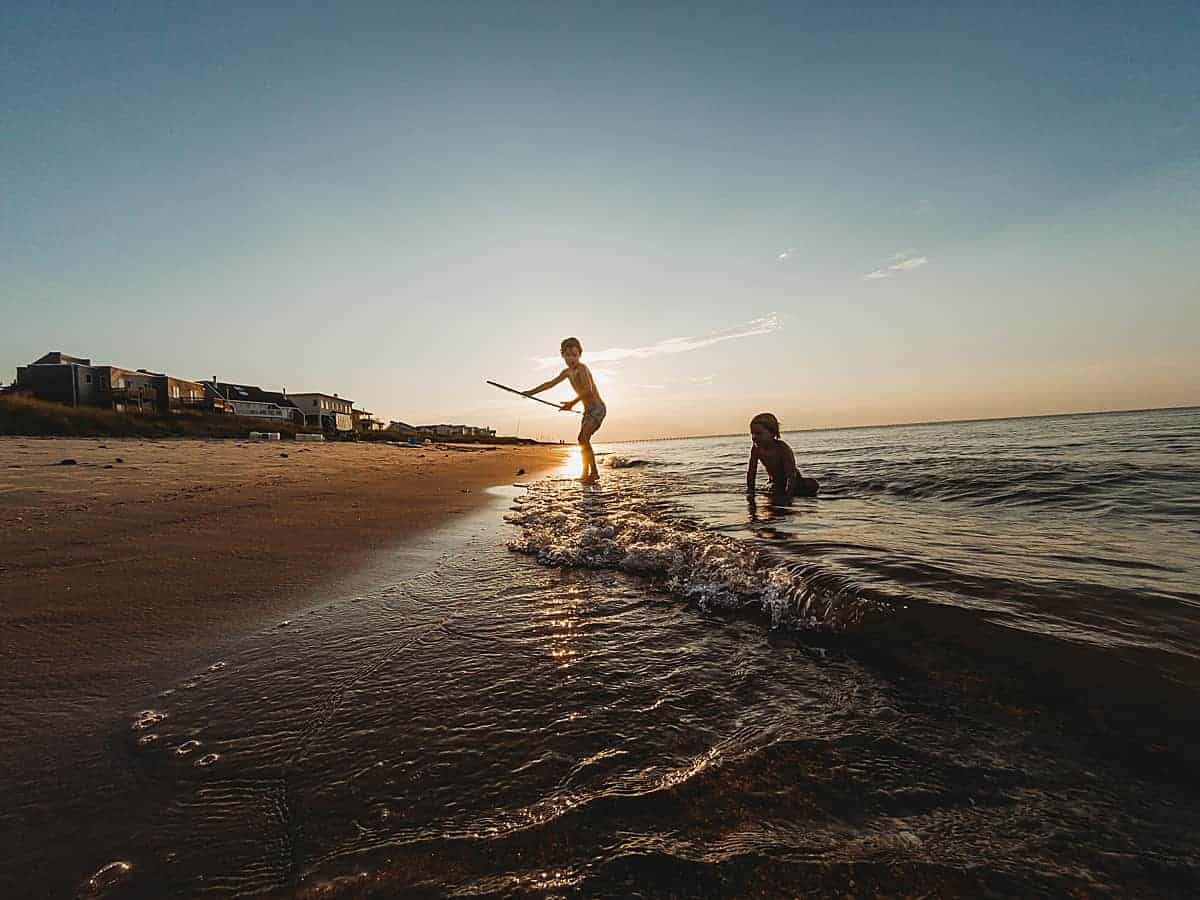

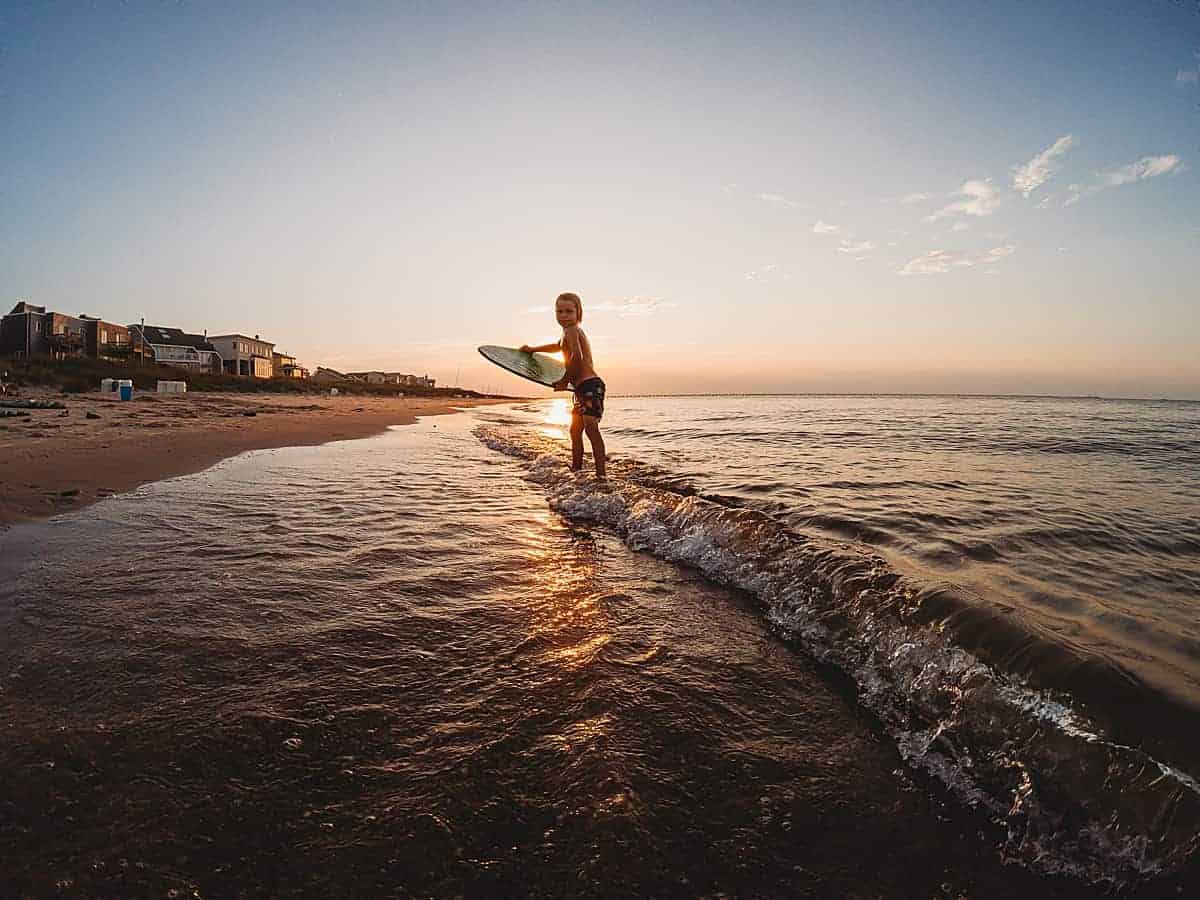

8. Dock jumping
Those of you living the lake life will be very familiar with this one! This activity has been a people pleaser for decades and will never get old. My kids can spend an entire day doing this and never get sick of it. Jumping off, swimming back to the dock, and then climbing up the ladder over and over for hours. Such a great way to enjoy a warm day while also getting lots of exercise. Like most everything else in our lives right now, the boys turn this into a competition to see who can jump the highest, furthest, or do the best trick.
We alternate between using the life vests when I’m not in the water with them and no life vests when I’m right there to assist if they get too tired to swim back to the dock unassisted. This activity was probably the best activity we’ve done all summer to help them learn to swim better. They made massive improvements in their swimming abilities after just an hour of jumping without the life vests and swimming back to the ladder! And I was right there to catch them or lend a hand if they needed a little extra help.

9. Surfing
Surfing is something that’s only just now popped up on our radar as our boys are getting older. Now that they’re better swimmers and have a great sense of balance on our paddleboards, we’re ready to add surfing to our list of favorite water activities for kids! I grew up in the mountains so I’ve never tried surfing before, but since we live on the ocean it’s time to give it shot. If you live in a beach area or plan to vacation to one, you’ll likely have access to a few places that offer surfing camps for kids and private lessons. Since our youngest isn’t quite old enough for the surfing camps yet, we decided to do private lessons as a family! I have a feeling that surf boards will be on our kids’ wish lists in the near future!

10. Climbing
If you’re in the mountains rather than on the coast, I highly recommend taking some time to adventure near waterfalls! My kids are fascinated by waterfalls because we don’t live in an area where you can find them. Whenever we head to the mountains they insist on going out to find some! Usually, you can also find some great spots nearby to climb rocks! We stick to small falls with fairly easy-to-navigate rock areas, since we’re not well-trained in rock climbing yet. When we get hot and sweaty from our climbing, we just find a little pool without fast-moving water to plunk down in and cool off! Please be warned – there is no shortage of beautiful rocks to take home in places like this, so you’re pockets and backpacks will get heavy!
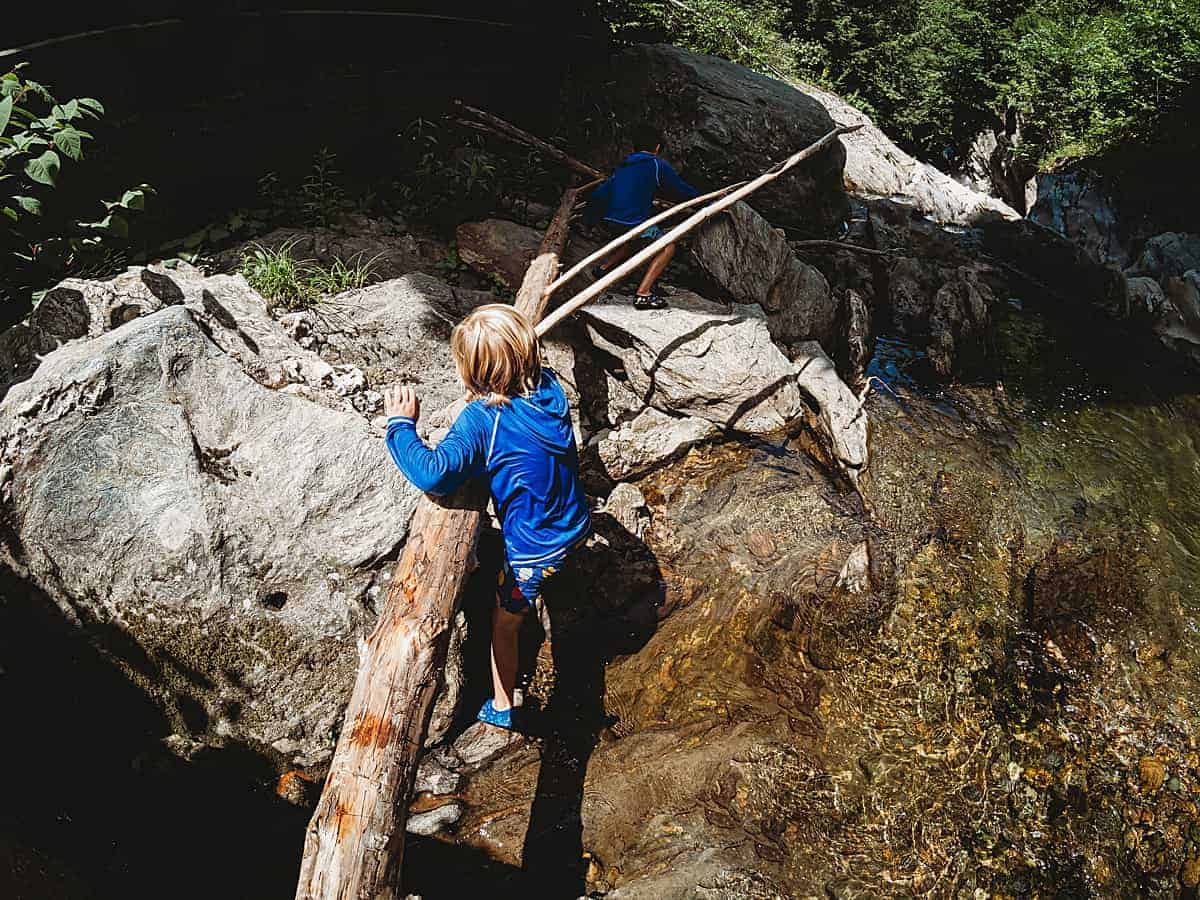
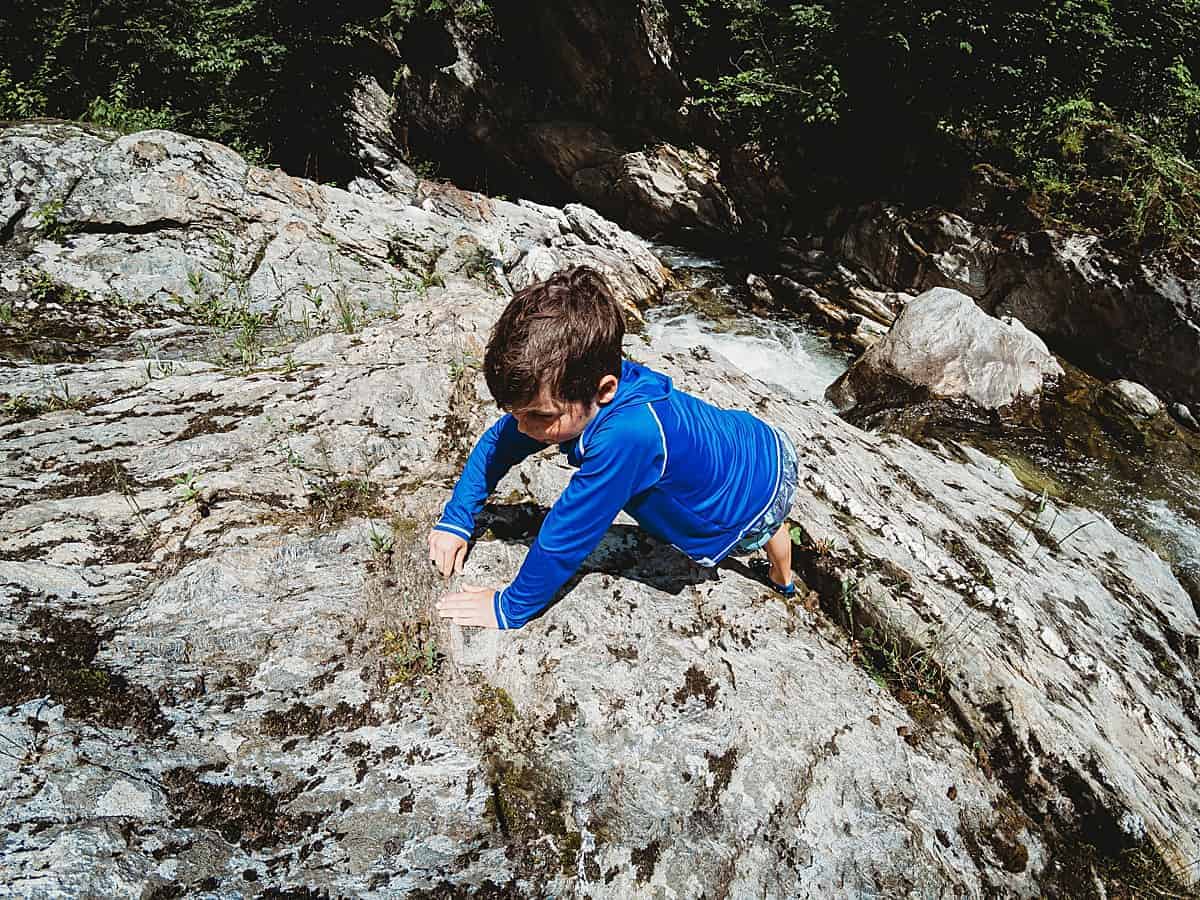
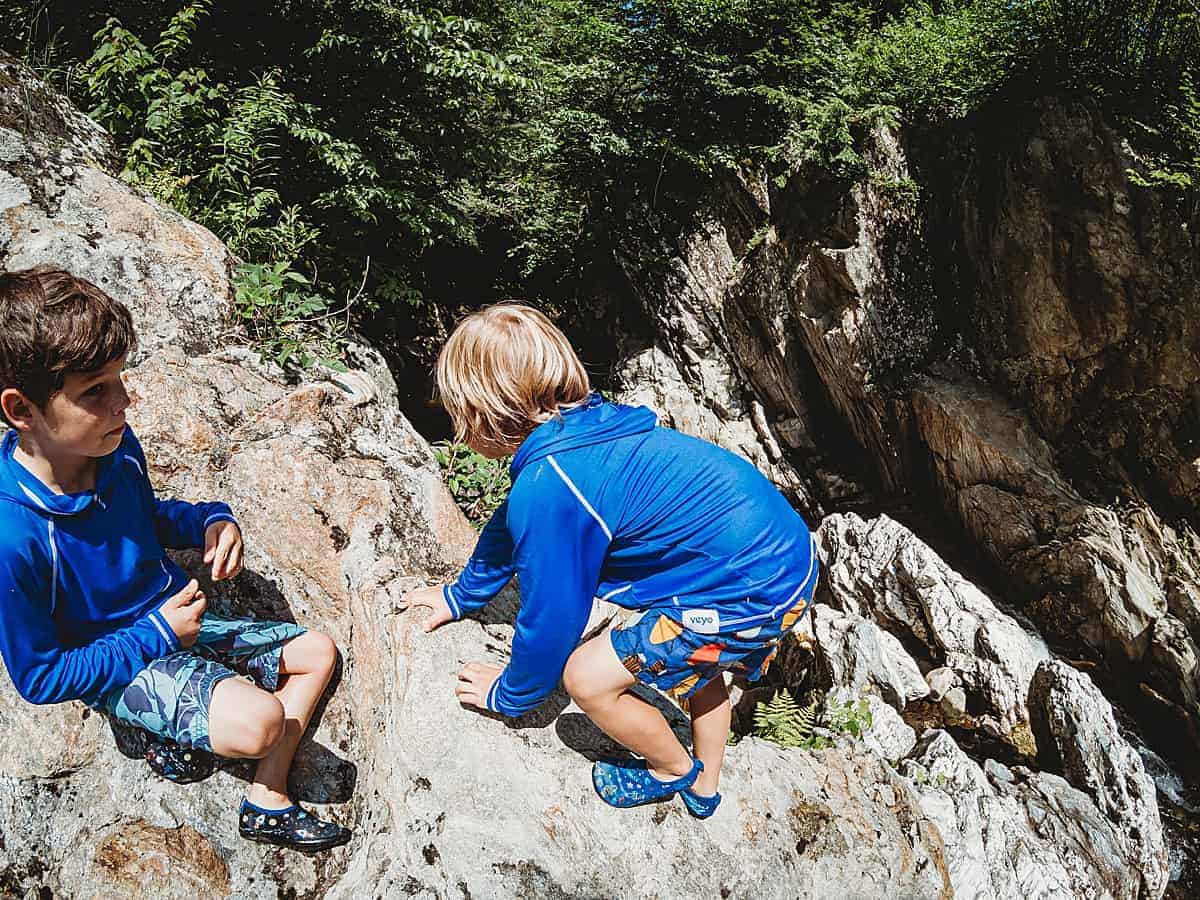
11. Canoeing or row boating
When it comes to being out on the water, you can really just assume that everyone will have a blast using any kind of boat. Kids love learning to paddle and are filled with pride when they’ve gained the skills to do it independently.
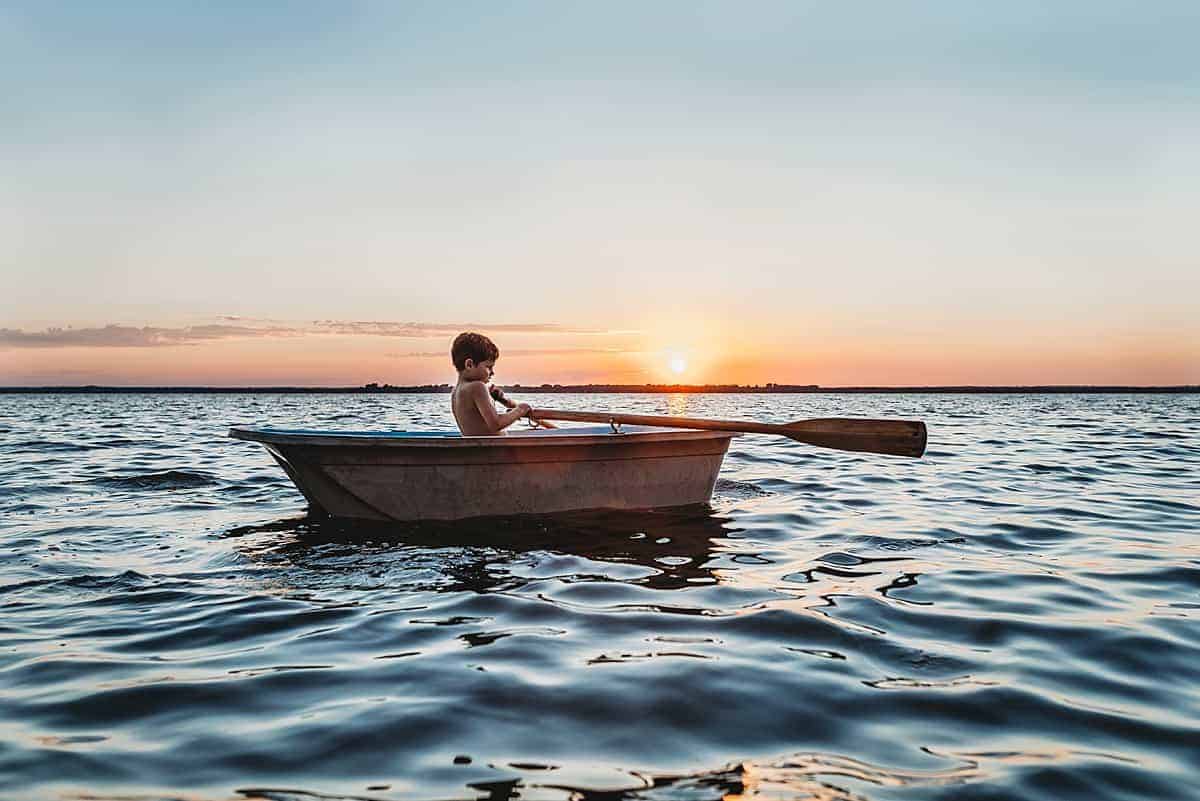
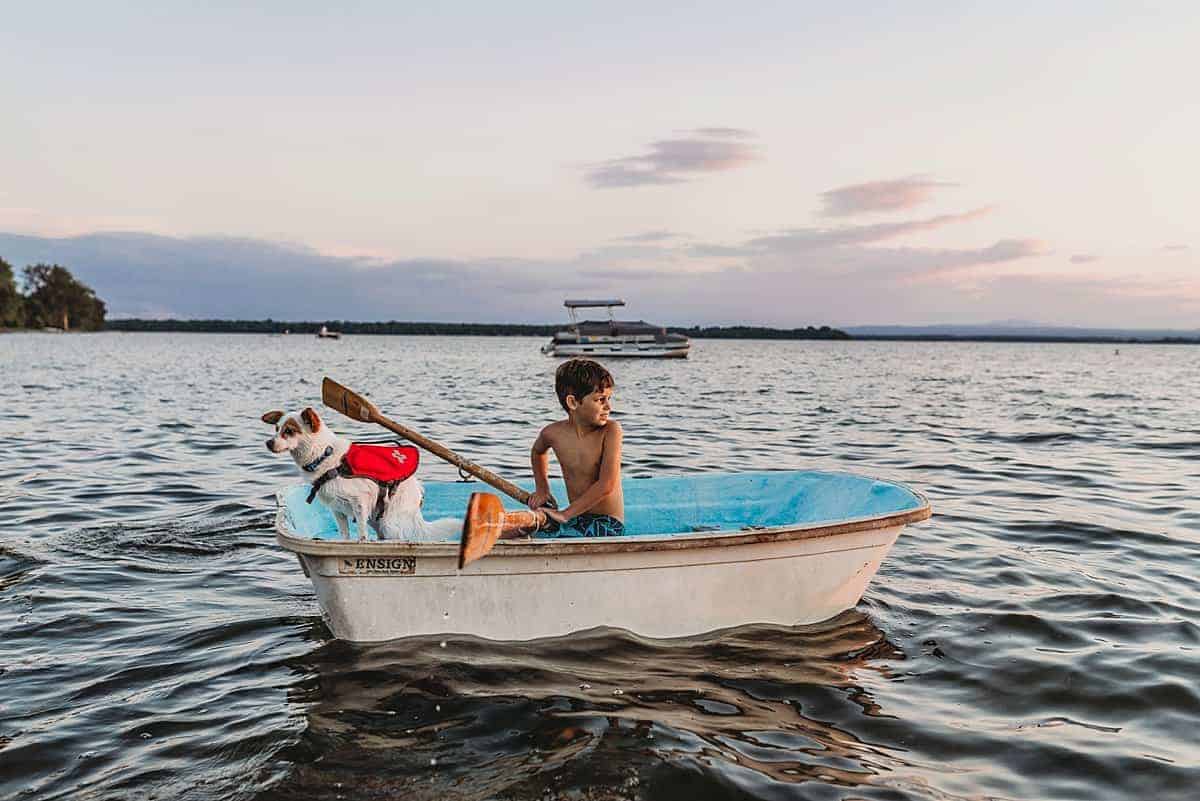
12. Go to a splash pad
For those of you who aren’t near nature-made splash areas, you can still have fun getting active in places like splash playgrounds or splash pads! More and more cities are building wonderful splash pads to run around in! These are especially great for families with babies and toddlers because you don’t have to worry about the water being too deep!
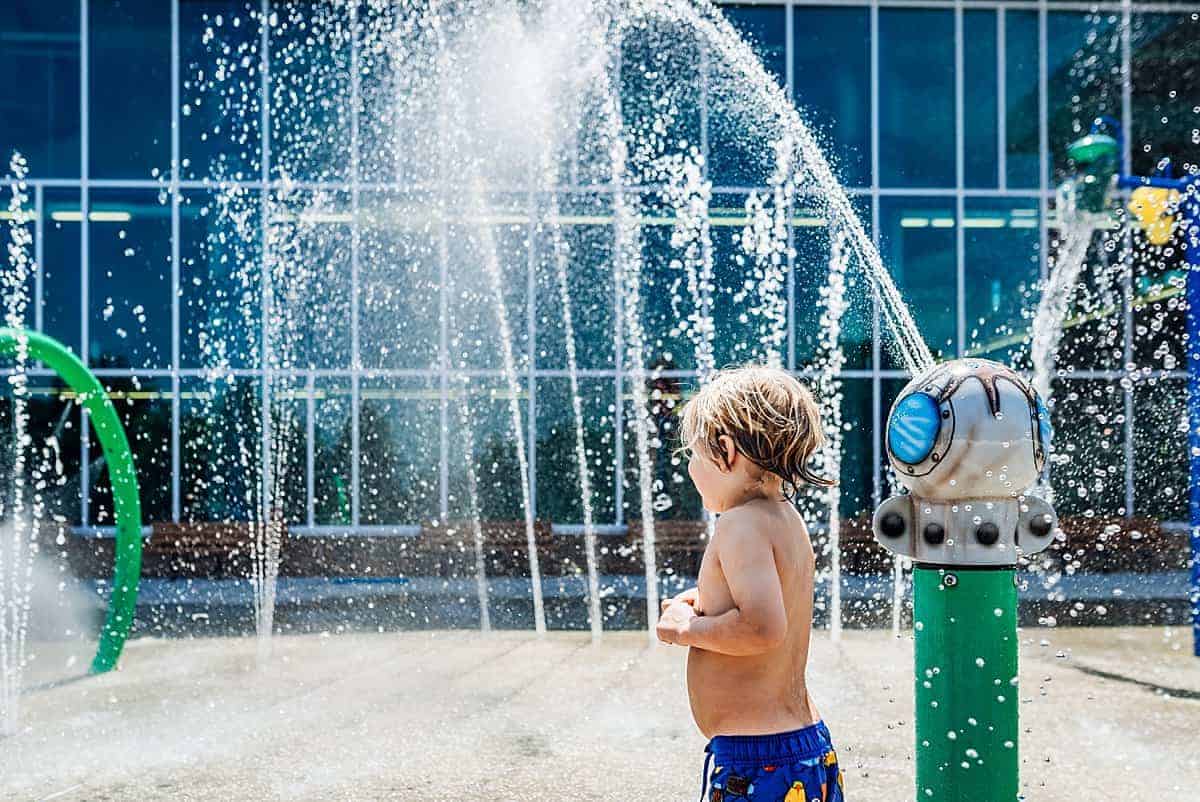
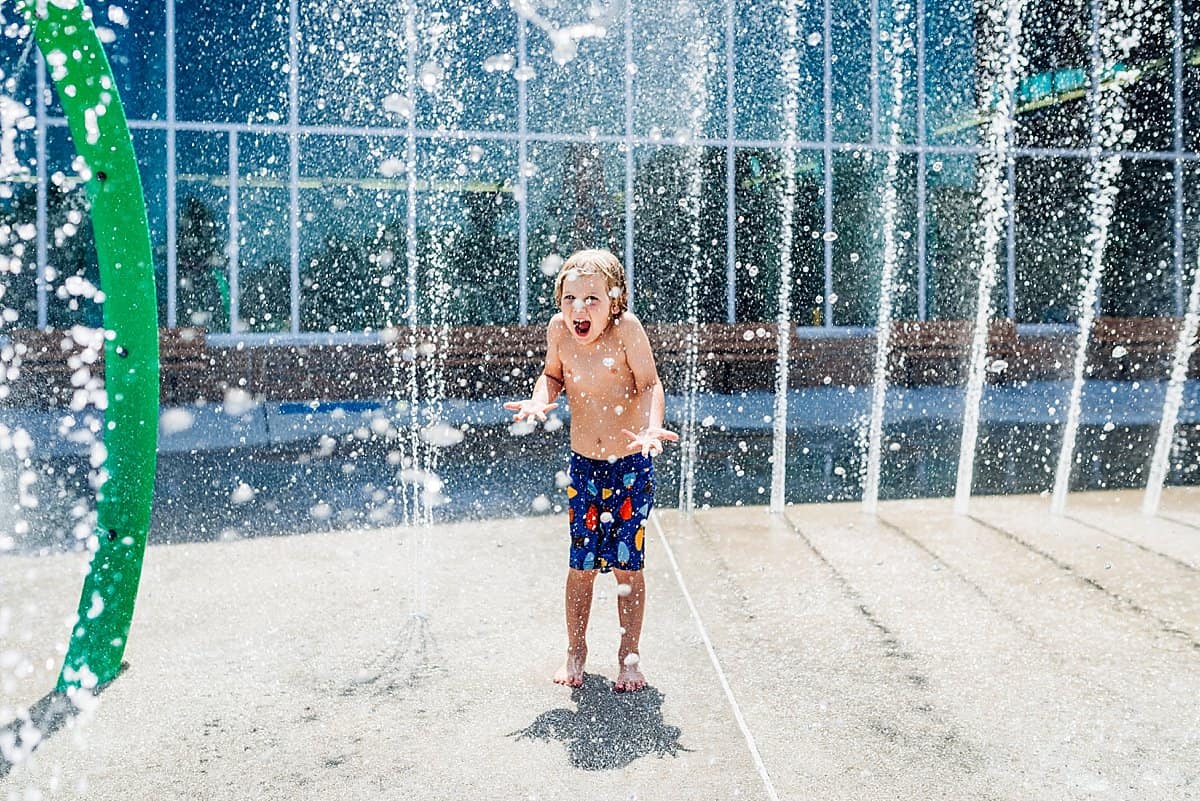
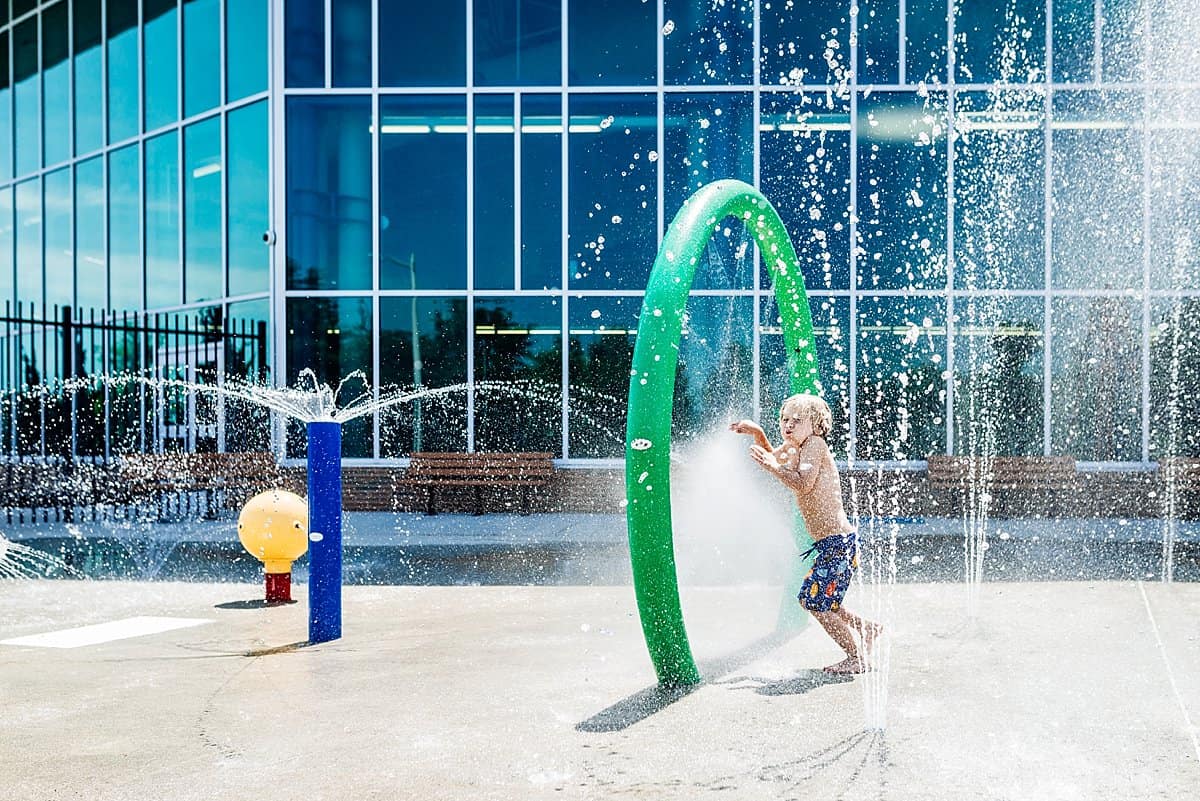
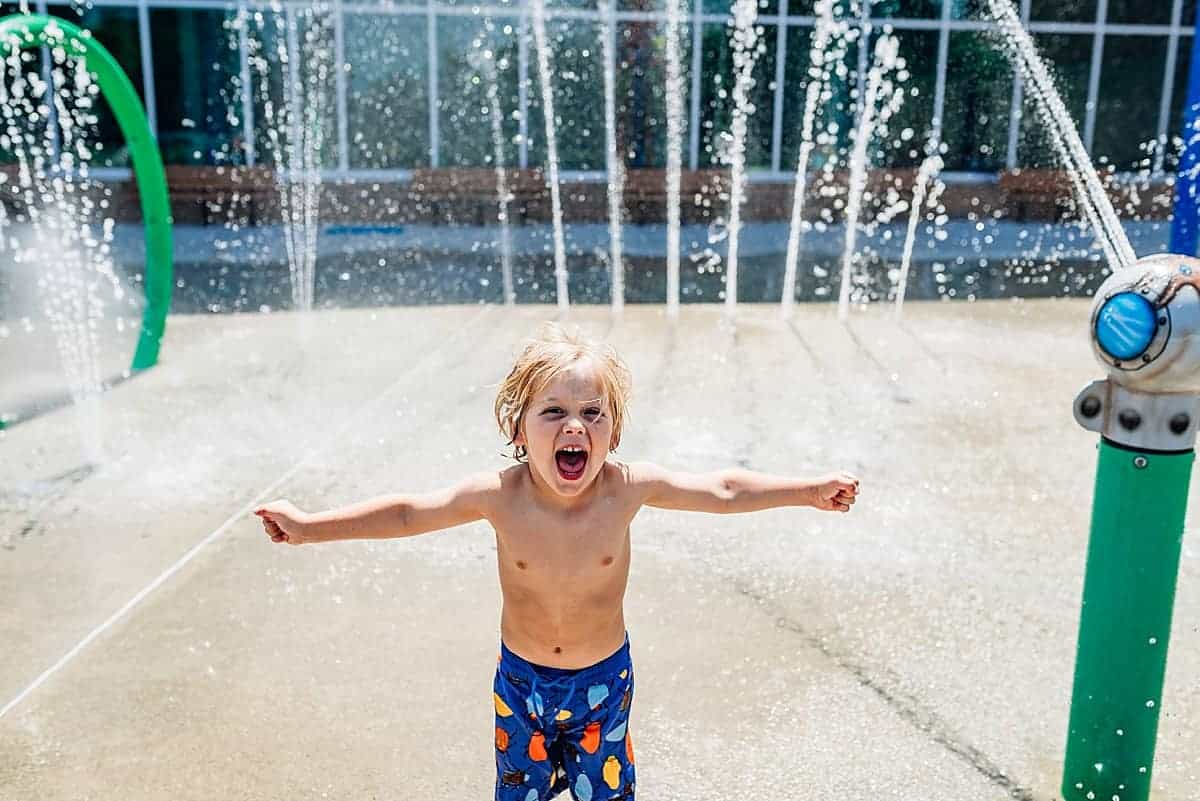
13. Go to a pool
Along those same lines, find a pool nearby! Both indoor and outdoor pools are a great way to spend some quality time with your family. My favorite thing about going to a pool is that I have to leave my phone behind! Once I jump in the water with the kids, they get some absolute undivided attention. It’s so refreshing and necessary!

14. Playing a sport
When you pack up your beach bag, add a soccer ball, football, or frisbee! Depending on where you’ll be and how many people will be there, you could also play volleyball or whiffle ball, too. Tossing a ball back and forth in the water is actually one of my very favorite things to do with my kids. We can keep cool by being waist-deep, connect with each other, and practice hand-eye coordination. You can purchase some fantastic frisbees and balls made specifically for water. We LOVE these. They soak up water and then splash it all over when you toss them. It’s tons of fun!
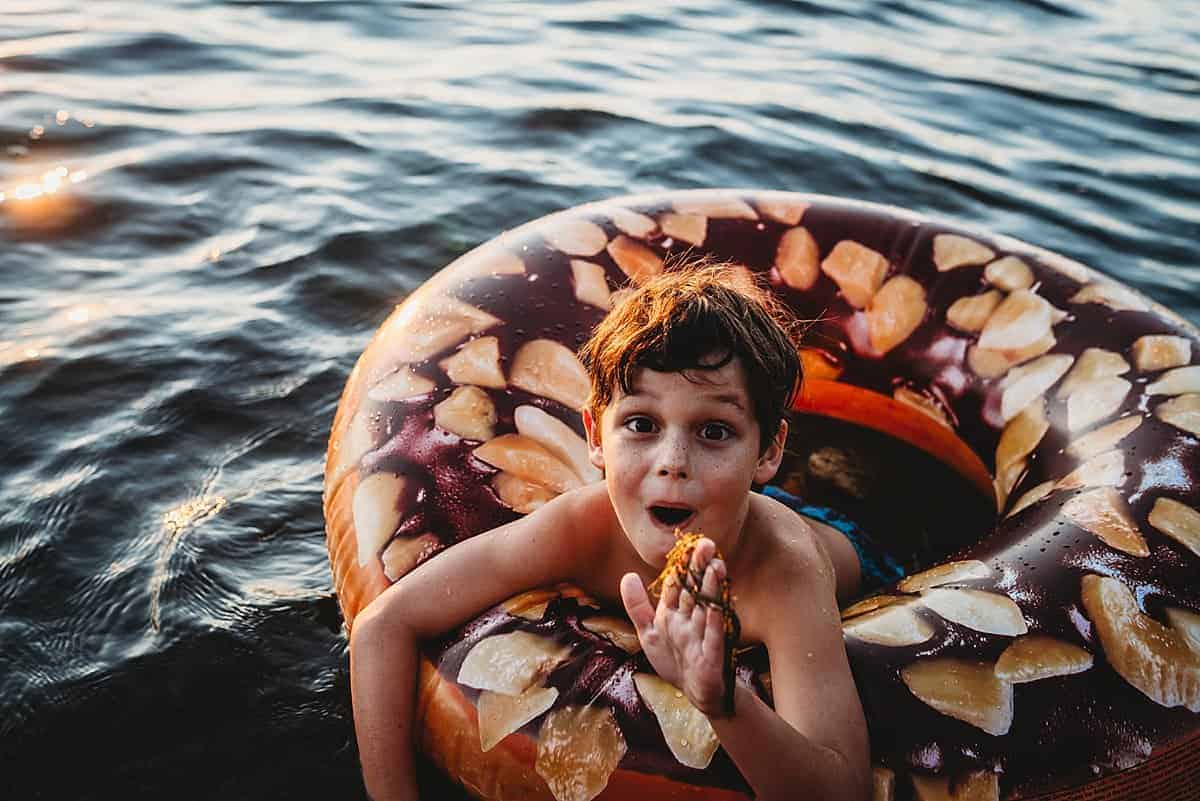
15. JUST PLAY!
My final suggestion is to just jump in and play anywhere there’s water! You can swim around, play on floats, use kickboards or boogie boards, or dive to the bottom to find treasures. Anything you do in the water together will be fun and your children will appreciate the quality time with you! You honestly don’t need to rent or purchase any of the fancy stuff I mentioned above to enjoy water activities with kids. Splash around with your family and make some summer memories that will last a lifetime!


